44 Powerful Problem Solving Activities for Kids
This post and its photos may contain affiliate links, view our disclosure policy.

Inside: Tons of activities that will help boost kids’ problem-solving skills and make them super critical thinkers!
Table of Contents
Who doesn’t love a little challenge now and then? Especially if it’s for our kiddos!
You see, problem-solving isn’t just for the puzzles and math sheets. It’s the magic stuff that shapes our little ones into big thinkers and doers.
Yep, it’s pretty important!
With the right activities, we aren’t just sharpening kids’ brain muscles; we’re also enhancing their creativity, boosting their confidence and critical thinking skills, and (just maybe) buying ourselves five minutes to sip that coffee while it’s still hot.
Stick around, and let’s dive into 44 simple activities to boost your child’s problem-solving skills while having a blast! 🚀💡


Gain access to our library of free printables!
Because we all want our kids to be happy and healthy — not just for right now, but for the rest of their lives.
Why is it Important to Learn Problem-Solving Strategies?
Importance of problem-solving abilities:
Navigating the maze of life requires many skills; it requires the ability to face challenges, find solutions, and adapt.
This is where problem-solving enters the picture, and here’s why it’s so crucial for our kiddos:
Life is Full of Puzzles: From tying shoes to understanding a new math concept, life constantly presents us with puzzles. Equipping our children with problem-solving skills ensures they can tackle each one confidently.
Boosts Independence: As parents or educators, we won’t always be there to hand-hold. When kids can solve problems on their own, they gain a sense of independence, which is essential for their personal growth.
Develops Resilience: Not every attempt to solve a problem will be successful. But with each try, children learn resilience, understanding that it’s okay to fail and important to try again.
Prepares for Real-World Challenges: The real world isn’t a scripted playground. It’s unpredictable. By honing their problem-solving abilities, we’re preparing kids to face the unforeseen challenges of the world outside.
Enhances Cognitive Growth: Otherwise known as cognitive development. Problem-solving isn’t just about finding solutions. It’s about thinking critically, analyzing situations, and making decisions. This cognitive workout helps in the overall brain development of our children.

Fosters Creativity: There’s often more than one way to solve a problem. Encouraging kids to think outside the box helps them see things from different perspectives and nurtures their creative spirit, letting them see possibilities where others might see roadblocks.
Encourages Adaptability: In the face of challenges, it’s important not just to find solutions but to be adaptable. As the world changes, kids with strong problem-solving skills can change with it, learning and growing along the way.
Builds Confidence : Every problem solved is a victory, a testament to their capabilities. This builds a child’s self-esteem, making them believe in their ability to face and overcome obstacles.
So, while it may seem like just another skill on the list, problem-solving is a cornerstone for a well-rounded, resilient, and successful individual.
4 Simple Problem-Solving Steps We Should Know at a Young Age
Problem-solving steps can be thought of as the building blocks for tackling challenges.
They’re like a set of instructions that guide us on our journey to finding different solutions. These steps provide a roadmap for kids, helping them break down big problems into smaller, more manageable pieces.
By following these steps, children can learn how to think critically, make smart decisions, and even discover their own creative problem-solving superpowers.
- First, we need to understand the problem, just like examining the pieces before we start building.
- Next, we brainstorm – this is where we think of different solutions, like trying out various block combinations. Then comes the important part – evaluating the options. We must determine the best solution , just like choosing the right blocks for our structure.
- After that, it’s time to put the plan into action, just like assembling the blocks to create something amazing.
- Finally, we review and see if our solution works, making adjustments if needed.

These problem-solving steps are like our trusty toolkit, helping us build our way to success with creativity and ingenuity.
Whether it’s figuring out a math puzzle, resolving a conflict with a friend, or coming up with a new game, these problem-solving steps will be a guide to helping kids take their next steps.

Featured resource
HeartSmart Social Emotional Curriculum
If you want a program that guides you on how to teach problem-solving along with other essential skills like self-regulation, respect, teamwork, conflict resolution, and more, check this out!
Best Problem-Solving Activities for Kids
In this guide, we have a cool mix of fun problem-solving activities. There are activities for inside, outside, playing in groups, and even on the computer! So take deep breaths, and let’s get to it!
44 Problem-Solving Activities for Kids
Problem-solving games for kids:, card games:.
These are more than just fun; they are brain boosters. In Go Fish , the hunt for matching cards sharpens memory. While in the classic game Uno , it’s all about plotting the right move to take the lead.

The Memory Game:
This game isn’t just about remembering; it’s about strategizing. Matching pairs means we’re not just recalling but also paying close attention. This boosts concentration, focus, and, of course, memory – essential skills for everyday challenges!
Try this animal matching memory game.
Classic Board Games:
Whether it’s Chess , where every move counts, or Monopoly , where every decision can make or break your game, these games teach foresight and strategy.

Maze Games :
Navigating a maze isn’t just about reaching the end; it’s about strategizing the route. These games enhance our ability to plan and foresee, invaluable skills in real-life situations.
Brain-Teasing Sudoku :
Sudoku isn’t merely filling in numbers; it’s about using logic to deduce the correct sequence.
Tangram Puzzles:
These aren’t your average puzzles. With Tangram, you shape a story, crafting images using geometric pieces.
Chess & Strategy-Based Games:
Think of these as mental workouts. Here, every step is a calculated decision, honing your ability to think multiple steps ahead.
For more fun:
- 20 Best Games for 4-Year-Olds
- 15 Board Games Every 9-Year-Old Will Love
Indoor Problem-Solving Activities for Kids
Complete simple tasks:.
Simple tasks are little jobs that you can do to practice problem-solving.
- Matching Socks: Sort through a pile of laundry to pair up matching socks.
- Grocery List Planning: Help create a list for the week’s meals, considering everyone’s preferences.
- Toy Organization: Sort toys into designated bins by type, size, or color.
- Packing Their School Bag: Ensure they have all the necessary items for the next school day.
- Setting the Table: Consider where each plate, fork, and glass should go.
Ask Open-Ended Questions:
Open-ended questions are special questions that don’t have just one answer. They make you think! For instance, instead of asking, “What color is the sky?” you might ask, “Why do you think the sky changes colors?”
Puzzle Games:
Try simple puzzles with fewer pieces for younger kids and more complex puzzles with more pieces for older kids! You figure out how to fit the pieces together, which helps your brain get stronger!
Puzzle games are also great for hand-eye coordination!
Pattern Recognition:
This is all about finding the special patterns in things. Imagine a puzzle with colors or shapes. You have to figure out the pattern to solve it.
Dress-Up and Role-Play:
When you dress up and pretend to be someone else, it’s like stepping into their shoes. You have to think about how they would act and problem-solve what they would say if you were them.
Shape Sorters:
Shape sorters are super fun for young kids. You have to match each shape to the right hole. It’s like a puzzle for shapes! This helps you learn about different shapes and how they fit together.
Building Challenges:
Use Wooden blocks or legos and give kids a theme or structure to replicate. Great for all age groups!

Cooking or Baking:
Cooking and baking are like yummy science experiments! You follow recipes, mix ingredients, and even get to taste your creations. You must figure out how to follow and “solve” the recipe so that your creation tastes delicious!
“What If?” Scenarios:
Present hypothetical situations (e.g., “What if you were invisible for a day?”) and discuss possible solutions or actions.
Homemade Science Experiments:
Homemade science experiments are like being a scientist in your own lab! You get to try out cool experiments and discover how things work.
Quick Experiment example:
Make Dancing Raisins:
- Clear soda (like Sprite or 7-Up)
- A clear glass
- Fill the glass with the soda.
- Drop a few raisins into the glass.
Result: The raisins will initially sink, then start “dancing” up and down due to the carbon dioxide bubbles attaching and detaching from them.
Coding Activities:
Coding is like giving a computer a set of clues to follow. Think of it as telling a story where the computer plays the main character, and your instructions guide its every move. It’s our way of communicating with machines to make them do amazing tasks!
Crossword Puzzles:
Crossword puzzles are fun little word challenges. You must fill in the blanks with the right words and use your smarts to solve tricky clues!
Complex Problems like Brain Teasers:
Brain teasers are like mental gymnastics, making you stretch and flex your thinking muscles. What’s fun about them? There’s often more than one way to reach an answer, so your imagination and logic both get a workout!
Goal Setting Activities:
Goal setting is like making a special plan for what you want to achieve.
Think of goal setting as charting out your very own treasure map, with no wrong answers!
By laying out what you aim to achieve, you’re setting the course toward your treasure: success!
Goals, be they immediate or down the road, act like our personal compasses. They keep you on track and motivated. And every time you hit a goal? That’s you cracking a code and unlocking a new achievement in your adventure!

Setting SMART Goals
This engaging kit focuses on teaching essential skills for setting and achieving smart goals, just like breaking down that LEGO set into manageable sections. We help kids understand the importance of clear objectives, staying motivated, overcoming obstacles, embracing adaptability and more.
Math Challenges:
Think of math challenges as your brain’s personal gym session. These aren’t just any puzzles; they’re crafted to push those thinking caps to the limit.
Debates (Best for older children):
Debates are friendly arguments where you defend your ideas with strong reasons. They’re excellent for problem-solving and for our social skills because they teach us how to think critically and consider different viewpoints. By defending our thoughts in a debate, we learn how to express ourselves clearly, listen to others, and find strong arguments to support our ideas!
Use Worksheets (Teach the Size of the Problem Concepts)
Teach concepts like the size of the problem to help kids determine if their reactions to problems are appropriate and what suitable solutions might be. Use fun visuals and problem-solving worksheets.
You can get this worksheet and more in our HeartSmart curriculum.

STEM Challenges:
STEM challenges are games that use science, technology, engineering, and math to solve problems. They’re awesome for problem-solving because they let us be like inventors and builders. Kids can engage in creative play and design and create things, like bridges or machines, using our smarts and creativity.
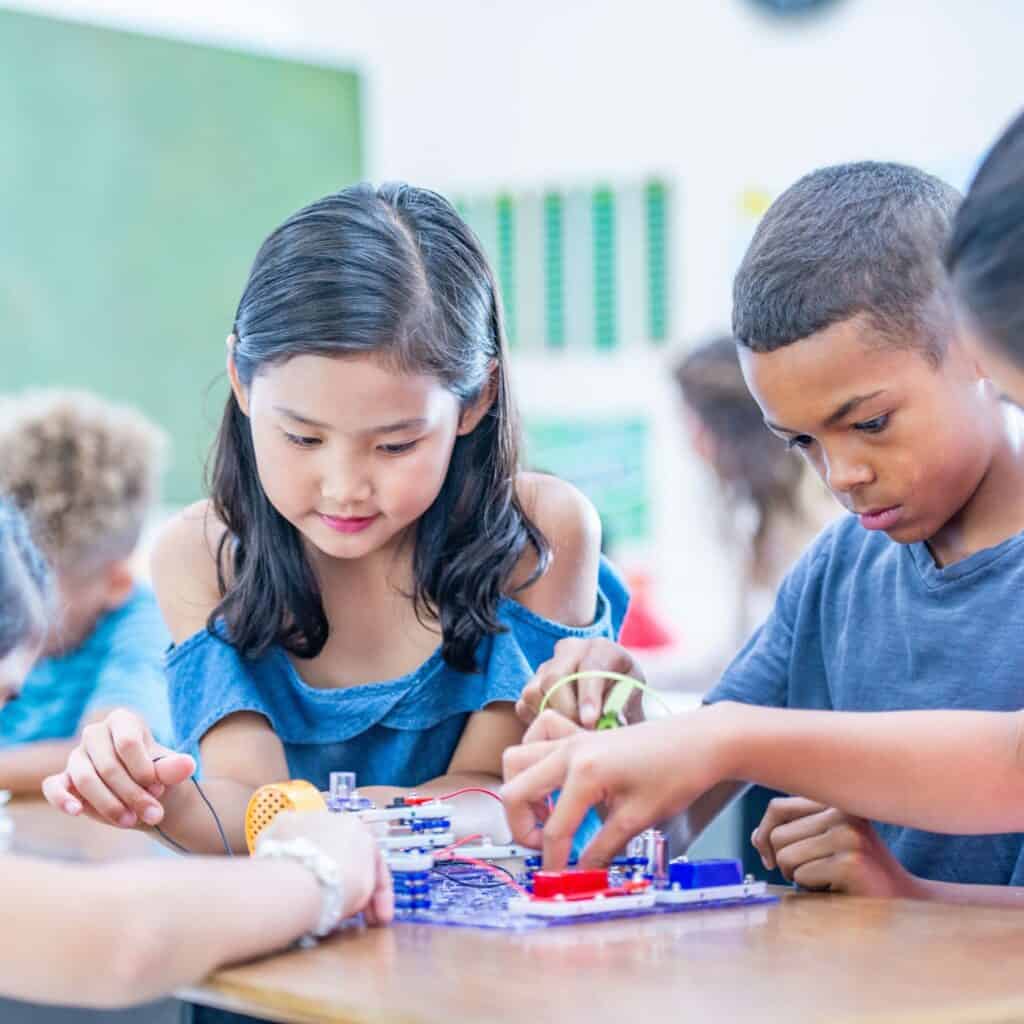
Outdoor Problem-Solving Activities for Kids
Nature scavenger hunt or treasure hunt: .
Create a list of natural items for kids to find. For added difficulty, give riddles as clues.
We have some awesome free Scavenger Hunt Bundles you can snag!

Free Scavenger Hunt Bundle
Download this set now, which includes four unique scavenger hunt games
Outdoor Obstacle Course:
Use items like ropes, cones, and hula hoops to design a course that requires navigation.
Garden Planning & Planting :
Design a garden patch, deciding what to plant based on sunlight and spacing needs.
Map & Compass Orienteering:
Teach kids to use a map and compass, then set waypoints for them to find.
Water Relay Challenges:
Carry water from one bucket to another using a sponge or cup, navigating hurdles.

Campsite Setup Simulation Challenge:
Set up a mock campsite considering factors like wind direction, incline, and resource proximity.
Nature Art & Patterns:
Using twigs, leaves, stones, and more, create mosaic patterns or depictions.
Group Problem-Solving Activities for Kids
Tower of spaghetti:.
Using only spaghetti and marshmallows, groups compete to build the tallest stable tower.
Egg Drop Challenge:
Groups are provided with a set of materials (e.g., straws, tape, cotton) to create a protective casing for an egg, which is then dropped from a height.
Silent Line-Up:
Without speaking, kids must line up according to their birthdays or another criterion.
Group Story Time:
One child starts a story with a sentence or two, and each subsequent child adds on, weaving in unexpected twists and turns.

The Human Knot:
Kids stand in a circle, reach across, and grasp two different hands. The challenge is to untangle the knot without releasing hands.
Escape Room:
Everyone is ‘locked’ in a themed room and has to solve a series of clues and puzzles to ‘escape’ within a set time. It’s fantastic for problem-solving because it challenges critical thinking, teamwork, and creativity. Everyone must work together, think outside the box, and use their wits to solve the puzzles and complete the mission before time runs out!
Role-Playing Social Situations:
Role-playing helps you practice how to react and solve problems in different situations. Present the group with a fictional but realistic scenario (e.g., stranded on an island) and brainstorm and act out solutions.
By pretending to be in different roles, you can figure out the best ways to communicate, understand others, and find solutions to problems in a safe and fun way!
Blindfolded Obstacle Course:
In pairs, one blindfolded child is guided through an obstacle course by their partner using only verbal instructions.
Online and App-Based Problem Solving Activities
When tech meets intellect, the digital realm becomes a treasure trove of problem-solving wonder!
Educational Apps:
Best Apps by Age:
- Younger Kids : Dive into the mathematical world with “Moose Math” or kick-start programming concepts playfully with “Bee-Bot.”
- Older Kids: Amp up programming skills with “Cargo-Bot” or embark on a critical thinking journey with “Rush: A Disney Pixar Adventure.”

Online Escape Rooms:
Just like physical escape rooms, but from the comfort of your home! They’re digital adventures, demanding clues to be solved to advance to the next level.
Check out these 10 Family Friendly Online Escape rooms here! I’m especially looking forward to Hogwarts Harry Potter Escape Room .
Virtual Logic Puzzles:
Websites that present logic problems and puzzles, leveling up in complexity as kids solve them.
Top Picks: “Conceptis Puzzles,” “Math Playground Logic Games.”
Benefits: Perfect for sharpening deductive reasoning and pattern recognition.
Interactive E-Books:
These are not your everyday e-books. They demand interaction, choices, and decision-making to progress the story.
Suggestions: “This Book is Perfect” or I love this big list of the best interactive books for kids.
Benefits: Enhance comprehension, decision-making, and experience of how choices shape outcomes.
Online Strategy Games:
These games demand planning, strategic thinking, and foresight.
Check out: “Fish Sticks Strategy Game”
Benefits: Apart from being immensely fun, they teach patience, strategy formulation, and long-term planning.
10 Examples of Problem-Solving Skills Young Children Should Have
Each of these skills not only helps kids tackle problems effectively but also equips them with abilities they’ll use throughout their lives.

- Critical Thinking: Encourage young thinkers to examine situations, ask questions, and view things from different angles before reaching a conclusion.
- Decision-Making Skills: Help children practice making choices by offering them options and discussing the potential outcomes of each decision.
- Creative Thinking: Cultivate creativity by providing opportunities for imaginative play, artistic expression, and activities that encourage thinking outside the box.
- Communication Skills: Show children how to express their thoughts, feelings , and ideas clearly and effectively – a vital skill for problem-solving in social situations.
- Teamwork and Collaboration: Foster the spirit of cooperation by encouraging children to work together on group activities or projects, which helps develop problem-solving skills as a team.
- Resourcefulness: Challenge children to find alternative solutions using the available resources rather than relying solely on adult guidance.
- Flexibility and Adaptability: Teach children how to adapt to changes and unexpected situations, which is crucial for effective problem-solving in real-world scenarios.
- Persistence: Staying determined, even when faced with challenges, and continuing to try until a solution is found.
- Self-reflection: Recognizing one’s own mistakes or misunderstandings in a situation and learning from them for future problem-solving.
- Active Listening: Paying close attention to details when others speak, helping them understand problems more fully and respond effectively.
Must read post:
How to Help Kids with Inflexible Thinking THRIVE
Tips for Parents and Educators: Nurturing Problem-Solving in Kids
When it comes to fostering problem-solving skills in children, both parents and educators play pivotal roles. It’s less about giving the right answers and more about asking the right questions.
Encourage Curiosity. Let kids explore questions like, “What do you think would happen if…?” or “How would you do it differently next time?”.
Embracing mistakes as learning opportunities can be a game-changer.
Set Up Scenarios. Create environments or situations where kids can think and act independently. Whether it’s setting up a puzzle station at home or a role-play corner in the classroom, these controlled scenarios can stimulate their problem-solving faculties. Remember, it’s okay for them to struggle a bit. It’s through overcoming challenges that real learning occurs.
Lastly, Be a Guide, Not a Director. Instead of directing them step-by-step, guide them by providing hints or asking probing questions. This helps them develop the ability to analyze situations and think critically. As they grow, they’ll be more equipped to approach challenges with confidence and creativity.
So, whether you’re a parent or an educator, remember that each day presents countless opportunities to bolster these invaluable skills. Embrace them!
Final Thoughts: Problem Solving Activities for Kids
Being a pro at problem-solving helps us face all types of curveballs life throws at us.
From untangling math puzzles to making big decisions, this skill is our trusty sidekick. And when life changes? No sweat! We can adapt and shine.
In short, mastering problem-solving helps us face challenges, make wise choices, and truly succeed in whatever we tackle!
I hope you enjoyed these problem-solving activities for kids. Tell me, what one is your favorite?

Because we all want our kids to be happy and healthy — not just for right now, but for the rest of their lives.
Tina Williamson is the published author of the growth mindset activity journal for kids - “ Amazing Me ” and the writer and founder here at Mindfulmazing. Passionate about raising mindful, resilient, and compassionate kids we are committed to sharing calming strategies, positive parenting tips, and growth mindset resources. Our resources are now used in over 10,000 homes, schools and counseling offices! Visit the shop here.
Resources You’ll Love
Our shop is filled with printable resources to help you calm the chaos and assist your amazing little humans to believe in the amazing little humans they are!

Calm Down Corner Bundle

Mindful Minute

Feelings Fun Kit

Social Story Bundle

Spring SEL Resources
Now available on tpt.
Splash into spring with these spring-themed social-emotional learning activities
Connect with other parents + teachers
Love this article? Make sure to connect with me on your favorite social platform below, and leave a comment so we can chat!
Leave a Reply Cancel reply
Your email address will not be published. Required fields are marked *
Similar Posts

Free Printable Winter Coloring Bookmarks

The BEST Kindness Activities for Elementary Kids (Engaging + Fun)

11 Unique Ways To Encourage Kids to Dream BIG PLUS 20 Dream Big Quotes!

The 10 Best Fidget Toys for School and Home

25 Free Printable Halloween Bingo Cards for Kids

13 Things Happy People Don’t Do
We are passionate about raising mindful, resilient, happy kids.
Our resources are now being used in thousands of homes and classrooms around the world! Welcome to the community.
$$ Bundle & Save $$
Your One-Stop Shop for All Your Kids’ Social-Emotional Needs!

Mega Emotions Super Bundle

Calming Corner Bundle

Growth Mindset Bestsellers Bundle

HeartSmart SEL Program

Amazing Me Journal now available!

Free printables library!
Subscribe for the latest updates plus direct access to our library of free printables! Because we all want our kids to be happy and healthy — not just for right now, but for the rest of their lives.
Shop the store
- Social Emotional Learning
- Coping Skills + Feelings
- Growth Mindset
- Mindfulness
Read the blog
- Selfcare + Mindfulness
- Feelings + Coping Skills
- Kids Games + Activities
- Privacy Policy
Mindfulmazing is a participant in the Amazon Services LLC Associates program, where we earn from qualifying purchases.
A Blog About Parenting: Coping Skills, Behavior Management and Special Needs
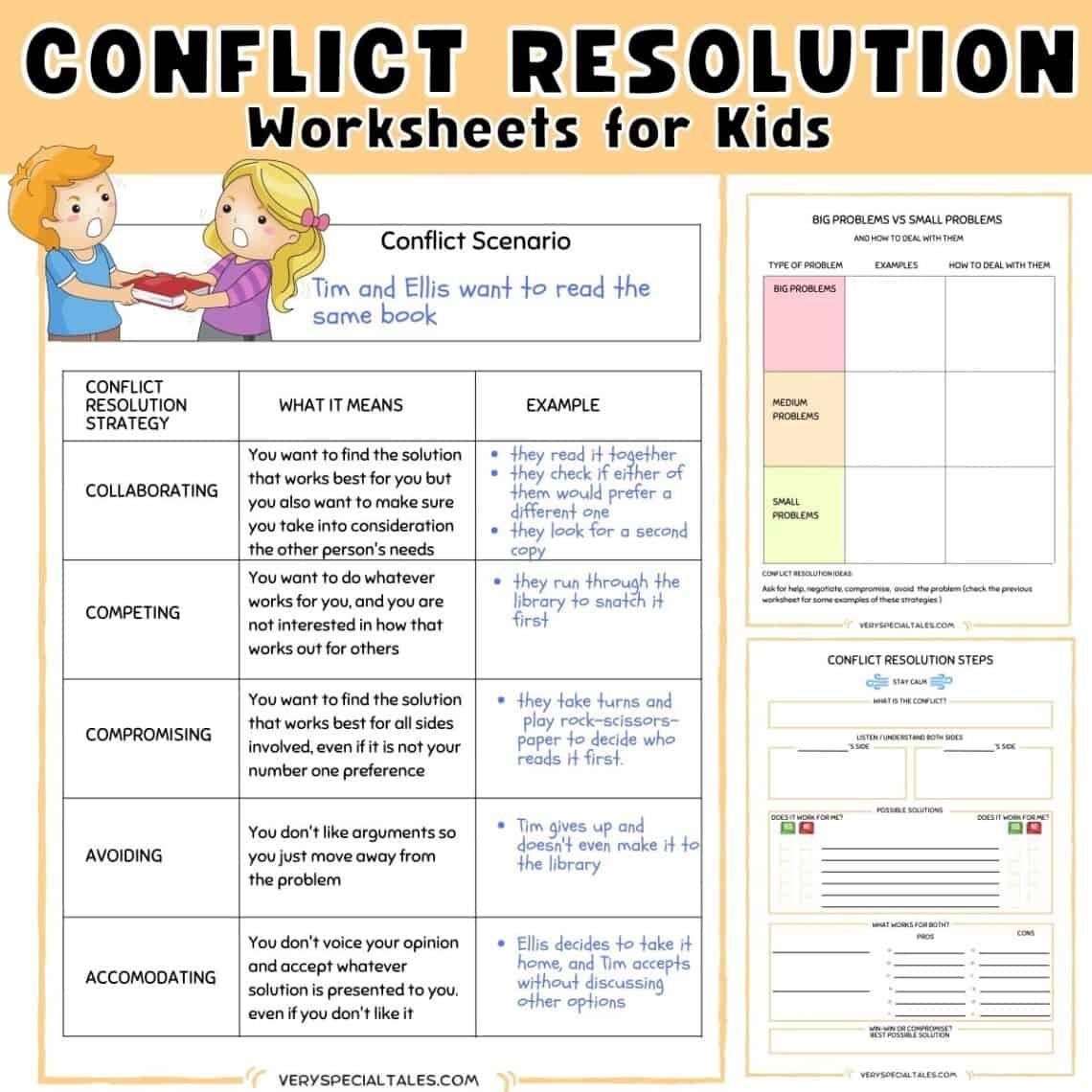
20 Fun Conflict Resolution Activities for Kids (Printable PDF): Worksheets, Games and Activities

Conflict resolution activities for kids: In this post, we will explore different strategies to help kids deal with conflict. We will also list fun and easy activities that you can add to your conflict resolution lessons or use at home with your kids. And, at the end of the post, you will be able to download some conflict-resolution worksheets.
We all go through conflict and arguments in our everyday life. Learning healthy ways to handle conflict is an invaluable social skill to develop in our kids
Luckily, there are some really creative ways to help teach kids all about conflict resolution.
(Disclosure: We are a participant in the Amazon Services LLC Associates Program, an affiliate advertising program designed to provide a means for us to earn fees by linking to Amazon.com and affiliated sites. As an Amazon Associate, I earn from qualifying purchases. There may also be other affiliate links in this post. You can also read our Disclosure & Disclaimer policy here )
What is Conflict Resolution
Conflict resolution is the process used to manage or settle our differences using different conflict resolution strategies.
Ideally, we will try to achieve positive outcomes that will satisfy or be beneficial for all parties sides.
Conflict-resolution is similar to problem-solving. In conflicts though, we may see ourselves inundated with strong feelings (anger, frustration, sense of injustice).
Managing those feelings will be an important first step before we attempt an effective problem-solving strategy .
Conflict Resolution Techniques
There are different classifications that map conflict resolution styles and techniques.
We will briefly review a couple of them because they are a good foundation for understanding conflict resolution’s intricacies.
We’ll start with one of the most popular ones:
The Five Conflict-Handling Modes
Thomas (1976) classifies interpersonal conflict-handling behavior in a model with two basic dimensions:
- Assertiveness (attempting to satisfy our own concerns)
- Cooperativeness (trying to satisfy other people’s concerns too)
This two-dimensional model results in five conflict-handling modes:
- Collaborating (assertive & cooperative)
- Competing (assertive & non-cooperative)
- Compromising (an intermediate level of both assertiveness and cooperativeness)
- Avoiding (unassertive & uncooperative)
- Accommodating (unassertive & cooperative)
In plain words:
- Collaborating: kids look for ways to solve the conflict that bring the best outcome for both parties (the famous win-win situation)
- Competing: we only care about our own goals and are not trying to accommodate the needs of others
- Compromising: we try to look for a solution that may not be our preferred one but is acceptable for all parties involved
- Avoiding: one of the parties may not be as invested in the problem, or prefers to avoid confrontation, and decides to withdraw from the argument
- Accommodating: a kid may choose to neglect their own preferences to satisfy the preferences of the other person
Related Reading: How to Teach Assertiveness to Kids
Other Conflict Resolution Strategies
If we take into consideration the parties involved in a conflict, we could also list the following strategies:
- Negotiation
- Arbitration
- Litigation (which obviously does not apply to our topic here)
What would these look like for our kids: We will focus on how this translates to conflict resolution for kids:
- Negotiation: kids brainstorm satisfactory solutions to their problems and reach a win-win solution. If they can’t find a good solution, they may need to look for a compromise
- Mediation: when kids can’t resolve the conflict on their own, they may need a neutral third party (teacher, parent, caregiver) that helps them come up with a solution rather than imposing it.
- Arbitration: we would arrive here when kids can’t agree, so the neutral third party will need to put the argument to rest deciding on the best solution after listening to both sides.
Why is Conflict Resolution Important for Kids
Children need essential skills like navigating difficult situations to get a peaceful solution.
Benefits to developing conflict resolution skills:
- develop communication skills
- strengthen friendships
- learn goal setting
- solve conflicts in a peaceful way
Conflict resolution requires the development of a number of social skills like:
- problem-solving
- managing negative feelings and big emotions
- collaboration
- flexible thinking
- compromising
- effective communication
- acceptance of diversity
It is when someone in a conflict situation takes the time to consider the emotions of everyone else involved. If kids are able to develop this skill through effective communication and strong emotional intelligence , it will help them solve problems in a more effective way throughout their life.
There are many ways to help kids grow their ability to resolve conflict that can be fun and informative. Keep reading to learn some of the most popular conflict resolution activities…
Healthy Ways to Deal with Conflict
There are healthy and unhealthy ways to deal with conflict.
These are some examples of unhealthy ways kids can use to deal with conflict:
- Not caring about the other person’s view
- Holding a grudge
- Big emotional reactions like getting very angry, shouting, calling names, threatening
- Not being able to compromise
- Giving up on something that is important to you
Examples of healthy ways to approach conflict may include:
- Caring about the other person’s view
- Using your calm and assertive voice to express your feelings
- Not taking things too personally
- Learning to forgive
- Being able to compromise
- Working to find solutions that can accommodate both sides (negotiation)
20 Conflict Resolution Activities for Kids
Wondering how to teach conflict resolution to kids?
Discuss conflict at home or school. Choose topics from the news, a conflict at work, something that happened at school, or even made-up conflict scenarios.
Beyond having conversations, there are some great activities that kids can do individually or as a group to help foster this vital skill.
Here are 20 of the best conflict resolution activities for kids that can help build the valuable lifelong skill of resolving conflict peacefully.
The activities below fall under the following categories:
Conflict Resolution Worksheets
- Conflict Resolution Activities
- Conflict Resolution Games
Some of these activities will be a great addition to a lesson plan.
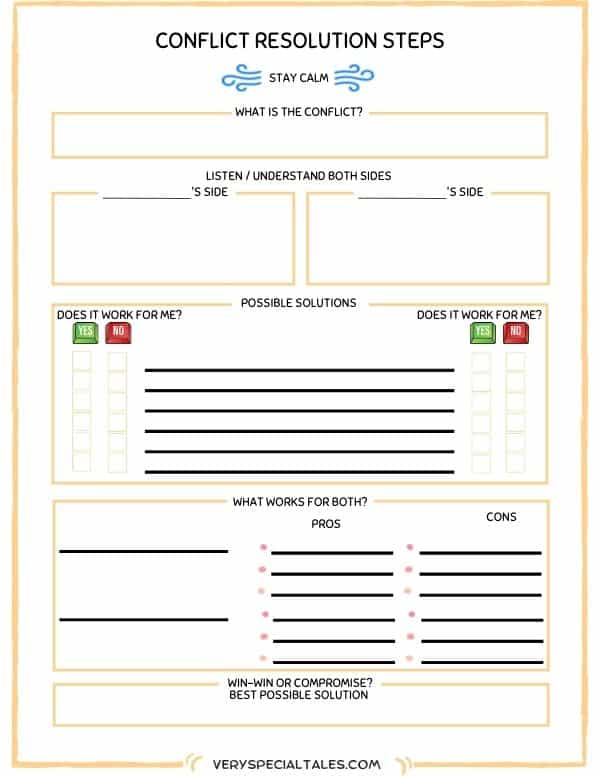
Conflict resolution is, in essence, a social problem-solving situation.
In this worksheet, we will follow the steps for problem-solving, with an important addition (calm-down):
- Calm down so that you can deal with the conflict
- What is the problem/conflict
- Listen to the other side
- Think about possible solutions
- Check pros and cons
- Decide what solution works best for all (win-win if possible)
You can download this conflict resolution worksheet at the end of the post.
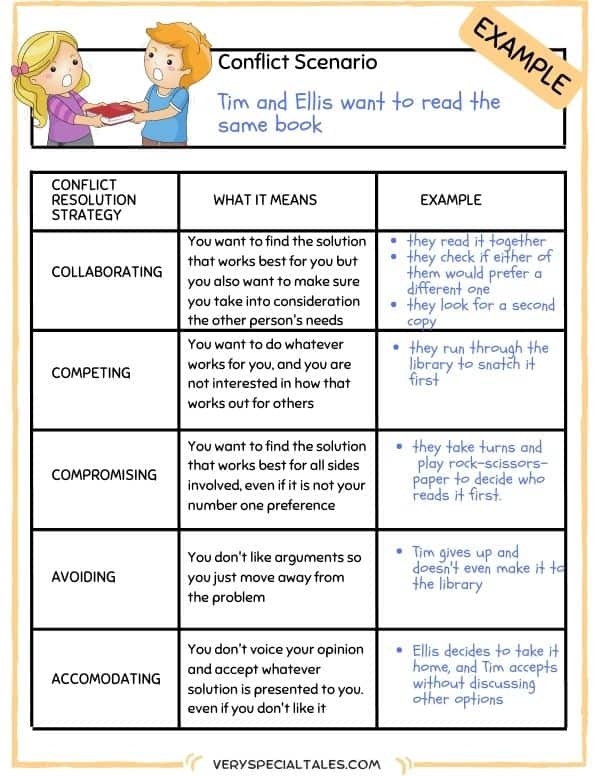
This conflict resolution worksheet will work on the different conflict-handling modes:
- competition
- accommodating.
Identify a conflict scenario, and ask your students to write examples for each conflict resolution strategy.
Your downloadable worksheet includes an example of a conflict scenario (Tim & Ellis want the same book) and a blank worksheet (for your own examples).
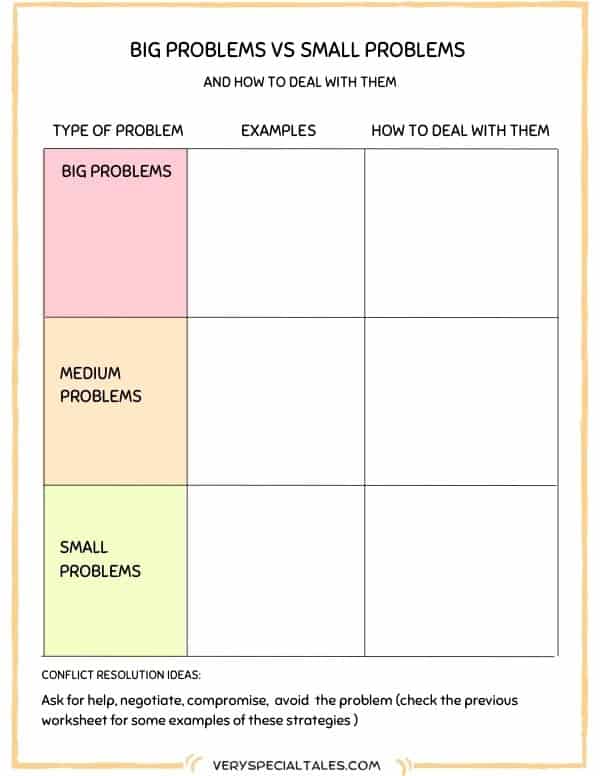
In this activity, we will try to connect the size of our problem, with different ways of dealing with conflict.
Conflict resolution strategies include negotiation, mediation, and arbitration.
Depending on the type of conflict kids are dealing with, they may be able to deal with that conflict on their own (little problem), or they may need to involve an adult in the situation (mediation/arbitration for big problems)
Fun Conflict Resolution Activities for the Classroom / Groups
4. Conflict Resolution Roll-Play
On a popsicle stick, write out common conflicts that children face. Once you have around 20, have two students stand in front of the class and act out the situation that the popsicle stick says.
Once they act it out, have the class discuss different solutions to how the problem could be solved either as a group or in small groups.
Variation: if the different scenarios you are choosing are a bit complicated for the popsicle stick, you can write them down on pieces of paper and put them in a jar or a box.
5. Write it Out
Using the popsicle sticks from the last activity, have the students all draw a different scenario and then write how they think the conflict should be resolved.
In small groups of three or four, have the students share what their popsicle sticks had written on them, and how they would solve the problem.
6. Negotiation Scenario Activity
This is a great conflict resolution activity to help kids understand that there are always different points of view.
Create a conflict scenario where neither of the two parties has all the information about the other party. If both parties negotiate, they can reach a solution that will be good for both of them, but they need to listen to each other to be able to come up with the solution.
An example:
- (Part 1) Two students need the same book for a school essay (for example, “How dinosaurs became extinct”) They only have one day to write their piece, there is only one copy in the school library and neither of them wants to give it up. Let the students discuss how to deal with this conflict
- (Part 2) Provide each student with some additional information: Student A (Annie) would prefer to write about inspiring women role models, but she couldn’t find anything on that topic. Student B (Amanda) loves dinosaurs and is really keen on writing on this topic. On her birthday, she was gifted the Good Night Stories for Rebel Girls book. That could be an excellent choice to inspire Annie’s essay. Ask the students to go back to the negotiations, and suggest they explore why the other party wishes to write about the chosen topic. Are the solutions different this time
7. Create a Short Story
Ask your students to develop a story that recreates a conflict and how it gets solved.
8. Exploring Feelings
Read aloud to your students a scenario that could bring out different emotions.
It could be something as simple as:
- Scenario 1: parent is late for school pick up, and they are going to miss the football match
- Scenario 2: a classmate declines your invitation for a playdate.
Have everyone write down how that would make them feel on a 5×8 notecard, then hold it up.
Ask them to share what they have written and learn how the same scenario can bring different feelings in each person:
- a kid may assume their parents got stuck in traffic, while some other may feel they don’t care if they miss sports
- a student may assume that their friend is very busy, while another may feel their friend doesn’t care and may look for other friendships
Our feelings play an important role in how we deal with a situation.
9. Listening Activity
An important part of conflict resolution is listening to the other side.
Following up on the previous activity, let’s now add new pieces of information
- Scenario 1: there was a big traffic jam, and the parent’s phone was out of battery
- Scenario 2: your friend has swimming lessons on the day you suggested (and since you proposed the same day each time, they kept declining)
After listening to the other side, how would you approach this argument/conflict?
Related Reading: Listening Games and Activities for Kids
10. Conflict Resolution Writing Prompt
Have your students write out the sentence “I would get into a fight with someone if they tried to take away_________.”
Then have them write down why that item is so important to them that they would want to get into a fight.
The idea behind this is that they realize that most conflicts aren’t worth it.
11. Healthy vs. Unhealthy Conflict Resolution
Have your kids write down ways to solve a conflict scenario. They don’t need to be the best solutions. , we are just brainstorming anything that crosses their minds.
Once they have come up with all these solutions, ask them to classify them as healthy vs. unhealthy.
Tip: Go back to our “healthy ways to deal with conflict” section for some inspiration or examples
12. Conflict Resolution Books for Kids
- Speak Up and Get Along is a chapter book for kids age 8 to 12 and is an excellent resource.
This social skills book shares twenty-one strategies children can use to end arguments and fights, make friends and stop bullying. It provides age-appropriate examples and lines they can practice and role-play.
We can’t deal with a conflict if we are feeling overwhelmed with intense feelings. The next suggestions focus on calming down so that we are ready to deal with conflict appropriately
13. Learning to Deal with your Anger
There are many anger management activities that can help kids deal with their emotions.
Check out the Cool Kid Journal (Anger activities for kids) to explore healthy ways of dealing with anger (it includes 70 gorgeous calm down cards).
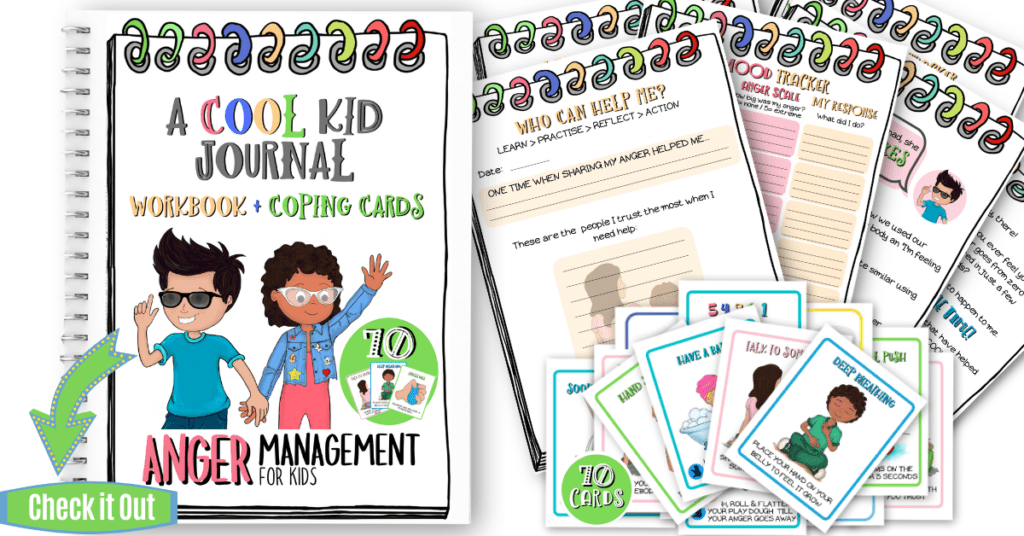
14. Practice Taking Deep Breaths
A simple activity for kids of all ages is to practice taking deep breaths when they are upset.
This will help them calm down so that you can discuss a way to deal with the problem.
Recommended Reading: Fun Breathing Exercises for Kids
15. Model in your own life
Whether you share a story of a time when you needed to resolve conflict or show it in a real-life scenario, adults are the best teachers in explaining conflict resolution.
16. Friendship Activities
If a child in your life seems to be having a hard time staying out of conflict, it might be time to discuss what having a good friend should look like.
While conflict is a part of life, it doesn’t need to be a daily occurrence throughout elementary school and middle school. Instead, encourage your child to work towards healthy friendships.
Recommended reading: Friendship Activities for Kids (includes a worksheet that explores unhealthy bad signs in a friendship /warning signs /healthy/good signs)
17. Conflict Resolution Journal
Have your kids sit down and journal a personal conflict. Then, have them list out different ways that they can resolve that conflict.
Conflict Resolution Games
A great way to learn new skills is playing.
Let’s take a look at some conflict resolution games:
18. 6 Conflict & Resolution Games This game is not just one game, but several great conflict resolution games.
Let’s check a couple of examples
- Spinning the wheel game presents social scenarios, and you need to provide possible solutions. After you spin the wheel, you need to come up with a solution in one of the following categories: me, other, or all (depending on who benefits from the solution). This game explores competition and compromising
- “Are you a bully” is a game inspired by the Snake & Ladders setup that presents bullying/mean situations vs. kind social responses
-> Check out this game
19. Social Skills Group Activity
In this game , players need to discuss socially challenging situations. They include boards on six different topics: morals, manners, empathy, friendship, and two boards on emotions (showing and managing them).
The manners game is actually a conflict resolutions game, and the players have to answer questions like:
- you see a friend stealing something from a shop
- you see a friend cheating during a test
- you are served a meal you don’t like at a friend’s house
These types of questions present a perfect opportunity to brainstorm solutions to a conflict and to discuss the size of the problem and whether it is big enough to engage the help of an adult.
And let’s finish our list with a fun video.
20. How to Explain Conflict to Kids (Video)
In this Sesame Street video, our beloved Robin Williams teaches kids the meaning of conflict.
Other Social Skills Resources
These are some helpful resources to help kids build social skills:
- 25 Problem-Solving Activities for Kids
- I-Statement Worksheets
- Self-Introduction for Kids (Worksheets)
- Social Skills Activities for Kids
- Conversation Starters for Kids
- Listening Games and Activities
- Apology Worksheets and Activities
- Friendship Activities for Kids
- Turn-Taking Activities for Kids
- Fun Emotional Intelligence Activities for Kids
Conflict Resolution Activities (Worksheets / PDF Download)

it s very useful.
Very well made. Thanks
Leave a Reply Cancel reply
Your email address will not be published. Required fields are marked *

- Learning Path
- Logic & Problem Solving Printables
Same or different?

Bug memory cards

Pattern puzzlers

A-maze-ing mazes

Scout & Friends picture puzzle

More to the story

Learning Friends opposites

Quiet time with Learning Friends

What will Koala see at school?

Halloween activity book

Halloween Memory


17 Fun Problem Solving Activities for Kids
There might be affiliate links on this page, which means we get a small commission of anything you buy. As an Amazon Associate we earn from qualifying purchases. Please do your own research before making any online purchase.
As a child, I would spend hours putting together puzzles… whether it was 3-D puzzles or figuring out a crossword. I also loved it when teachers would give the class an open-ended question and we had to work in groups to figure out the answer in our own way.
Even something as simple as playing checkers with my brothers gave me the chance to use strategy as a way to win the game. I honestly believe that it’s so important for kids to solve problems at a young age, as it helps them think critically and outside the box.
Table of Contents
So, Why Is It Important To Teach Kids Problem Solving?
I think these kinds of activities are so important for kids to do because it helps them learn how to think analytically and solve problems on their own. It's a great way to get kids to use their imaginations and be creative.
Rote memorization simply does not have the same effect. This type of learning is great for learning facts like historical dates, but it’s not going to help kids figure out how events in history happened and the results.
We take these problem-solving skills into college, the workforce, and travel . My ability to problem solve since childhood has certainly got me through many sticky situations while in a new city or country.
Additionally, problem-solving helps children learn how to find creative solutions to challenges they may face both in and out of the classroom . These activities can also be fun and used in cohesion with school or playtime.
17 Fun Problem-Solving Activities for Kids
1. marble mazes.
This activity was selected because it requires them to think spatially. Spatial learning will benefit kids when they start driving, riding a bike, playing sports,etc.
To do this activity in its simplest form, you will need a piece of paper, a pencil, and some marbles. First, draw a maze on a piece of paper using a pencil.
Make sure to create a start and finish point. Then, place the marbles at the start of the maze. The goal is to get the marbles from the start to the finish by tilting the paper and using gravity to guide the marbles through the maze.
Another example of a marble maze can involve using toilet paper rolls taped together to create a three-dimensional maze. The larger the maze, the harder you can make it.

Check Price on Amazon!
If you are not into the DIY method, you can always buy a toy maze on Amazon. A good 48 piece puzzle is the Melissa & Doug Underwater Ocean Floor puzzle.
2. The Tower Challenge
Building a tower gives kids the chance to think about gravity, structure, and balance.
To do this activity, you will need some building materials like legos, blocks, or even toilet paper rolls. The challenge is to see how high they can stack the materials without the tower toppling over.
This can be done individually or in teams. An activity like this is good for younger kids and is the building block to learning about harder topics like engineering.
3. The Egg Drop Challenge
The egg drop challenge helps kids learn how to engineer a solution that prevents something from breaking. It requires them to think critically about which materials will best protect something fragile like an egg when dropped from a height.
To do this activity, you will need some eggs and various materials such as straws, cotton balls, bubble wrap, etc. The goal is to construct a device that will protect an egg from breaking upon impact.
This can be done individually or in teams . Teams can even have a competition for the best egg drop device.
As children begin handling, shopping for, and cooking their own food, activities like this will help them understand how to handle breakable items like bottles, eggs, delicate fruit,.etc. Ideally, this is best for age groups 8 and up.
4. The Penny Drop Challenge
This activity was selected because it requires kids to think about physics and how different materials affect sound.
To do this activity, you will need a penny ( or another coin), a cup, and various materials such as paper towels, cotton balls, etc.
The goal is to drop the penny into the cup without making any noise. Begin by placing different materials into the cup and then drop the penny into it. The children should also drop the penny from different heights into the same material to see if/how the impact from a higher drop affects sound.
Group kids into teams or let them try it on their own.
Kids should make note of what type of sounds are made when the penny hits different materials. This is a great activity for kids who are interested in science and physics.
5. The Balloon Race Challenge
This activity was selected because it helps kids learn about aerodynamics and Bernoulli’s principle . It also requires them to think creatively about how to design a balloon-powered vehicle.
To do this activity, you will need balloons, straws, masking tape, and markers. The goal is to design a balloon-powered vehicle that can travel a distance of at least 10 feet. Kids can begin this activity by sketching out their designs on paper.
After they have a basic design, they can begin building their vehicle from various materials. Then kids can explain why they think the balloon traveled or did not travel as far as it did.
6. The Marshmallow Challenge
Marshmallows are not only delicious, but they are also soft and malleable. So kids can have fun using it for some construction projects.
This activity was selected because it requires kids to think creatively about how to build a structure using limited materials. It also helps them learn about engineering and work as a team.
To do this activity, you will need marshmallows and spaghetti noodles. The goal is to build the tallest free-standing structure possible using only marshmallows and spaghetti noodles. If you don't have spaghetti noodles, use something similar like pretzel sticks.
You may even want to establish certain rules like each team can only use a certain number of marshmallows or noodles. A time limit can also make it more fun and challenging.
For more fun activities, check out our post on problem solving exercises for team building .
7. The Balloon Pop Challenge
If you remember your childhood, you probably remember popping balloons for fun at times. But this activity is different because it requires kids to use strategy and critical thinking.
This activity was selected because it helps kids learn about patterns and problem-solving. It is also a lot of fun for kids who like popping balloons. The goal is to create a device that will allow them to pop a balloon without using their hands.
To do this activity, you will need balloons and various materials such as straws, string, paper clips, etc.
8. Picture Pieces Puzzle Game
As mentioned earlier, puzzles are a great pastime – especially in childhood. Kids must think critically about how to put the pieces together to create a certain picture. It also helps them learn about shapes, colors, and other concepts.

You can take a medium to large picture and cut it into pieces. If you have younger kids, you may want to make the pieces larger. However, if you have kids closer to the 8-11 age range, you should be able to provide a challenge and make the pieces smaller.
9. Copy the Block Model
For this challenge, you can build a model out of blocks for the kids to copy. Put kids into groups and make sure each group has the same number of blocks you used for your model.
Make your model block as simple or complex as needed for your child's age group.
Set a time limit and make sure each group starts at the same time.
10. Team Scavenger Hunt
A scavenger hunt is great for kids because they have to search for items and use investigative skills. It is also a lot of fun and can be done both indoors and outdoors .
To do this activity, you will need to create a list of items for the kids to find. The items can be anything from common household items to things you would find outside.
These types of activities can also revolve around a theme like a holiday, movie, or book. For example, if the kids are fans of “Harry Potter” you can make a list of items to find that are related to the movie.
11. Obstacle Course
This activity requires kids to think creatively about how to get from one point to another while maneuvering around obstacles. If you have outdoor space, this can be done with common objects such as hula hoops, cones, etc.
If you don't have access to an outdoor space, you can use common household items to create an indoor obstacle course. For example, you can use chairs, blankets, pillows, etc.
Begin by setting up the course and then timing each child as they complete it. You can also have them race against each other to make it more fun.
Obstacle courses are also great because kids get to be physically active while they are thinking critically.
12. Reading Storybooks
There are many great benefits for kids that read storybooks. One of the excellent benefits is the ability to problem-solve. When they read the stories in the books, they see scenarios that cause them to be attached to the various characters they read about.
So, when they encounter a real-life problem, it is often productive to ask a child how their favorite character would solve that problem. Your kids can also be encouraged to come up with various options and possible outcomes for some of the situations they may encounter.
This not only helps kids solve various problems but become more independent as well.
13. Ask Them Open-Ended Questions
A good way to improve a child's ability to think critically and creatively and improve their ability to solve problems is by asking open-ended questions. It also helps them to develop healthy personalities .
There are no right or wrong answers to these questions. In addition, the solution requires more than a simple “yes” or “no” answer. Furthermore, it allows kids to put some extra thought into their responses.
Here are some examples of open-ended questions you may want to ask.
- What did this experience teach you?
- Was this easy? What was easy about it?
- What this difficult? What is complicated about it?
- What may happen next in this situation?
- How did you come to this solution?
- What, if anything, would you do differently next time?
- What can we do to make things more fun next time?
14. Build Various Structures with Toys
Whether wooden blocks, LEGO blocks, or engineering blocks… giving your kid blocks to build whatever their minds can dream up is fun. In addition, it requires them to think about how they will make a structure, put the pieces together, and creatively ensure the building's function and design.

You may also want to challenge them to build something more complicated and watch them use their brain power to make it happen.
15. Acting Out Skits
Impromptu activities like acting out skits help kids identify problems, develop solutions, and execute them. This process works with multiple kids being divided into teams.
First, you will want to write down different situations, such as resolving a disagreement between siblings or dealing with bullying on the playground on a piece of paper. Second, you will fold the paper and place it in a hat or bowl.
Third, each team will pick a scenario out of the hat. Finally, you can give the kids a few minutes to discuss their solution and act out.
16. Solving Moral Dilemmas
In this simple game, you will help your kids solve simple dilemmas they may find themselves in. You could write down a situation your child may find themselves in and help them learn the moral way to solve the problem.
For instance, “The cashier gave them an additional $5 change back on my purchase. What should they do?” Another scenario could be, “I saw my friend cheating on a test. Should I tell on them or let it go?” A third one could be, “I caught my friends stealing some gum from the store. What should I do?”
After writing down the dilemmas and placing them in a bowl, get each child to select one and read it aloud. Finally, you will help them devise morally correct solutions to the moral dilemma.
17. Animal Pairing Game
This is a fun and creative game to help your kids with focus, critical thinking, and team building skills . In addition, this activity requires an even number of players to participate (4, 6, 8, etc.)
Before starting the game, you will want to write the names of different animals twice, each on a separate slip of paper. Then pass out the slips of paper to each individual or team member, instructing them not to share with anyone the name of the animal they received.
Then the children will perform activities the animals might do without talking or making sounds. Some of these activities might include:
- The way the animal cleans or grooms itself
- The way the animal sleeps
- The way the animal fights
- The way the animal eats or drinks
- The way the animal walks or runs
The goal is for each child to successfully pair up with the other child who has selected the same animal.
How Problem Solving in Childhood Helps in Adulthood
Children are not born with problem-solving skills. It is something that needs to be learned and developed over time .
From babies who learn how to communicate their needs to toddlers who figure out how to get what they want, to children who are starting to understand the consequences of their actions – problem-solving is a process that begins in childhood and continues into adulthood.
Some of the benefits of teaching problem-solving skills to children include:
- Improved critical thinking skills
- Better decision-making skills
- Enhanced creativity
- Improved communication and collaboration skills
- Increased confidence
There are many ways to teach problem-solving skills to children. The activities mentioned above are just a few examples. It is important to find activities that are appropriate for the age and abilities of the child.
With practice, children will develop these skills and be better prepared to face challenges in both childhood and adulthood.
Final Thoughts About Fun Problem Solving Activities For Kids
These are just a few ideas to get you started on teaching your child crucial problem solving skills. Perhaps they’ve inspired to come with some of your own, or seek out others? The important thing is to make sure the activity is age-appropriate and challenging enough to engage the kids.
Problem-solving skills are important for kids to learn because they can be applied to various situations in life. These skills also promote critical thinking, which is an important life skill.
There are many other problem-solving activities for kids out there. In time, you’ll find the ones that work best for your child. And be sure not to forget about your own needs and self-improvement, both of which will make you a better parent and mentor. Here are some useful activities for adults to get your started.
Finally, if you want to level up your parenting skills, then check out this resource that will show you how to get your kids to listen WITHOUT yelling, nagging, or losing control .


- Animal Crafts
- Art Projects
- Christmas Crafts
- Easter Crafts
- Easy Sewing Projects
- Educational Crafts
- Halloween Crafts
- Kid’s Recipes
- Paper Crafts
- Party & Fun Crafts
- Recycled & Nature Crafts
- Thanksgiving Crafts
- Valentine’s Day Crafts
- Wearable Crafts
- Art Worksheets
- Classroom Activities
- Fun Activity Pages
- History Worksheets
- Homeschooling
- Kid’s Poems
- Lesson Planning
- Math Worksheets
- Preschool Worksheets
- Fill In The Blank Ad Libs
- Reading Worksheets
- Science Worksheets
- Word Puzzles
- Writing Worksheets
- Coloring Pages
- Party Printables & Games
- Printable Alphabet Letters
- Printable Crafts
- Pumpkin Carving Patterns
- Birthdays & Parties
- Mother’s Day & Father’s Day
- Patriotic & Heritage Holidays
- St. Patrick’s Day
- Thanksgiving
- Valentine’s Day
Printable Logic Puzzles for Kids
Here’s a brand new set of worksheets to teach critical math skills: printable logic puzzles for kids! There are 9 puzzles varying from easy to intermediate to difficult. Each worksheet already has a data grid drawn out for kids to practice their deductive reasoning skills. They all also have an answer key – I was never very good at logic puzzles when I was a kid. So I appreciate being able to ensure students are on the right track without having to do each puzzle myself!
We have these puzzles and more in our Big Brain Teasers Book for Kids !
Beginner and Easy Printable Logic Puzzles for Kids

Intermediate Logic Puzzles for Kids

Difficult Logic Puzzles for Kids

People Also Read:

We respect your email privacy
About the author
Founder and CEO of Woo! Jr. Kids Activities, Wendy loves creating crafts, activities and printables that help teachers educate and give parents creative ways to spend time with their children.
I am very interested in these logic puzzles, but the “Click To Print” button is not working for me. Would you have any suggestions as to why? Thank you!!
Hi Jessica – you need to have javascript enabled in your browser. Hope that helps!
Your logic puzzles would be perfect for some students I work with. Is it OK to reproduce them for students at a school as long as they’re attributed to you? Or would you limit the number of students I could use them with? Or? Thanks David
Hi David – we have free unlimited use for educational purposes. As long as you aren’t charging for the use, you are free to use them in your classroom as much as you’d like!
This is an awesome website. I wish there were more.
Leave a Reply Cancel reply
Your email address will not be published. Required fields are marked *

- Math for Kids
- Parenting Resources
- ELA for Kids
- Teaching Resources

How to Teach Long Division to Kids in 6 Easy Steps
15 Famous Mathematicians in History That Kids Should Know
11 Best Multiplication Apps for Kids
How to Teach Number Formation in 5 Easy Steps
13 Best Resources for Math Videos for Kids: Math Made Fun
12 Best Funny Short Stories for Kids to Read in 2024
6 Best Alternatives to Public Schooling: A Guide for Parents
How to Cope With Test Anxiety in 12 Easy Ways
Developmental Milestones for 4 Year Olds: The Ultimate Guide
Simple & Stress-Free After School Schedule for Kids of All Ages
12 Best Spelling Apps For Kids in 2024
How to teach parts of speech: 15 fun ways for kids.
How to Teach Letter Recognition in 6 Easy Steps
20 Fun Limericks for Kids
How to Improve Reading Comprehension: Strategies & Tips
12 Best Tips for Substitute Teachers
30 Best Classroom Reward Ideas for Elementary Students
12 Best Websites for English Teachers
10 Best Game-Based Learning Platforms for Kids
60 Fun Animal Facts for Kids

15 Best Problem Solving Activities: Foster Critical Thinking
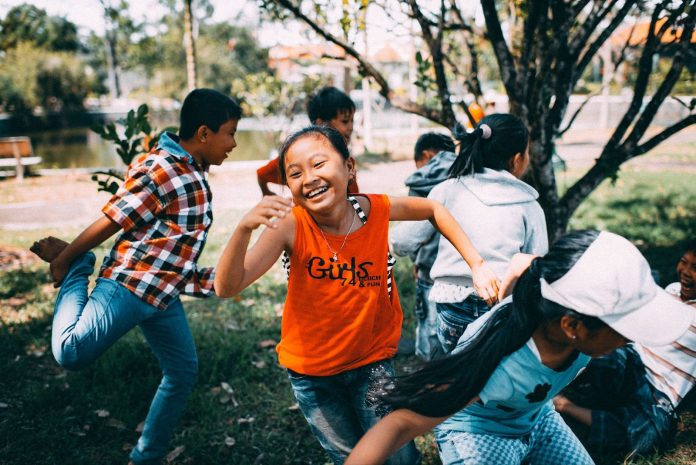
1. Rolling Dice
2. build a tower, 3. tic tac toe, 4. scavenger hunt, 6. activity books, 7. board games, 9. human knot, 10. open-ended questions.
Problem solving activities for kids are a great way to teach them how to think critically and creatively, and how to develop a growth mindset . We’re sure you must have also played many educational games as a kid that helped you develop critical thinking or problem-solving- skills you’re using even today. These activities can be tailored to be fun and engaging, and they help kids understand that challenges and difficulties are opportunities to learn and grow instead of things to be feared.
By providing kids with problem-solving activities, we can give them the tools to develop their problem-solving skills and build the confidence to tackle difficult challenges, which will be valuable to them throughout their life. It will also help them understand that their abilities can be developed with practice and hard work, encouraging them to persevere through difficult tasks and not give up easily when faced with obstacles. If you’re looking for some fun and engaging problem solving activities for children to develop a growth mindset, we have curated a list of activities for you.
SplashLearn: Most Comprehensive Learning Program for PreK-5

SplashLearn inspires lifelong curiosity with its game-based PreK-5 learning program loved by over 40 million children. With over 4,000 fun games and activities, it’s the perfect balance of learning and play for your little one.
15 Best Problem Solving Activities for Kids
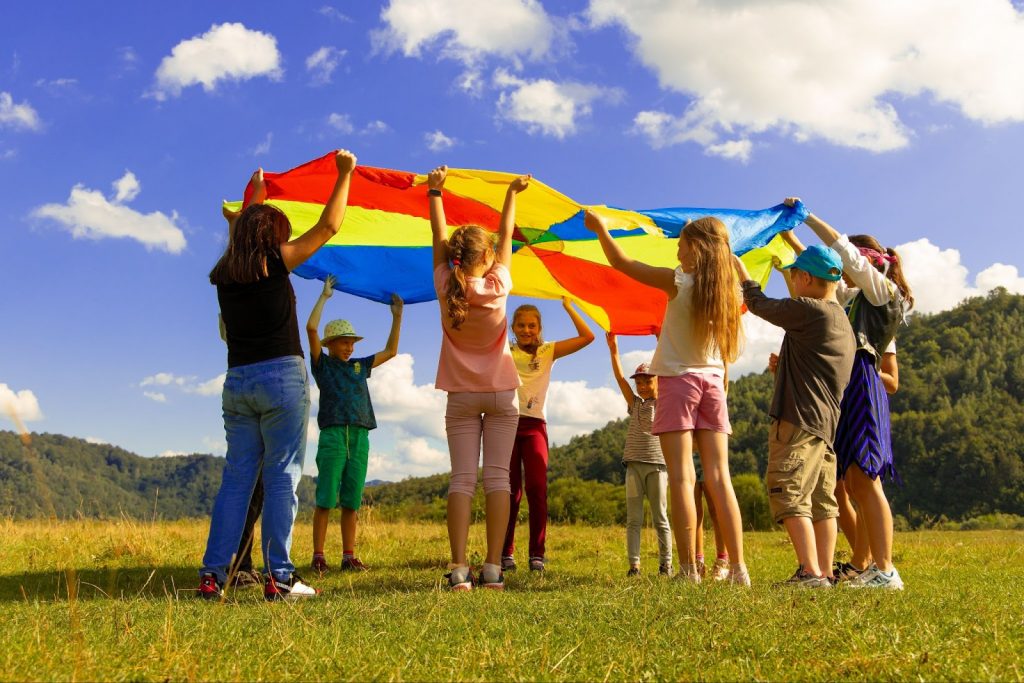
Things you’ll need: A die or dice, some flashcards and a pen
How to do: You can play tons of different games with dice. Playing with two dice encourages kids to quickly add up numbers and learn math in a fun way . One fun game you can play with a single die involves flashcards. For this game, you can assign a category to each number on the die and when the kid rolls the die, they have to name any 3 examples from the category assigned to the number rolled. For example, if number 4 is assigned to animals and it is rolled, they will have to name any 3 animals.
Things you’ll need: Building blocks, lego, toilet rolls or anything that can be stacked
How to do: If you’re looking for problem solving activities for 5 year olds, this is for you. To play this game, just give the kids anything that can be stacked on top of the other. This can be building blocks, lego, Jenga blocks, toilet rolls, etc. The challenge is to stack one on top of the other and see how high a tower they can build. This game can be played in teams or individually as well.
Things you’ll need: A tic tac tow board or pen and paper
How to do: This is one of the most exciting problem solving fun activities for students. You can either play this game on a tic tac toe board or on paper. If you’re playing it on paper, draw a table so that you have 9 boxes. Now each player must choose X or O and try to make a continuous row of their chosen symbol. Whoever succeeds wins.
Things you’ll need: Small toys, stationery items, or anything you want to include in a scavenger hunt
How to do: Assign the teams or individual players specific items they have to find in a defined area. This can be an indoor or outdoor activity for kids . Give them a list of the things they need to find, and you can also give them hints on where to find these things. Whoever or whichever team finds all the things first wins.
Things you’ll need: A puzzle game
How to do: Get a puzzle set. This can be a regular cardboard puzzle or a wooden puzzle and ask the players or teams to arrange it. You can make this a timed challenge or just let the kids solve the puzzle in their own time and have fun.
Things you’ll need: Activity books and pencils
How to do: This is one of the best problem solving activities for kids. Activity books are great for children’s problem-solving skills to develop. Buy them activity books containing games like find the element, what’s wrong with the pictures, or hidden picture books.
Things you’ll need: Board games like Ludo, Snakes and Ladders, Monopoly Junior, and Go Fish
How to do: Give them board games like Ludo, Snakes and Ladders, Monopoly Junior, Go Fish, etc. These board games help kids to develop logic, think deeper, plan ahead and solve problems.
Things you’ll need: A chalk
How to do: Build a maze with chalk on the sidewalk. Make sure you add a few dead-end ways to make it more challenging for the kids. Once the kid is able to walk through and come out of the maze, take the game to the next level by adding even more dead-end ways and see how they overcome the challenge.
Things you’ll need: Just a playground or garden
How to do: This is a great group activity for kids that’ll also teach them lots of skills. Ask the kids to form a circle and raise their right arm up. Now ask them to reach out to someone standing opposite to them in the circle and hold their left hand with their left hand. Now ask them to raise their left hands up and repeat the process with their right hands. The objective is to entangle them completely and then ask them to detangle themselves without letting go of anyone’s hands.
Things you’ll need: Pen and paper
How to do: Once you’re done with an activity, ask kids open-ended questions. These are questions that have no right or wrong answers. Some examples of such questions are- “Did you find this activity easy?”, “What did you enjoy the most about this activity?”, “How would you make this activity more fun?”, etc.
11. Wool Web
Things you’ll need: Balls of yarn
How to do: This is one of the most exciting group problem solving classroom activities for kids . Divide the players into equal teams and ask them to form a circle. Hand them over one ball of yarn each and ask them to make a web of it amongst the teams. Set a time limit for this step, and once it is done, switch the webs so that none of the teams has their own webs. Now the teams will decide on one player from each team to be blindfolded. This blindfolded player will have to untangle to web assigned to their team with the help of verbal instructions from their teams. The team that untangles the web first wins.
12. Fingertip Hula Hoop
Things you’ll need: Hula hoops
How to do: Divide the kids into teams of 6-8 for this game. Each team will stand in a circle and then be asked to raise their hands up. Now, place a hula hoop on top of their fingertips and ask them to bring it down slowly and make it touch the ground without it falling down or leaving the fingertips. The team to finish the task first wins.
13. Obstacle Course
Things you’ll need: Pillows, blankets, mattresses, cones, balls, chairs, etc.
How to do: Build an obstacle course indoors or outdoors with whatever you can find. This makes for one of the most engaging problem solving games for kids. Ask your kids to cross the obstacle course as fast as they can. To make it a bit more challenging, you can also ask them to race against each other to cross the obstacle course.
14. Memory Games
Things you’ll need: Playing cards
How to do: For this fun cards game, place all the cards face down and take turns to turn 2-4 cards. If you are able to open two similar cards (in number), you get to keep the pair. The player with the highest number of cards with them in the end wins.
15. Impromptu Plays
Things you’ll need: A stage
How to do: This is one of the best problem-solving exercises for kids to play in groups. If you have a large group, divide the kids into teams of 6-8. If the group is smaller, just make the kids stand individually. Now make a few chits on a theme that has questions that form a difficult situation or a challenge. For example, you can put in chits with questions like “You just found your friend cheating in an exam. What do you tell them?” or “Your younger sibling just broke your favorite toy. How do you react?”. Each team must enact a scene that includes the situation their chit has. If the group isn’t that big, each kid must speak about the same chit but have different perspectives.
Why Are Problem Solving Skills Important for Kids?
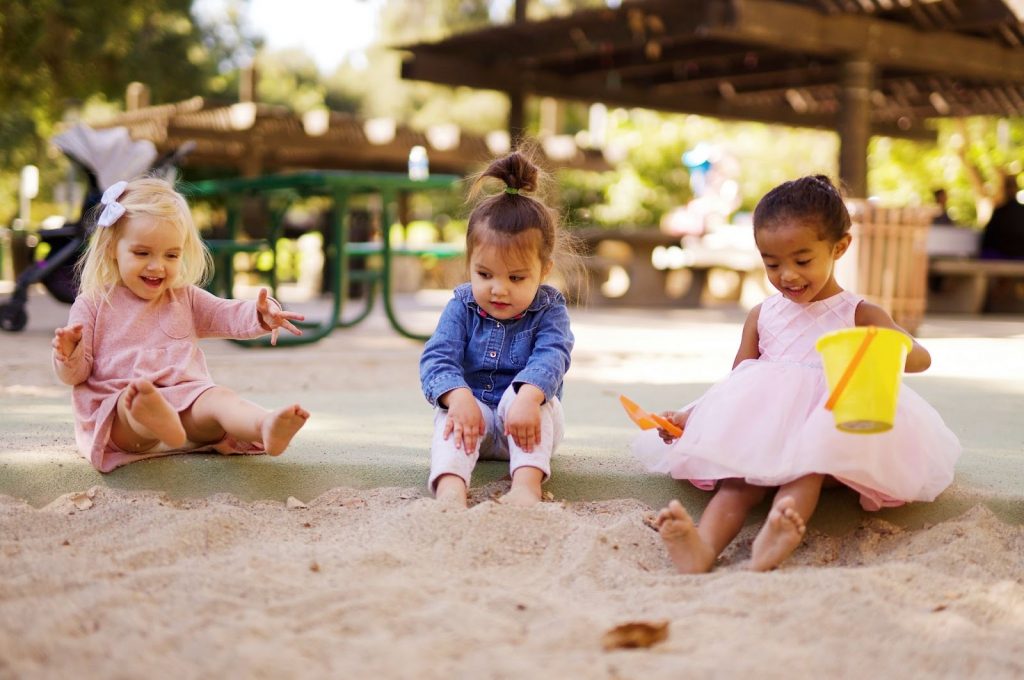
Developing problem solving skills is extremely important for kids as it helps them to navigate easily around difficulties later on in life. As adults, we’re faced with challenging situations every day, and without our basic problem-solving skills, we wouldn’t be able to survive.
Problem solving skills also help kids to make effective decisions. It helps them resolve problems all at once without reducing them to smaller problems. Once kids develop problem solving skills, it is easier for them to develop other skills as well like critical thinking, cooperation and collaboration with others.
Having problem solving skills helps kids to become more creative and think differently than others and enables them to become independent. These skills also help kids develop decision-making skills and build their confidence along the way as they take the right decisions.
Frequently Asked Questions (FAQs)
What are the 5 problem solving skills.
The five problem solving skills are identifying the problem, producing possible results that might work, picking one solution from these, applying the chosen solution and evaluating the results.
What are some examples of problem-solving skills in kids?
Some of the problem solving skills in kids are research, creativity, team-building, communication, active listening, decision-making, and analysis. If you find some of these skills in a kid, chances are they’re great at problem solving.
What is problem solving learning?
According to cornell.edu, Problem solving learning is an approach wherein students are asked open-ended questions about a certain topic, and they must resolve and answer the same in groups.
At what age do children begin problem-solving?
According to a study by Shaffer , kids can start developing basic problem solving skills from the age of three. This further continues to develop as they grow.
What are three problem-solving techniques
According to deakin.edu , the three most basic problem solving techniques are defining the problem, listing out all the possible solutions, and evaluating the options.
12 Best Social Skills Activities for Kids of All Ages
12 Best Pattern Activities for Preschoolers in 2024
15 Best Movement Activities for Preschoolers in 2024
- Pre-Kindergarten
- Kindergarten
Most Popular

15 Best Report Card Comments Samples

117 Best Riddles for Kids (With Answers)

40 Best Good Vibes Quotes to Brighten Your Day
Recent posts.

Math & ELA | PreK To Grade 5
Kids see fun., you see real learning outcomes..
Watch your kids fall in love with math & reading through our scientifically designed curriculum.
Parents, try for free Teachers, use for free

- Games for Kids
- Worksheets for Kids
- Math Worksheets
- ELA Worksheets
- Math Vocabulary
- Number Games
- Addition Games
- Subtraction Games
- Multiplication Games
- Division Games
- Addition Worksheets
- Subtraction Worksheets
- Multiplication Worksheets
- Division Worksheets
- Times Tables Worksheets
- Reading Games
- Writing Games
- Phonics Games
- Sight Words Games
- Letter Tracing Games
- Reading Worksheets
- Writing Worksheets
- Phonics Worksheets
- Sight Words Worksheets
- Letter Tracing Worksheets
- Prime Number
- Order of Operations
- Long multiplication
- Place value
- Parallelogram
- SplashLearn Success Stories
- SplashLearn Apps
- [email protected]
© Copyright - SplashLearn

Make study-time fun with 14,000+ games & activities, 450+ lesson plans, and more—free forever.
Parents, Try for Free Teachers, Use for Free
14 Fun & Challenging Printable Logic Puzzles for Kids
With easy and difficult puzzles, these logic exercises can help elementary school kids of all ages develop critical thinking skills.
Michele is a writer who has been published both locally and internationally.
Learn about our Editorial Policy .
Want to stretch your kids' critical thinking abilities? Logic puzzles are great problem-solving activities that teach logical reasoning, organizational skills, and critical thinking. Our logic puzzles for kids give them confidence in their own abilities and make them feel smart.
Printable Traditional Logic Puzzles With Grids
Traditional logic puzzles require using the process of elimination to figure out the answer. The provided grid helps kids from kindergarten on up organize the information to solve the deduction puzzle.
- For example, if a clue says, "Mary doesn't like cats," you would find the column labeled Mary and the row labeled cats and put an 'X' where they intersect.
- When only one choice is left in a row or column, put an 'O' there to indicate that it's the correct choice.
- If a clue tells you the correct choice, like "Mary loves riding horses," you can place an 'O' where Mary and horses intersect and put 'X's in Mary's row for the other animals. Logic states that if she chooses one, she cannot choose the others.
- Positive Ways to Channel Your Kid's Seemingly Unlimited Energy
- Preschool Report Card Comment Examples for Every Area
Our logic puzzles are printable, so you can print it out for your kids so they can complete it. Click on the puzzle you want to download and print it. If you need help downloading the printable mind puzzles, check out these helpful tips .
Printable Animal Logic Puzzle With Grid
In the animal-lovers logic puzzle, four kids are picking out unique pets, and you have to figure out which pet each child chose. Kids ages five to seven can solve this easy logic puzzle that includes a separate answer key.
Fruit Logic Puzzle With Grid
Lower elementary kids can have fun solving the fruit lovers logic puzzle. With only four rows, four columns, and four clues, this puzzle is on the easier side as kids find out who ate each piece of fruit. The included answer keys show the correct answers.
Dance Logic Puzzle With Grid
With only three clues, the dance logic puzzle is fun and challenging for elementary school children. It's up to you to find out which girls danced with which boys at the big school dance. Check your answers on the included answer key.
Pie Logic Puzzle With Grid
The pie logic puzzle is made for kids in grades three through five. This challenging logic puzzle features five clues, five rows, and five columns. Kids need to figure out who got each type of pie. The solution is provided on a separate page.
Vehicle Logic Puzzle With Grid
Kids in upper elementary and middle grades are challenged to figure out three different factors in the Let's Get Moving logic puzzle. Using three clues, kids need to figure out who drove what kind of vehicle and what color it was. If you can't solve the puzzle, find the solution on the provided answer key.
Related: Free Printable Kids' Activities
Line Leader Logic Puzzle With Grid
The 5-by-5 grid with the line leader logic puzzle makes it more challenging and ideal for upper elementary students. Kids will have to figure out what order the children are standing in as they wait for ice cream using only four clues. Use the included solution to check your answer.
Printable Nonogram Puzzles for Kids
To solve nonogram puzzles, look at the numbers on the tops and sides of the grid. Think of these logic worksheets as color-by-numbers that use a pencil instead of crayons.
- Each number represents a continuous section of black block in that row or column. For example, a 6 to the left of a row means color in 6 consecutive blocks.
- If there are two numbers, it means there are two colored sections with a gap between them. For example, 3 then 4 means color three blocks, leave some white space, then color 4 blocks.
- Use the row and column numbers to figure out where the white spaces should go.
- Each finished puzzle creates a fun image you can discover on the included answer keys.
Easy Kids' Nonogram Puzzle
Kids in lower elementary grades can grasp the concept and try this easy nonogram puzzle that only features single or double numbers in a 6-by-8 grid.
Difficult Kids' Nonogram Puzzle
Upper elementary and middle school kids can try their hand at this difficult nonogram puzzle that features a triple-number clue.
Printable Sudoku Puzzles for Kids
Sudoku puzzles are all about numbers. Each row will have the numbers 1 through 9 listed only once. The same goes for the columns and the square sections that consist of nine squares each. This game uses the process of elimination as well as a bit of trial and error. Answer keys are provided with each puzzle.
Easy Kids' Sudoku Puzzle
Younger kids can try out this easier 9-by-9 grid sudoku puzzle, which features many given numbers at the start.
Difficult Kids' Sudoku Puzzle
Older kids who are ready for a challenging logic puzzle can try this difficult Sudoku puzzle. It still features a 9-by-9 grid, but there aren't as many given numbers as the other Sudoku puzzle.
Printable Math Logic Puzzles for Kids
Math logic puzzles for kids add the extra challenge of solving math problems along with the logic puzzle. Kids will need to know basic math concepts to complete these, so they're best suited for kids going into first grade or older.
Strimko Adding to Ten Puzzles
Strimko puzzles are similar to sudoku puzzles, but they don't have a standard grid. Each stream, or the circles connected by lines, must add up to ten. Each row must contain different numbers, and each column must, too. Using only the numbers 1 to 10, kids will have to figure out which fits where. There are three puzzles on the printable logic puzzle PDF with an attached answer key.
Multiplication and Division KenKen Puzzles
KenKen puzzles offer a real math challenge for upper elementary and middle school students. Each of the two puzzles features a 3-by-3 grid. Each row and column must contain different numbers. Kids need to use the provided sum and math symbol to find the right answers for a given cage or colored section. They can even use a division or multiplication chart printable to help them get started.
Challenging Puzzles for Kids
If your kids have solved all the printable logic puzzles, they can move on to other types of kids' puzzles and fun challenges for kids . Each type of puzzle exercises different skills.
- Solve kids' word search puzzles that feature clues and words kids should be familiar with.
- Printable word puzzles for kids work on reading and spelling skills.
- Turn pictures into words with printable rebus puzzles for kids .
Tips for Solving Logic Puzzles
Solving logic puzzles requires concentration and organization, but you don't want to overthink the solutions. Use these general tips to help you solve any kids' logic puzzle.
- Read all the directions and information once before you start taking action.
- Use a pencil and have an eraser on hand so you can easily wipe away mistakes.
- Start with what you know. If the information you have isn't directly spelled out, write it in the margins of your paper.
- Start at the end and work backward if you're having trouble starting at the beginning.
- If it's a short puzzle, write out all possible answers, then cross them out as they're proven wrong.
- If it's a number puzzle, write out all the numbers you're allowed to use, then cross each off as you use it.
- Look for patterns that might be hidden within the puzzle.
- If you're really struggling with a puzzle, put it away and come back to it later. You'll often catch things you missed with fresh eyes.
Engage Your Logical Brain
Logic puzzles for kids are meant to be both fun and challenging. That being said, it's easy for kids to get frustrated with these types of puzzles. Make sure the puzzles you choose are age-appropriate and offer hints when needed to help kids get to the solution. When they do, they'll be filled with confidence!

15 Problem-Solving Activities for Kids & Teens: Critical Thinking

What is one of the most important skills all students must learn? Is it math or coding? Reading? Writing? While all these skills are indeed vital to success, the one skill that underlines all disciplines is problem solving. All lines of work need great problem solvers to find tomorrow’s solutions, and students of any age can be honing their problem-solving skills. Check out some of these fun problem-solving activities for kids and teens below!
Problem-solving activities for elementary school kids (ages 5-10)
From traditional paper-and-pencil activities to online tools, below are some great activities for kids ages 5-10.
1. Coding Courses for Kids
It’s never too early to start learning the foundational concepts of computer programming! There are a number of courses appropriate for young students to start building their problem solving skills, including the award-winning Scratch Ninja course . For the uninitiated, Scratch is a user-friendly colorful drag-and-drop coding tool developed by MIT for making awesome games and animations while learning important coding logic. Or, for students who are visual learners, try a Minecraft Redstone Engineering course to find out how to build awesome inventions! There are many free coding classes to start with, to find your child's interests.
2. Tower Building
Turns out that kindergartners might be better engineers than grownups (at least according to this experiment)! The challenge was as follows: given 20 pieces of spaghetti, a yard of tape, and a yard of string, build the tallest possible tower that can support 1 marshmallow on top. After various groups of people tried it from Stanford and other universities, kindergartners ended up beating them for creating the tallest tower. Challenge your student to see how tall they can make their tower too!
3. Crosswords
Whether taken out of the newspaper or off of the web, crosswords are a useful logic puzzle for kids to work on. Crosswords encourage students to use context clues, as well as their reasoning skills by eliminating possible options as they progress. Plus, it’s easy to vary the difficulty of the puzzles, as well as find fun, themed crosswords for different holidays! There's even a Thanksgiving crossword for your student to try.
4. Jigsaw Puzzles
There’s nothing like a good, ole’ fashioned puzzle to challenge the mind. Each person takes a different approach to puzzle solving, whether they organize their pieces first, find all the corners, or do something totally different. Exploring different strategies for solving puzzles is an effective introduction to independently creating strategies for problem solving. This is a solid choice for students who are visual learners.
An age-old classic, LEGOs are a fantastic way to combine creative skills with problem solving. Students need to follow sequential steps and visualize to create their LEGO designs. It’s even better when students go beyond the kit instructions to create their own LEGO build, as students will have to learn to utilize limited resources while coming up with a structured plan for designing their idea. LEGO Mindstorms is a popular starting point.
Problem-solving activities for middle school tweens (ages 11-13)
Middle schoolers (ages 11-13) will want to be challenged more with their activities, and these are some effective activities for encouraging growth.
6. Middle School Coding Courses
By the time they reach middle school, students will be ready to take on more advanced coding concepts, regardless of their prior coding experience. For those who have no prior coding experience, the Accelerated Scratch course is an excellent option, as it will introduce students to basic coding concepts while allowing them to make their games and animations. Students with some prior coding experience may want to try the Minecraft Code to Mod course, builds upon basic coding concepts like loops, conditionals, and more while building students' creativity and critical thinking.
7. Birthday Ordering
An activity commonly done at summer camps, the silent birthday lineup is an excellent problem-solving activity for groups. The goal is for students to line up in chronological order based on their birthdays, without talking at all. Working in total science requires students to think outside the box to accomplish their goal, and to prioritize teamwork. Try timing the students to see how quickly they can get it done, then let them reflect on the activity afterwards to see what strategies worked and what didn’t.
8. Event Planning
Have students plan their own event, like a fundraiser, a social, or a competition for their coding club . This will require students to collaborate by delegating tasks, coordinating supplies, budgeting, and more. Even planning something as simple as a pizza party still requires some logistical planning, and students will benefit from struggling through the process. Plus, they can get to enjoy the results of their work when the event finally arrives!
Arduino circuit boards are an excellent choice for children interested in engineering. Because Arduino is widely-popular, there are countless tutorials demonstrating its capabilities, such as creating a controller, custom RGB lighting, robotics, or more. Once students learn the basics, they can use Arduino boards to come up with creative solutions to their own problems. This is an excellent idea for highly-motivated kids who like to work by themselves.
Sudoku is an excellent number puzzle and a great problem-solving exercise. It requires students to evaluate multiple possible options as they try to fill in the puzzles, so students need to be able to create an organized approach to be successful. There are various difficulty levels for sudoku, so students can start easy, then advance as they become proficient at solving the puzzles.
Problem-solving activities for high school teens (ages 14+)
High school (14+) is a good time to incorporate group work into the activities, as students will need to learn to work collaboratively for their future in college and beyond.
11. Coding for Teens
Once reaching high school age, students are ready to tackle the complexities of text-based coding. This is where students can focus on their interests, whether it be web design , AI, app design , and more. Create & Learn’s Python for AI course is a good option, as Python is one of the most widely-used programming languages in the world. Students interested in game design might try the Roblox Studio course , which teaches students how to program their own Roblox games (or try the Beginner Roblox Game Coding course if they have limited previous coding experience.)
12. Robotics Club
Many different school programs offer robotics teams and robotics competitions , using tools such as VEX robotics . Robotics is a great way to combine computer science, mechanical engineering, and problem-solving skills. If there is no robotics team at your student’s school, consider trying a robotics kit such as the Makeblock mBot Ranger .
13. Egg Drop
This classic experiment is a lot of fun for students, and makes for a good competition as well. Students must build some sort of structure that will prevent an egg from breaking when dropped from a certain height (like the top of a staircase). It works best when students are restricted with the resources they can use; for instance, define a “ budget ” for parts that they can’t exceed, or give everyone the same materials to work with .
14. Debate Club
Whether deciding public policy or the best ice cream place in town, having the ability to engage in meaningful debate is critical. Debate forces students to self-analyze, listen, and think critically before making decisions. These skills benefit students’ futures by making them strong, independent thinkers. Check out these speech and debate competitions . And here are some tips for starting a debate club .
15. Science Fair
Science fairs pose an excellent opportunity for exploring the scientific method, both through creating personal projects and checking out other students’ presentations. By encouraging students to come up with their own projects, they must identify some question or problem and find a way to solve it. This can be the most challenging kind of problem-solving, as it requires the student to take initiative in finding their own ideas, but also can be the most rewarding. Try the Google Science Fair Competition .
Enjoy problem-solving activities for kids
And there you have it: problem-solving activities for students from elementary through high school age. Of course, there are many more ways to build critical-thinking abilities like problem-solving. For more ideas, check this list of awesome after-school enrichment activities !
Written by Create & Learn instructor Dominic Occhietti. Dominic is a graduate of Michigan State University, where he studied music performance and computer science. He thoroughly enjoys teaching, whether that be coding classes, French horn lessons, or even downhill skiing lessons!
You Might Also Like...

Fun Spring STEM Activities for Kids

How to Prepare for the AP CSA Exam
- My Storyboards
Problem Solving Worksheets
Customize problem solving worksheets.

What is Problem Solving?
It is the cognitive process of identifying, analyzing, and finding solutions to challenges or issues. It involves using logical and creative thinking to address obstacles that occur, make decisions, and achieve goals. Consider the five problem-solving steps: identifying the problem, generating possible solutions, evaluating options, selecting the best solution, and implementing it. Understanding the steps is crucial for navigating complex challenges with clarity and efficiency.
What are Problem Solving Worksheets?
These worksheets are structured in such a way that encourages solution-based thinking. Engaging in interactive problem-solving activities can help develop critical thinking skills and creative approaches to overcoming obstacles. While these skills are used in a variety of aspects of life, our worksheets focus on problem solving in mathematics. Printable worksheets provide practice for any child who is learning to master new skills they are taught in class. They are perfect for any level, and can be applied to any type of mathematical problem or unit of study.
Why are They Important and How are They Best Used?
They are great for ensuring that students practice what they have yet to master, since they can be customized by the teacher to meet the class and individual needs. They can be used to practice all kinds of word problems involving addition, subtraction, multiplication, division, and so much more.
In a world where challenges are inevitable, the ability to tackle problems effectively is a valuable skill that can be applied across all subjects and age groups. Problem-solving skills are the generator of success. They empower individuals to navigate complex situations, identify triggers, and develop plans to overcome obstacles. From the classroom to the boardroom, these skills are in high demand.
Tailoring Problem-Solving Worksheets for Different Subjects
Mathematics.
Math problem-solving worksheets can be a playground for nurturing critical thinking. Through word problem worksheets, students not only practice calculations but also apply math concepts to real-world scenarios.
Scientific problem-solving worksheets ignite curiosity. They prompt students to hypothesize, design experiments, collect data, and draw conclusions, fostering a scientific mindset.
Language Arts
Language skills and critical thinking intertwine in language arts problem-solving worksheets. Analyzing literature, engaging in creative writing prompts, and correcting grammar offer a holistic approach.
Social Studies
History comes to life through problem-solving worksheets. Encourage students to ponder over historical dilemmas and global challenges, nurturing their ability to think beyond the surface.
Math Worksheet Activity Ideas
- "Math Detective" Challenge: Create a set of worksheets featuring a fictional mystery storyline. Each worksheet presents a clue that requires students to solve a math problem to unveil the next piece of the puzzle. This engaging activity encourages critical and sequential thinking.
- "Math Menu" Project: Design a menu-style worksheet with various math problems categorized by difficulty levels. Allow students to choose a certain number of problems from each category to complete, giving them autonomy and catering to their individual skill levels.
- "Design Your Dream House" Activity: Provide a worksheet that guides students through designing their dream house layout. They need to calculate room dimensions, total area, and even budget constraints. This hands-on activity integrates math into real-life scenarios.
- "Math Art Gallery" Exhibition: Assign each student a famous artwork and create a worksheet that involves geometric calculations related to the art's dimensions and shapes. Students can then present their findings in a "Math Art Gallery" exhibition.
- "Math in the News" Analysis: Collect recent news articles that involve math-related concepts, such as statistics, percentages, or data analysis. Provide worksheets that require students to analyze the math behind the news and discuss its implications.
- "Budgeting for Vacation" Project: Design a project-based worksheet where students plan a vacation, considering expenses like transportation, accommodations, and activities. They must budget and calculate costs while staying within a specified budget.
- "Math Around the World" Exploration: Create a worksheet that presents math problems related to different countries' cultures, currencies, and measurements. Students solve problems like converting currencies or calculating time zone differences.
- "Mathopoly" Board Game: Design a problem-solving board game where players move through spaces by solving math problems. This interactive approach adds an element of fun while reinforcing math skills.
- "Math Olympiad Simulation" Practice: Prepare a set of challenging math problems similar to those in Math Olympiad competitions. Have students work on these problems individually or in teams to sharpen their skills.
- "Math Interview" Project: Assign each student a famous mathematician or scientist and provide a worksheet that guides them to research and create interview-style questions. This encourages exploration of math history and its relevance.
- "Math Escape Room" Challenge: Develop a series of interconnected math problems that lead students through a virtual "escape room." They must solve each problem correctly to advance to the next step and eventually "escape."
- "Data Analysis Report" Assignment: Provide students with a dataset related to a topic of interest, such as sports statistics or environmental data. They must analyze the data, create graphs, and present their findings in a structured report.
- "Math and Music Fusion" Project: Combine math with music by providing a worksheet that explores concepts like rhythm, frequency, and ratios in music. Students can calculate beats per minute, analyze musical patterns, and even compose their own melodies.
- "Math Recipe Creation" Challenge: Ask students to create a new recipe by adjusting ingredient quantities based on serving sizes. They must calculate ratios, proportions, and conversions to ensure the recipe's success.
Designing Effective Problem-Solving Worksheets
Creating successful problem-solving worksheets involves careful planning. Here are some ideas to consider:
- Define the Learning Objective: Clarify the specific mathematical concept you want to reinforce with the worksheet. Outline the steps involved and determine how this worksheet will contribute to improving their skills.
- Select a Problem Type: Choose a math problem type that aligns with the learning objective. It could involve algebraic equations, geometry calculations, or even practical scenarios related to everyday life.
- Structure the Steps: Break down the problem-solving process into logical steps. Ensure that each step reflects the problem solving steps you want students to follow, such as understanding the problem, planning, solving, and verifying.
- Incorporate Interactive Elements: Integrate interactive elements like multiple-choice questions, fill-in-the-blanks, or even drawing areas to encourage problem solving exercises within the worksheet.
- Utilize Graphic Organizers: Introduce a visual problem solving graphic organizer to help students map out their thinking. This can include spaces for writing down given information, variables, and equations.
- Provide a Problem Solving Template: Offer a structured template that guides students through the problem-solving process. Include prompts and placeholders for each step to provide clear direction.
- Encourage Exploration: Inspire students to explore different types of techniques to arrive at solutions. Encourage them to think critically and try various strategies before settling on an approach.
By incorporating these elements, you can create a comprehensive problem solving worksheet for kids that not only teaches mathematical concepts but also equips them with transferable skills. Whether you're focusing on basic arithmetic or more advanced mathematical principles, this approach ensures an engaging and educational experience for young learners.
More Storyboardthat Resources and Free Printables
- Multiplication Worksheets
- Subtraction Worksheets
- Game Worksheets
- Task Card Maker
How to Make a Problem Solving Worksheet
Choose one of the premade templates.
We have lots of templates to choose from. Take a look at our example for inspiration!
Click on “Copy Template”
Once you do this, you will be directed to the storyboard creator.
Give Your Worksheet a Name!
Be sure to call it something related to the topic so that you can easily find it in the future.
Edit Your Worksheet
This is where you will include directions, specific images, and make any aesthetic changes that you would like. The options are endless!
Click "Save and Exit"
When you are finished, click this button in the lower right hand corner to exit your storyboard.
From here you can print, download as a PDF, attach it to an assignment and use it digitally, and more!
Happy Creating!
Frequently Asked Questions About Problem Solving Worksheets
How can math problem-solving worksheets show students how to improve problem-solving skills.
They provide structured exercises that guide students through real-world scenarios. By actively engaging in these worksheets and activities, children can practice the problem solving process, enhancing their critical thinking and logical reasoning abilities.
What strategies can I use to teach problem-solving skills using math worksheets?
Incorporate helpful math problem solving worksheets for kids into your lessons. Support and encourage students to work through the problem-solving steps: understanding the problem, devising strategies, making calculations, and verifying their solutions. Provide examples, guidance, and feedback to nurture their problem-solving skills.
How can I ensure that students grasp the problem-solving process effectively?
Provide clear instructions in your math problem-solving worksheets that guide students through each step of the process. Offer examples and encourage them to discuss their approaches. By nurturing a supportive and collaborative environment, you can help both younger kids and older kids build confidence in their problem solving skills.
What are specific examples of how to teach problem-solving skills in math using pre-answered solution worksheets?
Teaching problem-solving skills in math using pre-answered solution worksheets can be exemplified through scenarios like quadratic equations. Present the class with a quadratic equation and a pre-answered solution that breaks down the steps of factoring or using the quadratic formula. This guides them to understand the process, identify key components, and apply appropriate methods. Similarly, for geometry, offer a challenging problem involving angles or area calculations, along with a pre-answered solution that demonstrates the application of relevant geometric principles. As students work through the problem and compare their reasoning with the pre-answered solution, they grasp problem-solving strategies, logical sequences, and the importance of meticulous calculations. In both cases, these worksheets instill confidence, reinforce systematic approaches, and enhance students' problem-solving skills while navigating mathematical complexities.
Try 1 Month For
30 Day Money Back Guarantee New Customers Only Full Price After Introductory Offer
Learn more about our Department, School, and District packages

- Thousands of images
- Custom layouts, scenes, characters
- And so much more!!
Create a Storyboard
Problem-Solving Skills Worksheets for Kids
- Printable worksheets
- Educational videos
- Learning games
422 filtered results
- Extra Challenge
- Kindergarten
- ABC Letters
- Letter Recognition
- Upper & Lowercase Letters
- Missing Letters
- Phonics
- Numbers
- Counting
- Addition & Subtraction
- Measurement
- Multiplication
- Geometry
- Word Problems
- Tracing Words
- 3 Little Pigs
- Reading Comprehension
- Building Vocabulary
- Governance and Civics
- Life Science
- Our Body and Health
- Plants and Animals
- Physical Science
- Our Planet and Environment
- Problem Solving
- Plants and Animals
- English for Beginners
- Tracing Letters
- Tracing Lines and Curves
- Tracing Numbers
- Tracing Shapes
- Cursive Writing
- Color by Numbers
- Connect the Dots
- Fairy Tales
- Black history
- Dinosaurs Day
- International Chess Day
- 4th of July
- Thanksgiving
- Alphabet
- Math
- Writing
- Science
- Reading
- Social Studies
- Maze Puzzles
- Connecting the Dots
- English Language Arts
- Problem-Solving Skills
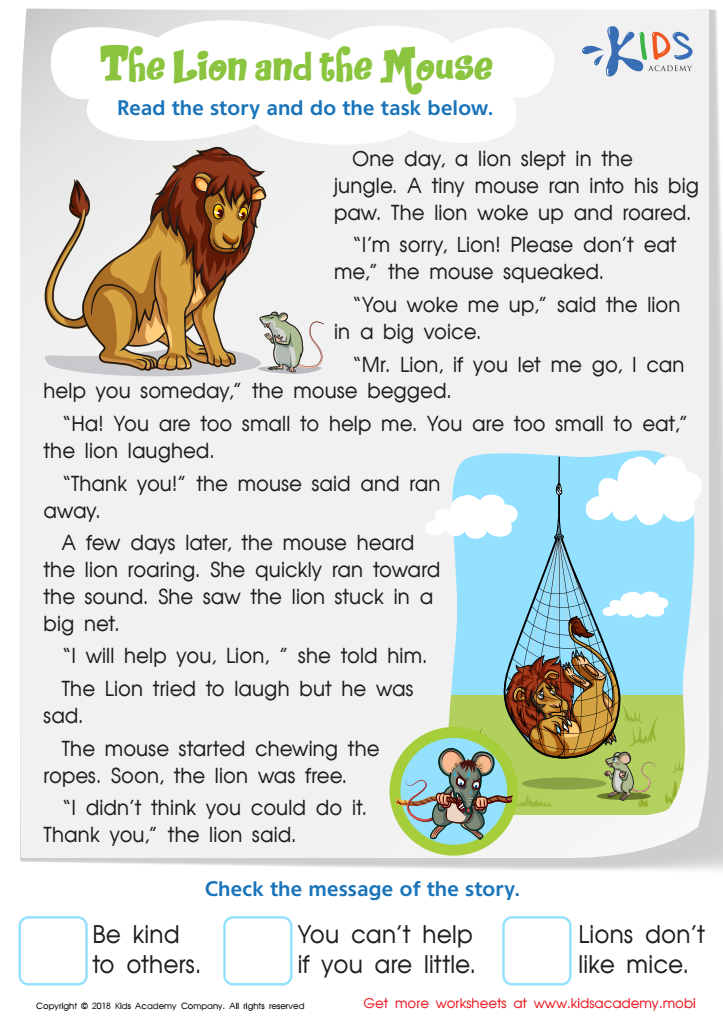
The Lion and the Mouse Worksheet
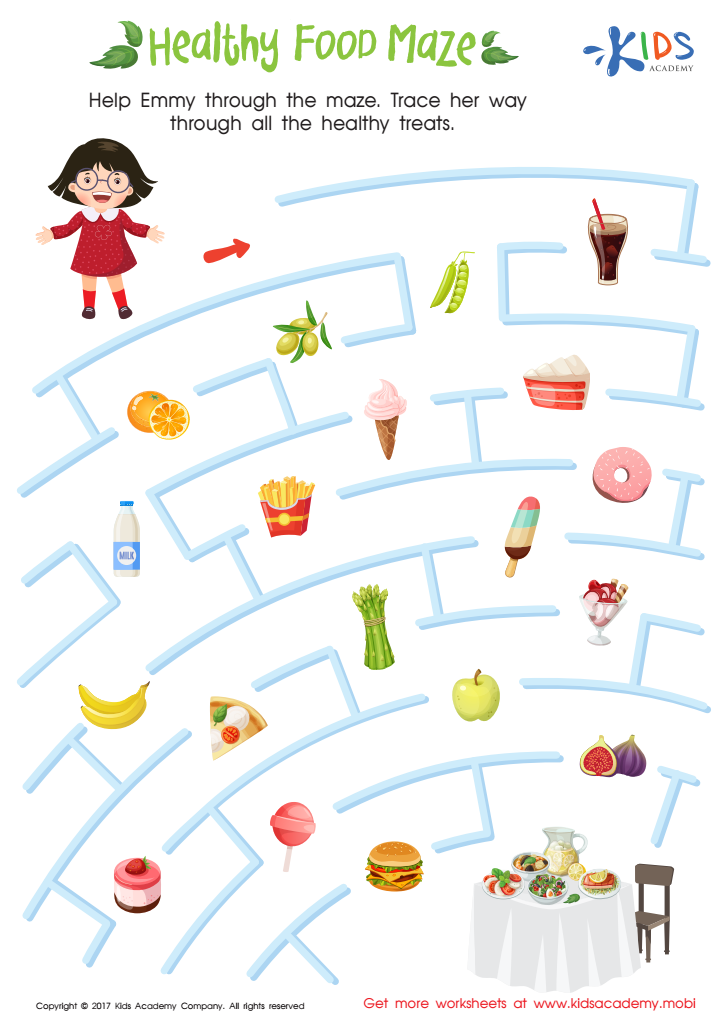
Healthy Food Maze Printable
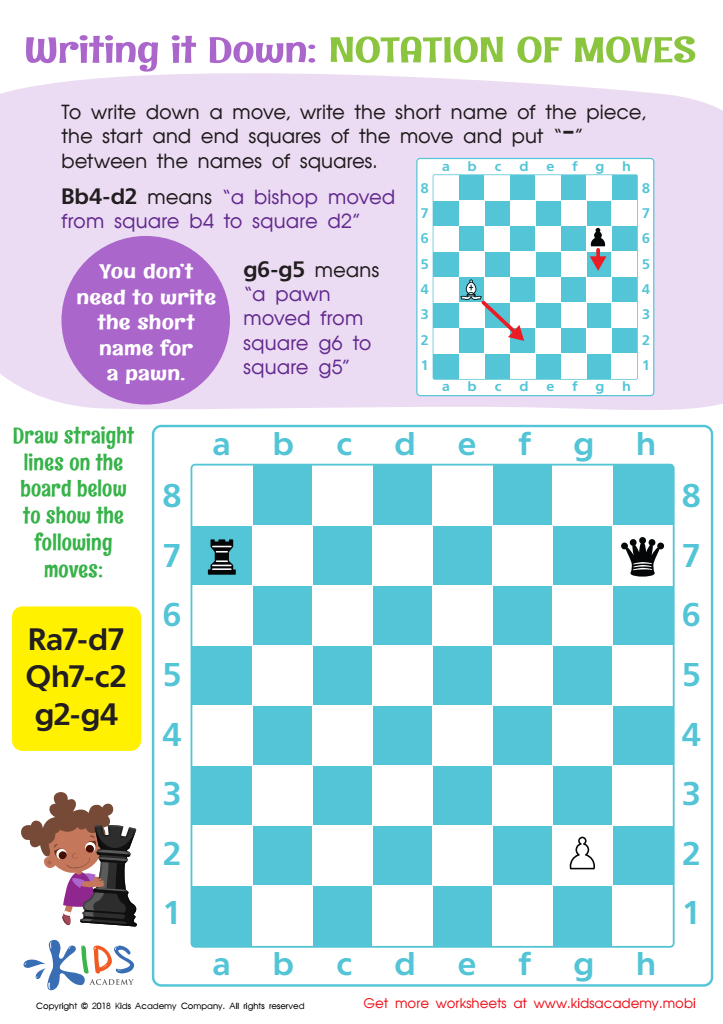
Notation of Moves Writing it Down Worksheet
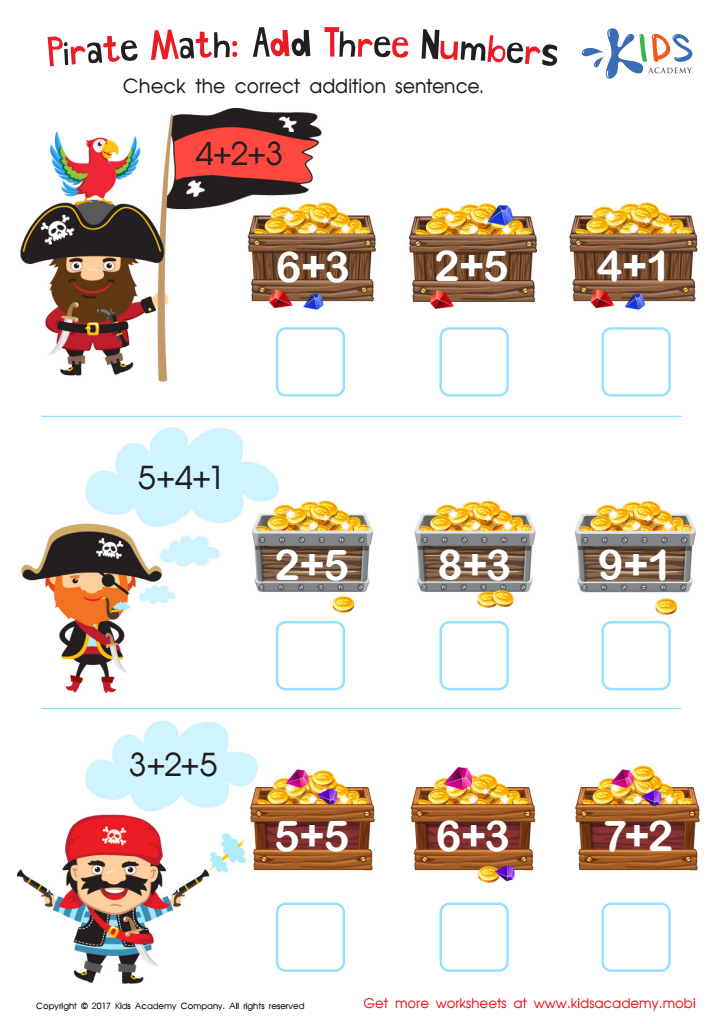
Pirate Math Printable
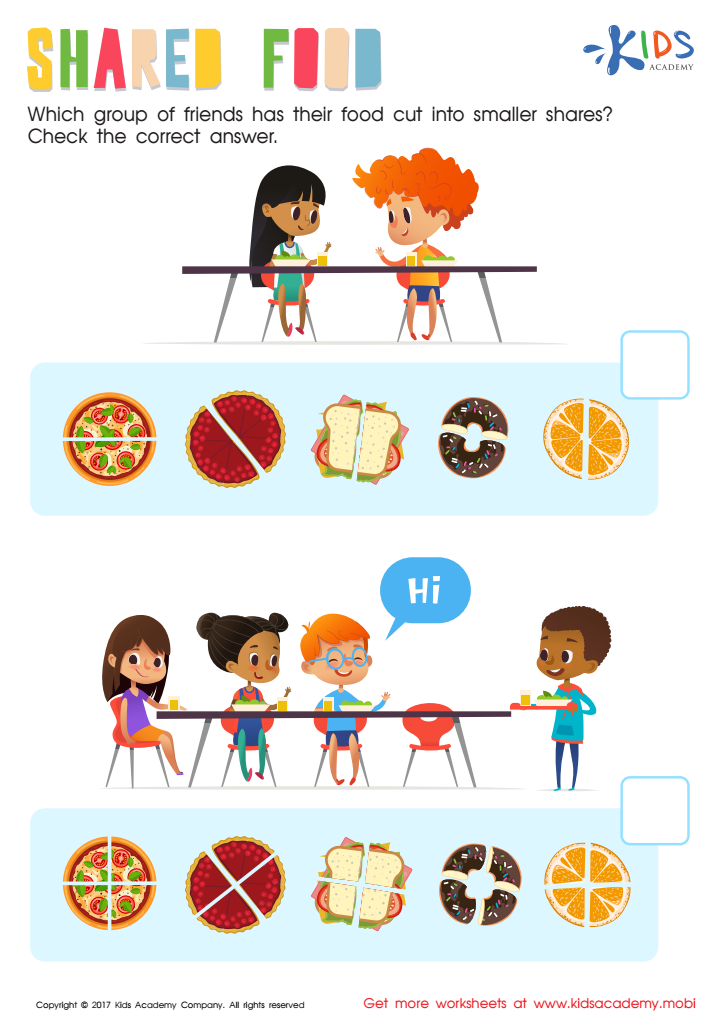
Shared Food Worksheet
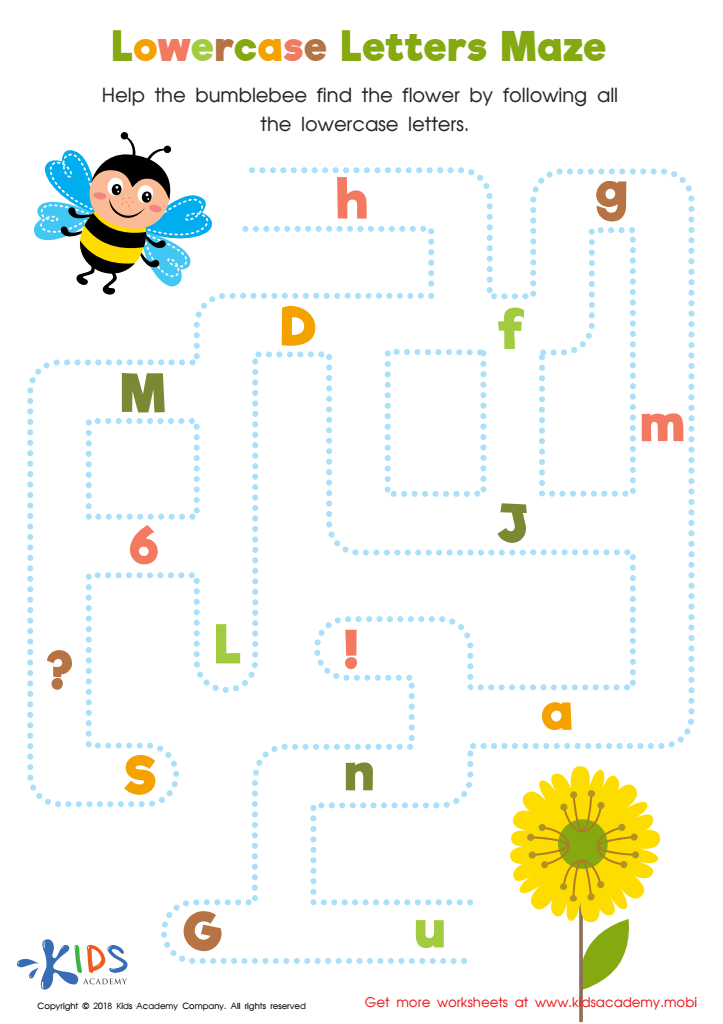
Lowercase Letters Maze Worksheet
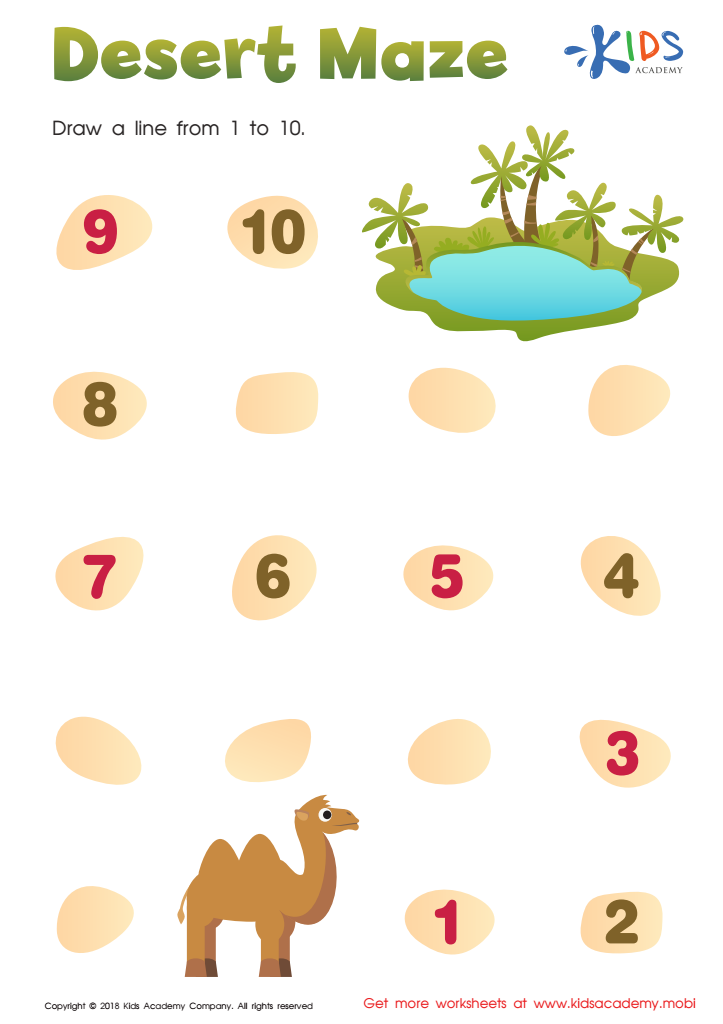
Desert Maze Worksheet
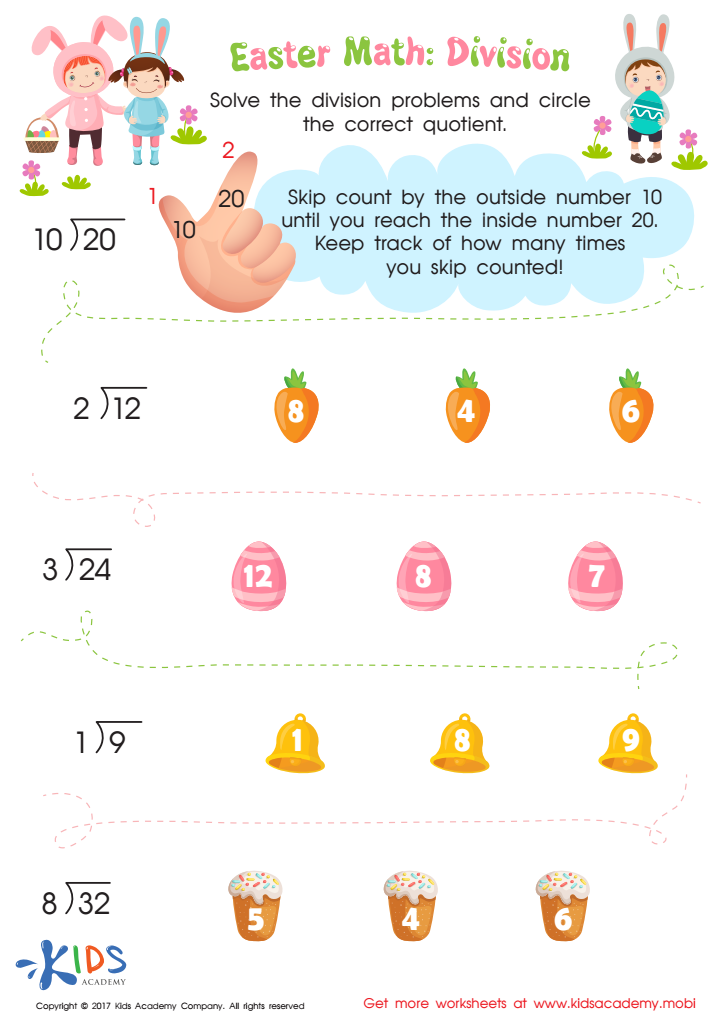
Division Worksheet
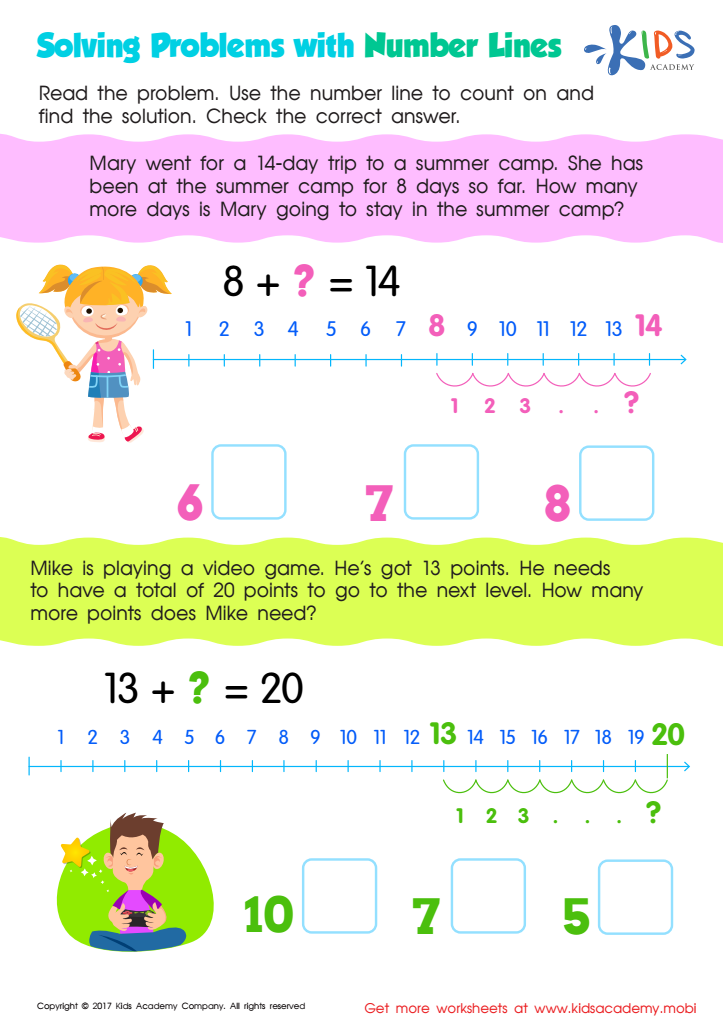
Solving Problems: Number Lines Worksheet
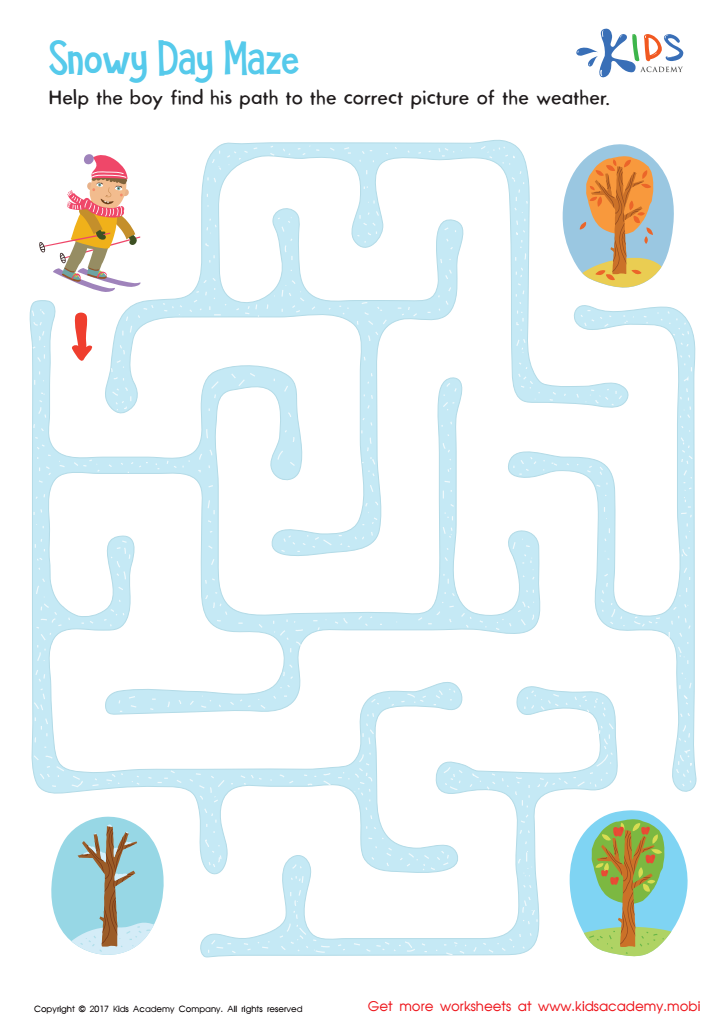
Snowy Day Maze Printable
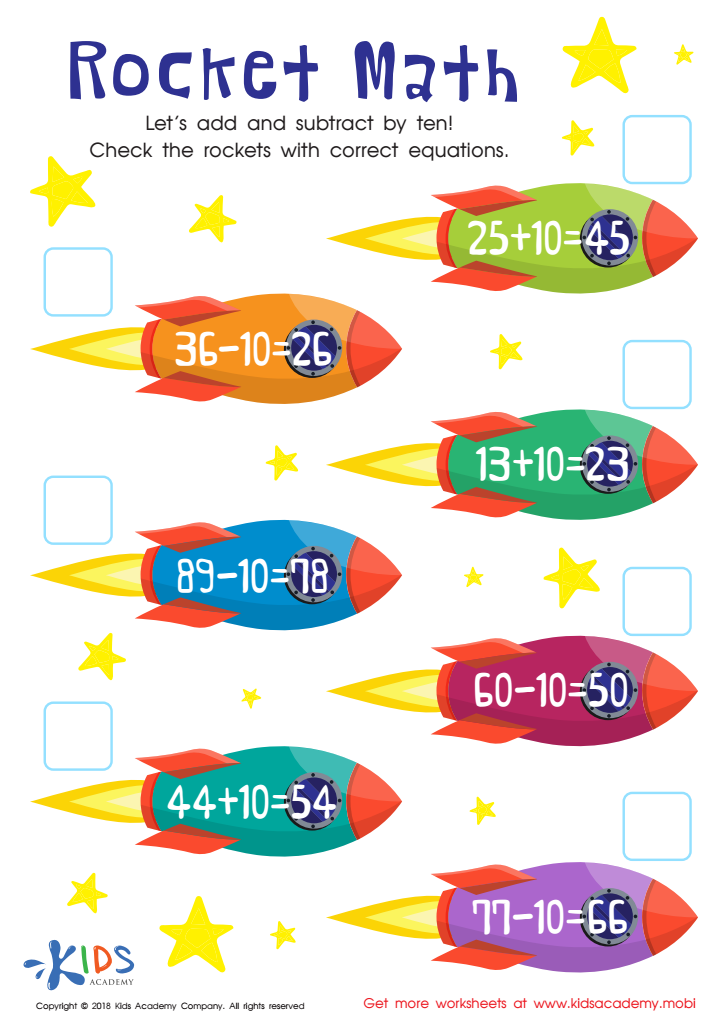
Rocket Math Worksheet
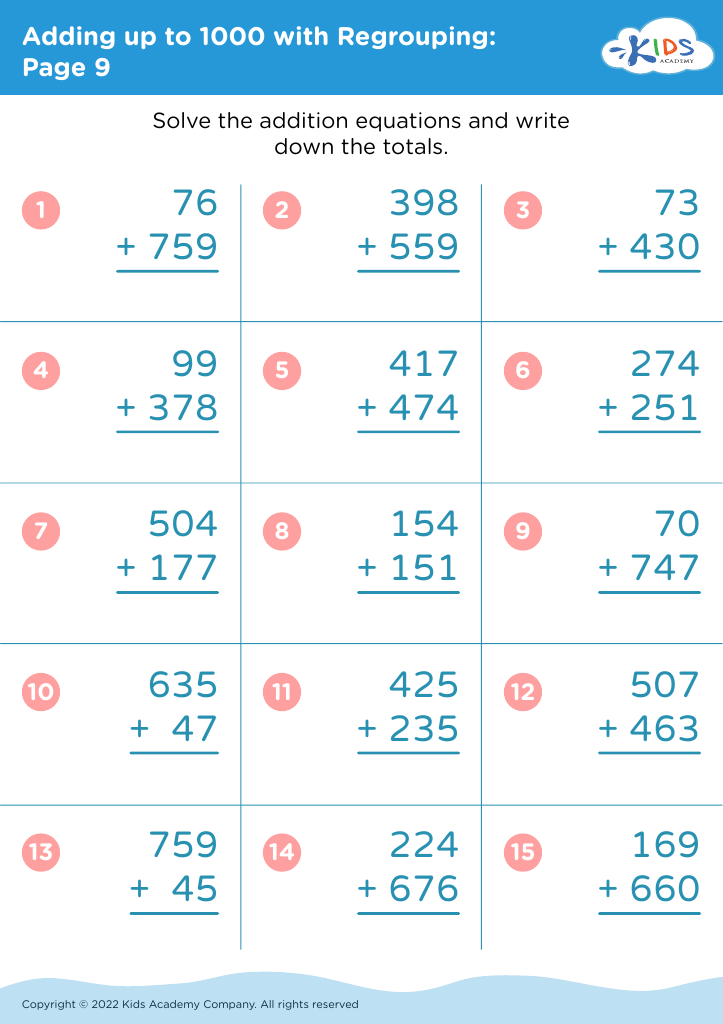
Adding up to 1000 with Regrouping: Page 9
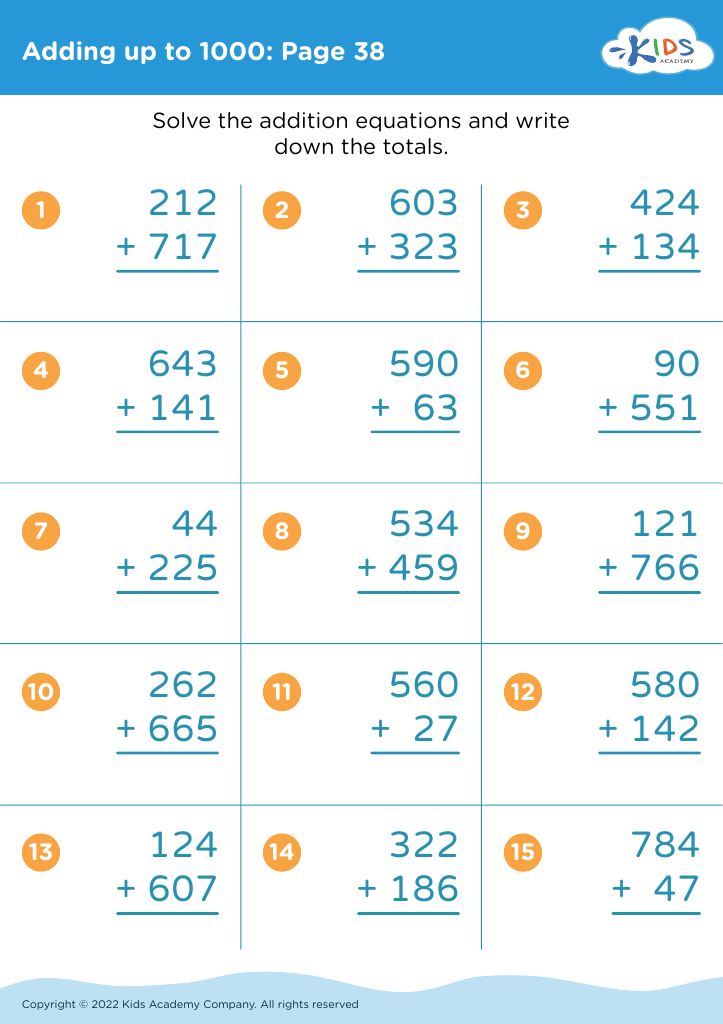
Adding up to 1000: Page 38
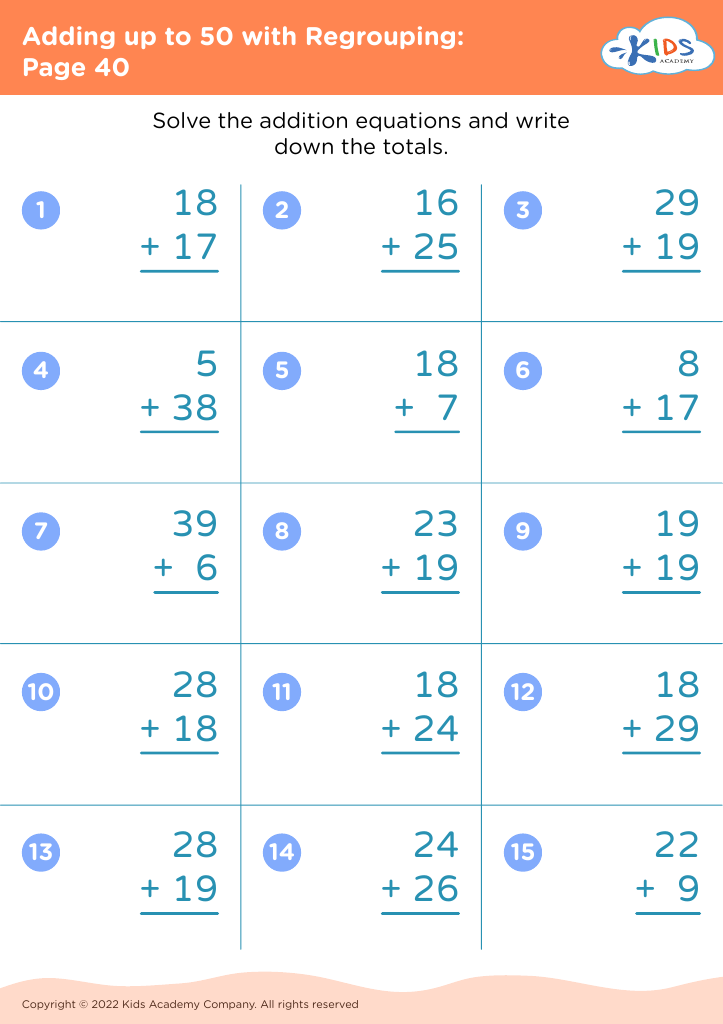
Adding up to 50 with Regrouping: Page 40
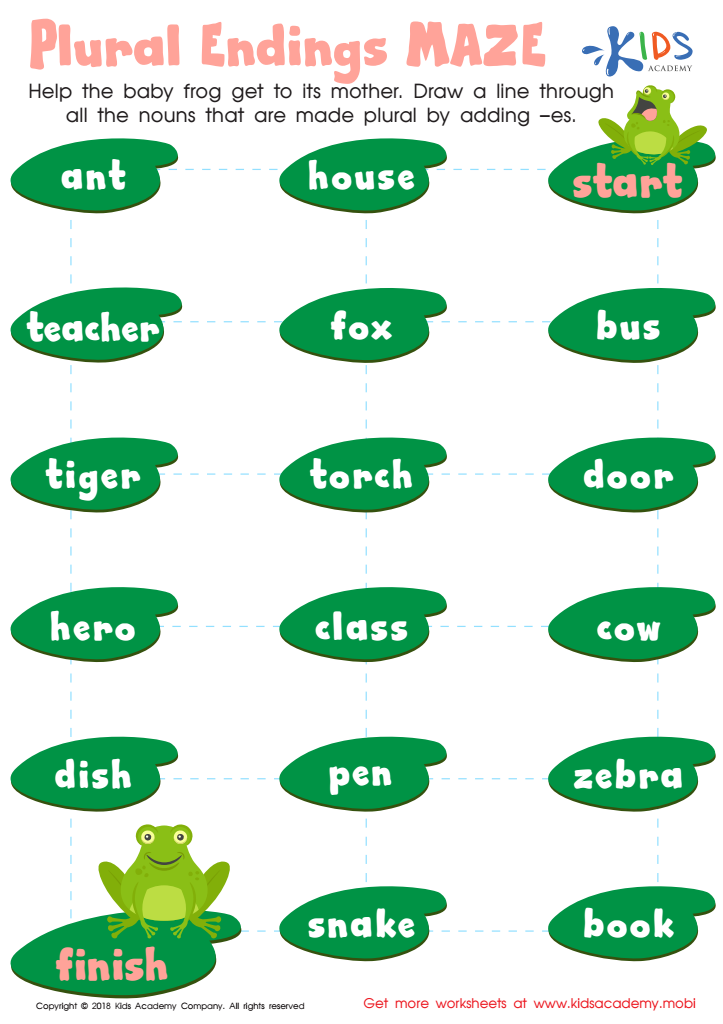
Plural Endings Maze Worksheet
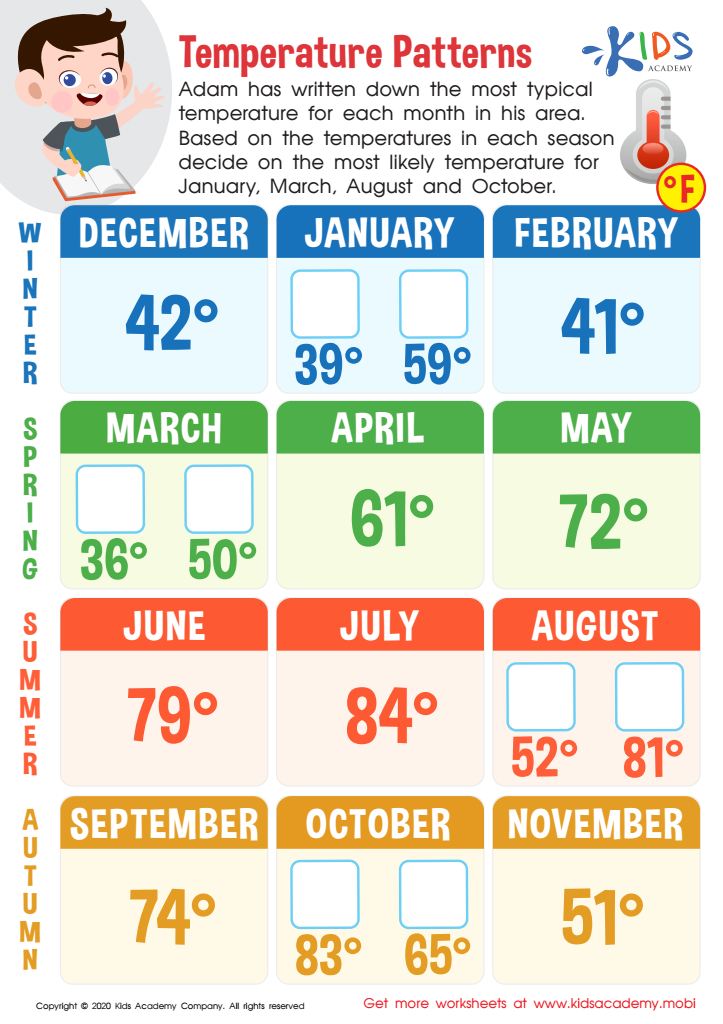
Temperature Patterns Worksheet

Adding up to 50: Page 61

Circus Math Printable

Counting and Comparing: Assessment 1 Worksheet
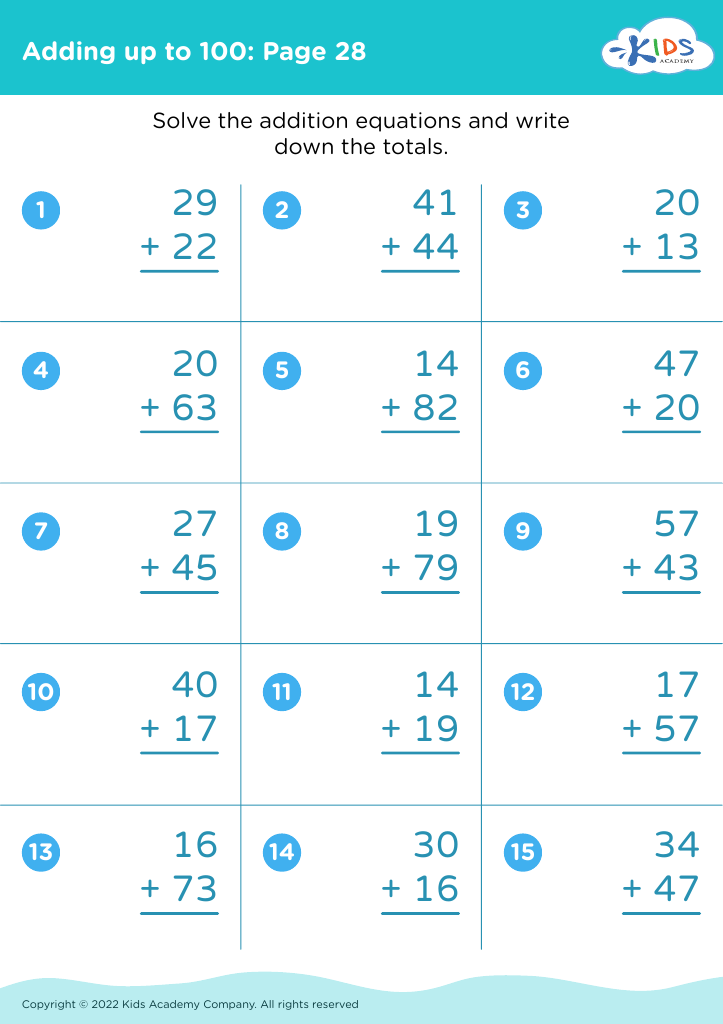
Adding up to 100: Page 28
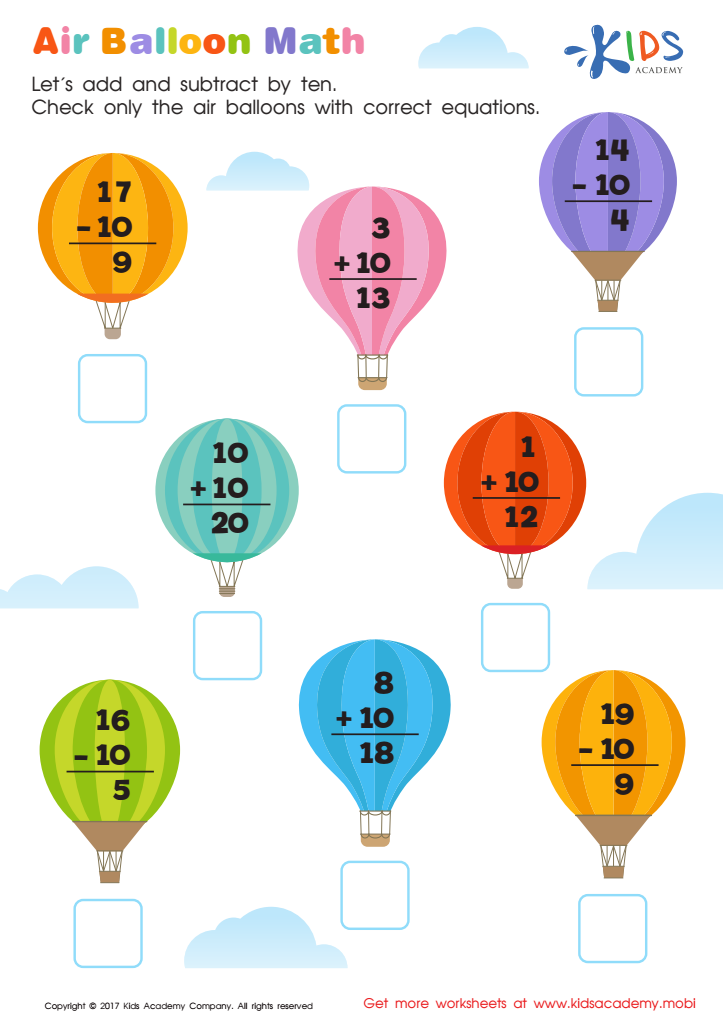
Air Balloon Math Worksheet
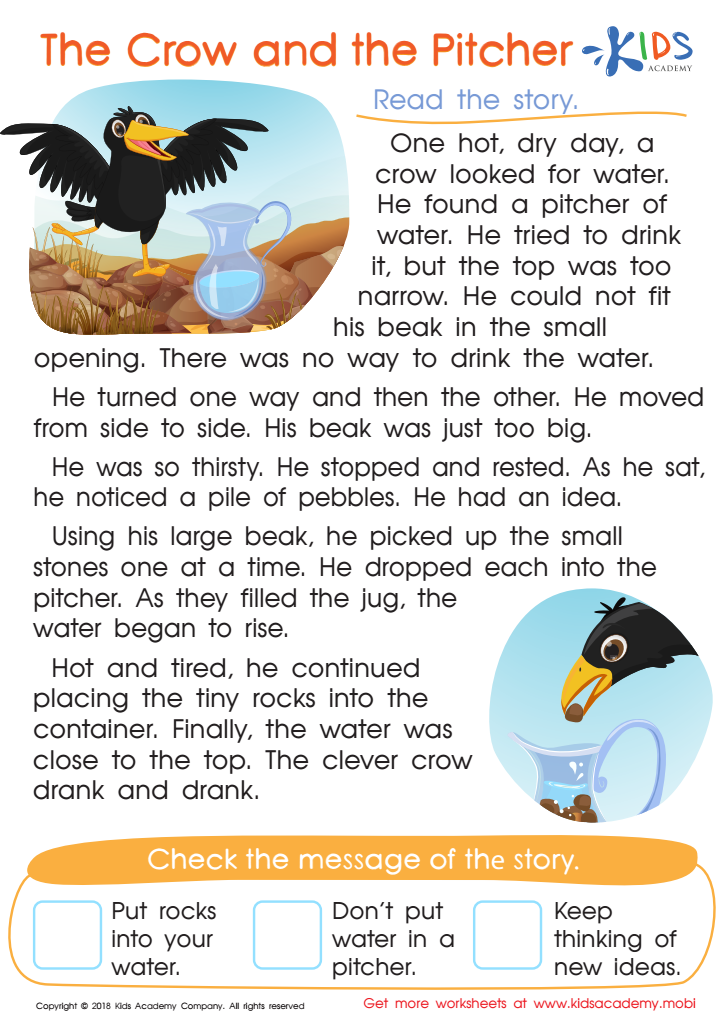
The Crow and the Pitcher Worksheet
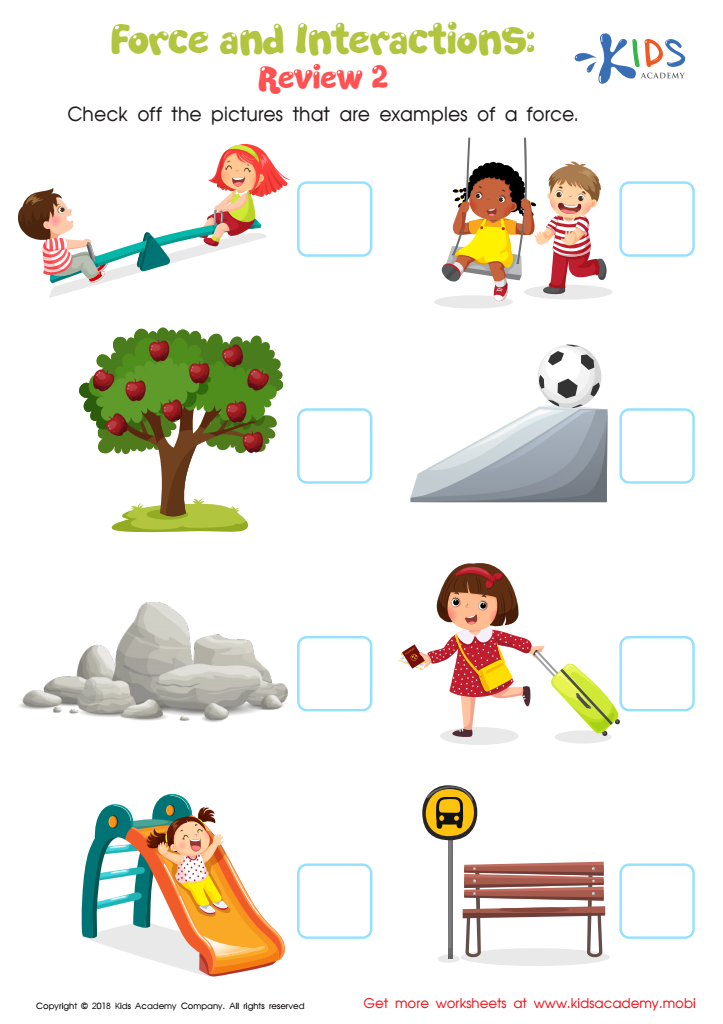
Force and Interactions: Review 2 Worksheet
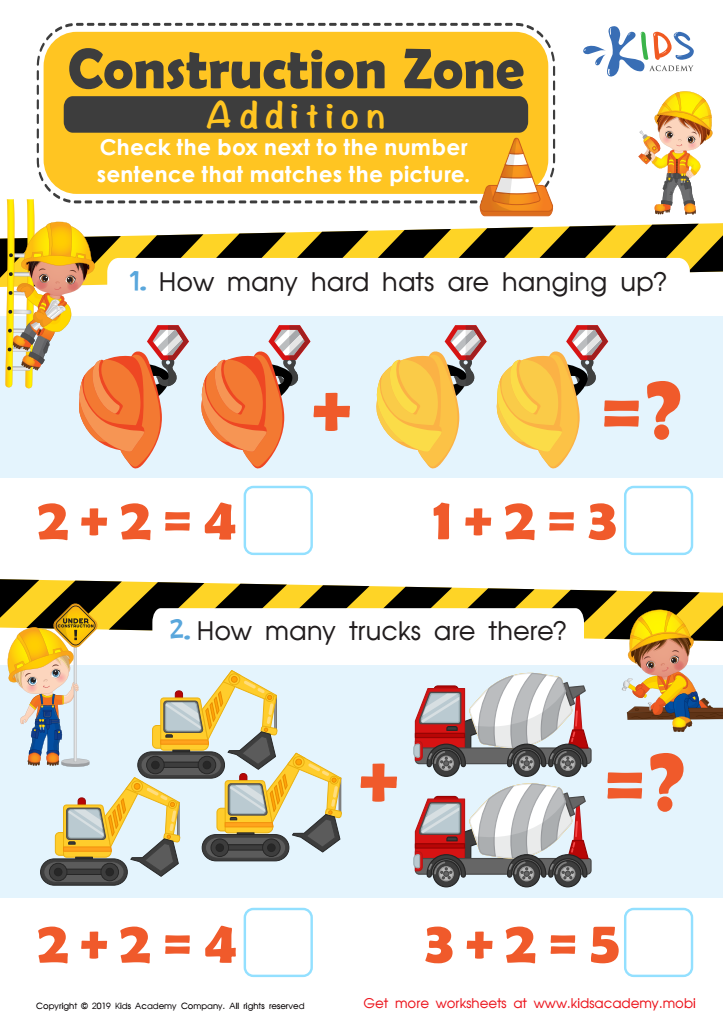
Construction Zone Addition Worksheet
Question/answer, how to test a grade 2 student’s problem-solving skills skills.
To test a Grade 2 student's problem-solving skills, present them with age-appropriate puzzles or challenges that require logical thinking, such as simple math word problems, pattern recognition tasks, and basic puzzles (e.g., jigsaw puzzles or mazes). Ensure the tasks vary in complexity and context to assess their ability to apply problem-solving strategies across different scenarios.
Why is the Problem-Solving Skills skill important for Grade 2 students?
Problem-solving skills are crucial for Grade 2 students as they help in developing critical thinking, creativity, and the ability to navigate challenges. These skills enable students to approach tasks and obstacles in a structured manner, fostering independence and confidence. Early development of these skills lays a strong foundation for academic success and real-world problem-solving in their futures.
How does the mastery of the Problem-Solving Skills skill affect a student's performance at an early age?
The mastery of problem-solving skills at an early age significantly enhances a student's performance by improving their ability to analyze situations, think critically, make decisions, and overcome obstacles. This foundational skill not only boosts academic success but also fosters independence, creativity, and resilience, preparing them for complex future challenges in both their educational journey and life experiences.
Related Articles

Related Worksheet

You'll be able to manage the favorite spreadsheets list.
You’ll be able to hide/mark the accomplished tasks.
- School / District Account
- Family Account
- 2 PDF worksheets per day
- Interactive worksheets
- Targeted ads
- KidsAcademy ads
$ 1.99 / month
- Printable and interactive worksheets
- Learning videos
- Ad-free browsing
$9.99 / month
- 7000+ online learning activities
- Curriculum created by education experts!
Cancel anytime
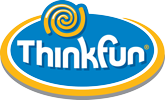
A Mission to Teach
Over 30 years ago, ThinkFun had one mission – to spark creativity, build problem-solving skills and inspire learning through play for children around the world. Today, our passion is even stronger. That’s why we offer free and fun downloadable logic games and brainteasers for every classroom, every teacher and every student.

Building Strategic Thinking
Want to improve your students’ strategic thinking and reasoning skills? It’s as easy as downloading, printing and letting them play these two-player games.
Click here for our free strategy games.

Brainteasers That Tease Their Brains
Brainteasers are the perfect way to stimulate young minds. Download these classic problem-solving games and watch your students’ minds at work.
Click here for our free brainteasers.

Make Math Fun
Addition, subtraction, division and even multiplication – our free, Math Dice teacher resources help teachers implement Math Dice games into their classroom.
Click here for free Math Dice resources.

Driving Logic Skills
One of our best-selling logic games ever can now be played in your classroom. Rush Hour teacher resources provide game ideas and instructions for any classroom.
Click here for free Rush Hour resources.

Thinky the Dragon
Awe students with Thinky the Dragon, an illusion that uses mathematical principals. Our free, downloadable template and videos are designed to teach through play.
Click here to download Thinky.
We want to hear from you
- Customer Feedback Survey
Microsites for our Games
- Robot Turtles
- International Customers
- Replacement Parts
- Instructions
- Media Center
- Education Blog
Subscribe for Updates
Problem-Solving Skills for Kids: 10+ Games, Activities & Worksheets
Teaching Problem Solving Skills for Kids is about more than just solving math problems or deciding who gets the last piece of pizza. It’s about preparing them for real life, where they face many situations every day that require quick and effective decision-making.
It’s important for parents and educators to guide children to think creatively and keep trying, rather than solving every problem for them.
For example, if two children want the same toy, instead of deciding for them, encourage them to talk and come up with a sharing plan. This approach not only solves the immediate issue but also teaches valuable lessons in negotiation and fairness.
Kids who learn problem-solving skills become good at seeing challenges as chances to learn and grow, not just obstacles.
Table of Contents
What Are Problem-Solving Skills?
Think about a time when you had a messy pile of shoelaces or blocks. It might have seemed tough at first, but then you figured out how to sort it all step by step. That’s problem-solving!
Problem-solving skills are like superpowers for handling all kinds of challenges. Whether it’s sharing toys with friends or choosing a game that everyone enjoys, these skills help you find smart solutions.
It’s not just about solving problems.
It’s about understanding them, thinking creatively, and sometimes working together.
So, the next time you face a tricky puzzle or situation, remember you’re ready to use your problem-solving skills.
Are you ready to be a problem-solving hero?
Why Kids Need Problem-Solving Skills?
Imagine you’re on a team, tasked with building the tallest tower using blocks. Everyone has ideas, but how do you choose the best one? This is where problem-solving skills are essential.
Problem-solving is not just about figuring things out by yourself; it involves teamwork, understanding various perspectives, and finding solutions that satisfy everyone. It’s like being a detective in everyday life, solving puzzles that make life smoother and more enjoyable for you and your friends.
Being good at solving problems means you can better manage difficult situations, like sharing fairly or adjusting when plans change. This skill boosts your independence and confidence because you know you can tackle any challenge.
Plus, excellent problem solvers are valuable team members and friends that everyone appreciates.
Building Resilience
When children tackle problems and figure out solutions, they become more resilient. This resilience allows them to recover from difficulties and adopt a positive, growth-focused attitude.
As children handle more challenges by themselves, they start to see problems as hidden opportunities.

Fostering Independence
Problem-solving skills help kids become more independent. By learning to think critically and make their own decisions, children grow to rely on themselves.
This self-reliance is key to becoming a responsible adult. When parents and teachers support these skills, they empower kids to manage their own lives.
Teamwork and Collaboration
Teamwork and collaboration involve kids working together to find solutions and reach goals. It teaches them to share ideas, listen to each other, and work as a team.
During problem-solving, they come up with ideas, talk about them, and choose the best one. Everyone plays a part and their ideas are important.
Teamwork helps kids learn to cooperate, respect different opinions, and use each other’s strengths. This way, they can overcome challenges and come up with creative solutions together.
Academic Success
Helping kids succeed in school is about more than just learning facts. it’s about teaching them how to solve problems. These skills allow kids to think deeply, understand different situations, and come up with solutions on their own.
Through group projects, tough puzzles, and hands-on experiences, kids learn to face challenges with creativity and determination.
As they get better at solving problems, they become more confident and flexible, which helps them do well in school and encourages a lasting passion for learning.
Types of Problem-Solving Skills
Problem-solving skills for kids include critical thinking, creativity, and resilience. They learn to analyze complex problems by breaking them into smaller parts. Creativity helps them think of different solutions.
Being able to communicate well allows them to share ideas and work with others. Persistence and resilience teach them to keep going, even when things get tough.
These skills help children confidently solve problems on their own, which helps them grow and develop.
Creative Thinking
Creative thinking is all about seeing things from a new perspective. When kids learn to think creatively, they can come up with innovative solutions to problems.
This skill is valuable not just in academics but in all areas of life.
Critical Thinking
Critical thinking involves analyzing information and evaluating different solutions. It’s essential for problem-solving because it helps kids make informed decisions.
Teaching kids to ask questions, seek evidence, and consider different viewpoints enhances their critical thinking skills .
Decision Making
Decision-making is the process of choosing between different options. This skill is closely related to problem-solving because it involves weighing the pros and cons of various choices.
Helping kids understand the impact of their decisions and guiding them through the process strengthens their problem-solving abilities.
Strategies to Teach Problem-Solving Skills
Ready to help your kids learn problem-solving? It’s a valuable skill that can be enjoyable to teach. Here are some great ways to help your children become skilled problem solvers.
Start with guided play, where you create scenarios or games that pose challenges. For example, building a bridge with blocks to avoid a “lava floor” or figuring out how to share snacks equally. Guided play offers a safe environment for children to experiment and discover solutions.
Then, try story-based problem-solving. Use stories to present problems, and after reading, ask, “What would you do in this situation? ” This encourages kids to think critically and creatively about the issues in the story.
Encourage them to ask questions like “What if?” and “ Why not? ” This boosts their curiosity and enhances their problem-solving skills as they explore different outcomes.
Also, lead by example. When you encounter a problem, share your thought process out loud. Show how you consider options and consequences before making a decision.
This real-life demonstration can greatly influence their learning.
By using these strategies, you’re not only teaching your children to solve problems, you’re also equipping them with skills to handle school, friendships, and future careers
Encourage Curiosity
Encouraging kids to be curious helps them get better at solving problems. When kids are free to ask questions and find answers, they start thinking more deeply and creatively.
This is important for solving problems well. If kids have a safe space to explore and make mistakes, they learn a lot from those mistakes.
Role-Playing Activities
Role-playing activities are fun and interactive games where kids pretend to be different characters, like detectives or doctors.
They face various challenges that require them to think creatively, solve problems, and make decisions. This helps them develop important skills such as understanding situations, working together with others , and effective communication.
Open-Ended Questions
Open-ended questions are those that kids can’t simply answer with a “yes” or “no.” They help children think creatively and critically, boosting their problem-solving abilities.
By asking such questions, adults encourage kids to express their ideas and reasoning, which deepens their understanding and helps them come up with their own solutions.
This not only improves their communication skills but also helps them see different viewpoints and explain their thoughts. Overall, this method nurtures curiosity and equips kids to approach problems with confidence and creativity.
Reflective Practice
Reflective practice in problem-solving helps kids think about how they solved a problem. They learn which strategies worked and which didn’t.
This reflection helps them get better at solving problems, builds critical thinking, and teaches them to keep improving. It makes them stronger and more effective problem solvers as they grow.
Problem-Solving Games and Activities
Problem-solving games are not only fun; they’re also excellent brain training, helping you become quicker and more creative at solving problems.
Consider playing a treasure hunt where you solve riddles to find clues or building a maze for a toy car that you navigate using a straw. These activities require quick thinking, strategy, and foresight, mirroring real-life problem-solving.
Activities range from puzzles, where you piece things together, to strategic board games . Even team sports and pretend adventures teach you to observe, analyze, and act on key problem-solving skills.
Why not try these engaging games? Each puzzle you solve or strategy you perfect helps you become a better problem solver.
Ready to learn while playing? Let’s start and discover the great solutions you can create!
Puzzles and Brain Teasers
Puzzles and brain teasers are fun ways to boost kids’ problem-solving skills. These challenges can be jigsaw puzzles, tricky riddles, or math puzzles, all designed to make kids think critically and creatively.
By solving them, kids learn to break down problems, be persistent, and find different solutions.
Jigsaw puzzles, Sudoku, Rubik’s cubes or Riddle Generator
STEM Challenges
Set up STEM (Science, Technology, Engineering, and Mathematics) challenges in which kids build structures with blocks , design paper airplanes, or create simple machines using household items.
Websites like NASA’s “STEM Activities for Kids” offer great resources.
Indoor/ Outdoor Scavenger Hunt:
Create a scavenger hunt in your backyard or a nearby park. Give kids a list of items to find or clues to follow, encouraging teamwork and problem-solving.
Learn More here at : Indoor scavenger Hunt , Nature Scavenger Hunt . Halloween Scavenger hunt
Scenario-based Activities
While problem-solving activities are fantastic for developing cognitive skills, it’s equally crucial to equip kids with the tools to handle social challenges.
One way to cultivate these skills is by engaging kids in scenario-based activities. Present various social situations and ask, “What will you do?” Then, offer four alternatives to choose from. like
- Your friend wants to play with your favorite toy, but you don’t want to share it. What will you do?
- During recess, you notice a classmate sitting alone and looking sad. What will you do?
- Someone in your class is being teased by others. What will you do?
- Your friend borrowed a book from you and accidentally ripped a page. What will you do?
- You’re playing a game with your friends, but one of them keeps cheating. What will you do?
These scenarios cover a range of social interactions and dilemmas. Allow kids to give their own Perspectives on each. Offering alternatives will ease their thinking process. Here is the “What will you do?” Worksheet to download and use.
Science Experiments:
Conduct simple science experiments at home that involve problem-solving, like creating a DIY volcano or testing the buoyancy of different objects.
Here is the list,
- Sink or Float
- Paper Airplane Engineering
- DIY Volcano
- Magnetic Attraction
- Color Changing Milk
- Gummy Bear Osmosis
- DIY Rainbow
Board Games:
Play board games that require strategic thinking and decision-making, such as chess, checkers, or strategy-based card games like Uno or Settlers of Catan. here is the List
- Settlers of Catan Junior
- Ticket to Ride
- Robot Turtles
- Rush Hour Junior
- Forbidden Island
Art Challenges:
Give kids art challenges like drawing a picture using only geometric shapes or creating a sculpture from recycled materials. This encourages creative problem-solving and thinking outside the box. Like
- Collage Making With magazines, colored paper, fabric scraps, buttons, and beads
- Painting with Unconventional Tools Like sponges, cotton swabs, toothbrushes, or even vegetables
- Found Object Sculptures Like twigs, stones, bottle caps, and cardboard.
- Story Illustration
- Mosaic Art With cardboard or wood
- Shadow Drawing
- Tape Resist Art on on a canvas or paper
Escape Room Challenges :
Design a DIY escape room at home with age-appropriate puzzles and riddles. Kids can work together to solve clues and unlock the “escape.”
Trial and Error
Trial and error is a fantastic way for Kids to learn and explore new things. Just like we navigate the complexities of new gadgets, kids can dive into the world of toys and games with curiosity and determination.
Instead of giving kids all the instructions upfront, encourage them to experiment with different ingredients and techniques.
The kid might make a mess or burn a few pancakes along the way, but through trial and error, [he/she] will gradually learn how to whip up delicious meals.
Problem-solving skills are essential for kids to grow and succeed. These skills help children become strong, independent, and skilled.
Parents and educators can teach problem-solving through fun methods like role-playing , games, or asking open-ended questions .
It’s important to equip kids with the right tools so they can confidently and creatively face any challenge.
😍 Want to Read More, Explore 👇 This Article
I’m a former teacher (and mother of Two Childs) with a background in child development. Here to help you with play-based learning activities for kids. ( Check my Next startup Cledemy.Com )
Leave a Comment Cancel reply
Save my name, email, and website in this browser for the next time I comment.

1 (844) 773-3822
26 Powerful Problem Solving Activities for Kids
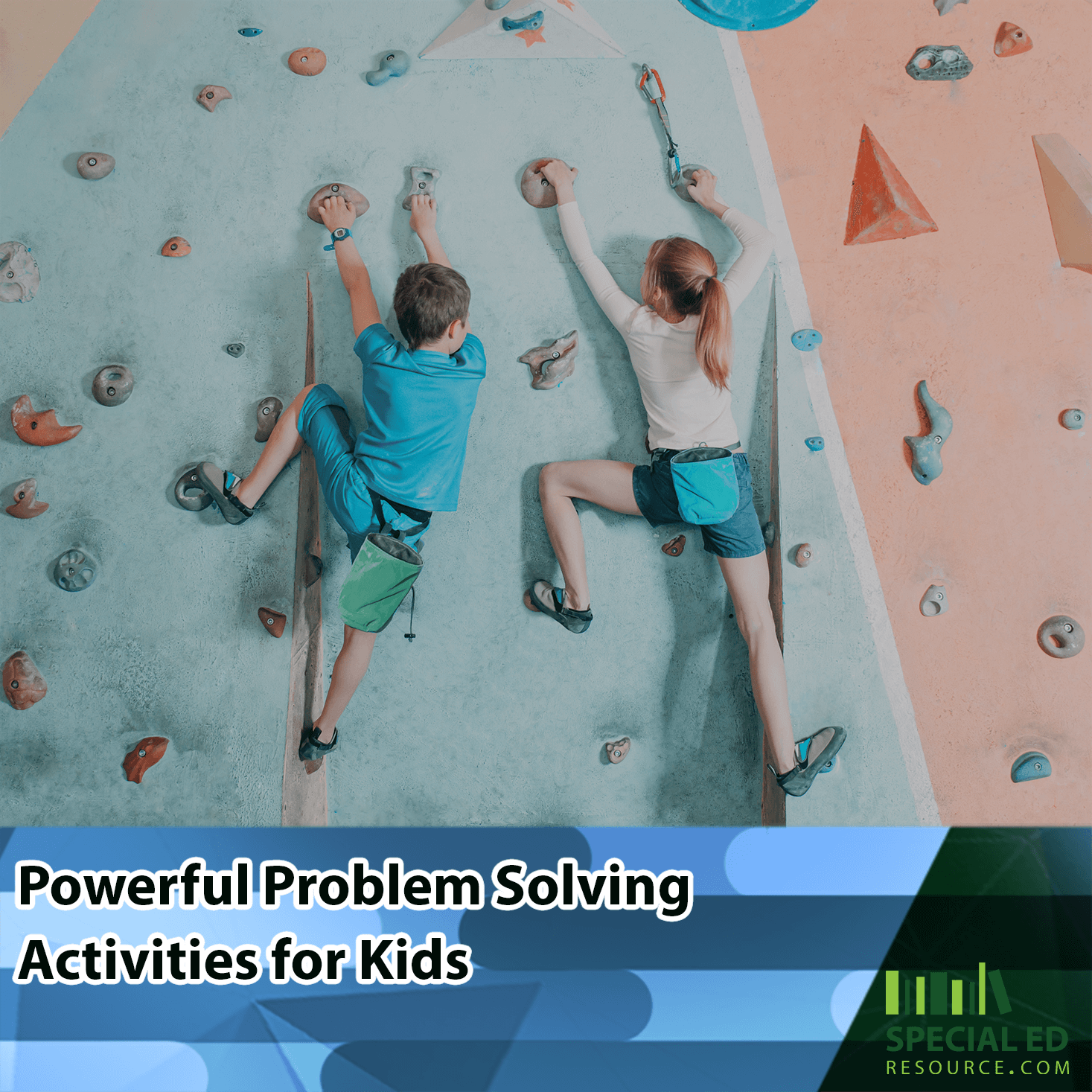
As you navigate the busy aisles of the grocery store, your child’s hand firmly in yours, you’re hit by a sudden realization. You’re not just shopping for groceries; you’re in the midst of an impromptu problem solving class.
Your child, curious and eager, starts asking you questions:
- “Why do we choose this cereal and not that one?”
- “How do we know how many apples to buy?”
In these moments, you’re more than a parent; you’re a guide, helping your child understand and navigate the world. It’s not always easy, especially when your child faces unique challenges.
You know their path is a little different, their learning style distinct. You want to equip them with skills beyond the basics and empower them to tackle the hurdles life throws their way.
Problem solving isn’t just about finding solutions; it’s about building resilience, confidence, and creativity.
You’ve seen it firsthand – the spark of understanding in your child’s eyes, the proud smile when they figure something out. These small victories remind you of the importance of nurturing these skills.
But where do you start? How do you turn everyday moments into enriching learning experiences?
One way is to challenge your children by regularly providing them with problem solving activities. Here is a list of ideas:
Want One-On-One Expert Help?!
Check this out.
#1 Puzzles and Brain Teasers
As you sit beside your child, engaging in a puzzle or brain teaser, you do more than spend quality time together. These activities are key in honing their problem solving skills, which are essential for their growth and development.
Why Puzzles and Brain Teasers Are Beneficial?
– enhances critical thinking: .
Your child learns to approach problems systematically, analyzing and forming strategies.
– Improves Concentration:
These activities require focus, helping your child develop a deeper concentration level.
– Builds Persistence:
Facing challenging puzzles teaches them not to give up easily, fostering resilience.
– Encourages Independent Problem Solving:
As they work through a puzzle, they learn to rely on their skills and intuition, boosting their confidence.
Examples for Different Age Groups
– younger elementary students (5-8 years): .
Start with jigsaw puzzles that have a moderate number of pieces. Simple word puzzles or riddles are also great to stimulate their thinking.
– Older Elementary Students (9-12 years):
Introduce more complex puzzles, like jigsaws with more pieces, logic puzzles, and basic Sudoku. These challenge their thinking and improve logical reasoning.
– Teenagers (13-18 years):
Engage them with advanced puzzles, such as 3D puzzles, crosswords, and challenging brain teasers that require abstract thinking.
When choosing these activities, consider your child’s interests and abilities to keep them motivated and engaged. It’s not about the complexity of the puzzle but the process of finding solutions and the learning that comes with it.
As they tackle these challenges, they’re not just solving puzzles. They’re building skills that will help them navigate the complexities of life.
Role-Playing Games
Envision your child diving into the world of a detective, a scientist, or a historical figure. Through role-playing games, they’re not just engaging in play.
They’re sharpening their problem solving skills imaginatively and dynamically.
Benefits of Role-Playing Scenarios
– fosters creative problem solving: .
Role-playing challenges your child to think on their feet, creating solutions in diverse scenarios.
– Develops Empathy and Social Awareness:
Taking on different roles helps them understand various perspectives, building empathy and social skills.
– Strengthens Communication Abilities:
These activities encourage clear and effective communication , vital for problem solving.
– Tailored to Individual Learning Styles:
Role-playing can be adapted to suit your child’s unique needs and interests, making it an inclusive learning tool.
Role-Playing Ideas
#2 mystery detective: .
Set up a mystery game where your child has to find clues and solve a case. This can be made more complex for older children, involving critical thinking and deductive reasoning.
#3 Historical Role-Play:
Have your child take on the role of a historical figure. They can navigate historical events, making decisions based on the context, which enhances their understanding of history and its challenges.
#4 Science Explorer:
Create scenarios where your child is a scientist or an explorer facing environmental or scientific problems. They can develop innovative solutions, fostering a love for science and exploration.
#5 Future World Builder:
Engage older children and teens in creating and managing a city or civilization in the future. This kind of role-play involves strategic planning, resource management, and ethical decision-making.
When engaging in these activities, the focus should be on learning through experience and fun. Encourage your child’s imagination, validate their ideas, and guide them through the problem solving process.
Remember, role-playing is a powerful tool that can make learning enjoyable and impactful for your child.
Building and Construction Projects
Whether it’s a simple craft project or a more complex construction task, these activities are not just about creating something tangible. They’re about building problem solving skills.
Why Building Activities Enhance Problem Solving?
– encourages practical thinking: .
As your child figures out how to assemble parts, they learn to think logically and sequentially.
– Develops Spatial Awareness:
Understanding how different pieces fit together improves their spatial intelligence.
– Fosters Creativity and Innovation:
They’ll learn to think creatively as they design and build, especially when improvising solutions.
– Teaches Planning and Organization:
Planning out a project helps develop organizational skills and forward-thinking.
Safe and Accessible Building Project Ideas
#6 cardboard creations: .
Use cardboard boxes to build anything from simple houses to intricate castles. This is safe, easy, and allows for endless creativity.
#7 DIY Birdhouse or Insect Hotel:
Older children can take on projects like building a birdhouse or an insect hotel, which involves more planning and precision.
#8 Recycled Material Sculptures:
Encourage your child to create sculptures using recycled materials. This not only sparks creativity but also teaches the value of recycling.
#9 Simple Woodworking Projects:
Consider basic woodworking projects for teenagers, like a small shelf or a picture frame. Ensure supervision and safety measures are in place.
Remember, the goal is to challenge yet not overwhelm. Start with simpler projects and gradually increase complexity based on your child’s interest and skill level.
Encourage their efforts, celebrate their successes, and most importantly, enjoy the process of building and learning together. This is where practical skills meet creativity, leading to effective problem solving.
Technology and Problem Solving Activities
In today’s digital age, apps and games can be much more than distractions; they can be tools for learning and development.
Why Technology Aids Problem Solving?
– interactive learning: .
Digital platforms offer interactive experiences that keep children engaged and actively learning.
– Adaptive Challenges:
Many apps and games adjust their difficulty based on your child’s progress, providing a continuous and appropriate challenge.
– Visual and Auditory Stimulation:
Graphics and sound in digital games enhance cognitive skills and problem solving abilities.
– Accessibility:
Technology can offer tailored learning experiences, especially beneficial for children with special needs.
Recommended Apps and Games
#10 puzzle games: .
Look for puzzle apps that challenge spatial reasoning and logical thinking. Examples include tangram-based games or block-fitting puzzles.
#11 Strategy Games:
Games that require planning and strategy, like turn-based strategy games or resource management simulations, are great for older children.
#12 Coding for Kids:
Introduce basic programming concepts through kid-friendly coding apps. These teach logical thinking and problem solving in a fun, interactive way.
#13 Educational Adventure Games:
Choose adventure games incorporating math, science, or language puzzles within an engaging storyline.
When selecting apps and games, focus on age-appropriate ones, considering your child’s interests and skill levels. The goal is to find digital tools that challenge and educate, not just entertain.
Encourage your child to reflect on what they learn and apply these skills beyond the screen. In this way, technology becomes a valuable ally in developing your child’s problem solving abilities.
#14 Escape Room Games
Visualize your child and their friends (or your family) immersed in the thrilling world of an escape room. This isn’t just an exciting game. It’s a dynamic learning experience where essential skills are developed as they work to solve puzzles and ‘escape.’
Benefits of Escape Room Activities
– teamwork: .
Escape rooms are a fantastic way for kids to learn the value of teamwork. They discover the importance of working together, communicating effectively, and sharing tasks to achieve a common goal.
– Critical Thinking:
These games push children to think outside the box. They must look beyond the obvious, develop creative solutions, and apply critical thinking to overcome challenges.
– Communication:
Effective communication is crucial in escape rooms. Your child learns to express their ideas clearly, listen to others, and collaborate to solve puzzles.
– Problem Solving:
Escape rooms are all about solving a series of puzzles. Kids learn to identify problems, analyze them, and develop creative solutions under pressure.
Creating an Escape Room Experience at Home
– diy home escape room: .
Set up a simple escape room at home. Use clues related to your child’s interests, and create challenging yet solvable puzzles. It can be a simple treasure hunt with clues leading to the next step.
– Escape Room Board Games:
There are board games available that mimic the escape room experience. These are great for rainy days or quiet evenings at home.
– Digital Escape Rooms:
There are also digital escape room experiences, perfect for children who enjoy online gaming. Choose ones that focus on teamwork and problem-solving that are age-appropriate.
Remember, the goal is to challenge and engage your child in a fun, collaborative way.
Through escape room activities, they enjoy an exciting adventure and develop essential life skills that will serve them well academically and personally.
#15 Indoor Rock Climbing
This activity is often overlooked, but it’s an incredible way for children of all ages and abilities to develop many skills beyond physical strength.
Multifaceted Benefits of Indoor Rock Climbing
– problem solving skills: .
As your child figures out the best climbing route, they use critical problem solving skills. Deciding which hold to grab next requires quick thinking and strategy, skills transferable to everyday challenges.
– Coordination:
Rock climbing demands a harmony of movements between hands and feet. This enhances your child’s coordination, a valuable skill in many other aspects of their life.
– Strength Building:
Climbing strengthens not just the arms and legs but the entire body. It’s a full-body workout that improves physical strength and endurance.
– Stamina Development:
Maintaining their position on the wall for an extended period builds stamina. This persistence is mirrored in their ability to stay focused on other activities.
– Focus and Concentration:
Successfully climbing requires complete concentration. Your child learns to focus their mind on the task at hand, a skill that’s invaluable in school and other settings.
– Self-discipline:
Rock climbing teaches self-control and emotional regulation . Staying calm and composed on the wall is essential for safety and success.
– Boosting Confidence:
Each climb is a boost to your child’s self-esteem . Believing in their abilities to reach the top instills a sense of accomplishment and confidence.
Getting Started with Indoor Rock Climbing
– find a kid-friendly facility: .
Look for indoor climbing centers that offer sessions for children. They provide the necessary equipment and guidance in a safe environment.
– Start with Basic Walls:
Begin with walls designed for beginners, gradually moving to more challenging climbs as your child gains confidence and skill.
– Encourage Regular Practice:
Consistency is key. Regular climbing sessions will help your child improve their skills steadily.
Remember, rock climbing is not just about reaching the top; it’s about the journey. Each step your child takes up that wall is a step towards building essential life skills in a fun, engaging, and challenging environment.
#16 Obstacle Courses
Imagine setting up a fun, engaging obstacle course in your backyard or living room. This isn’t just an entertaining activity for your child. It’s a comprehensive learning experience that builds many life skills.
Valuable Life Skills Gained from Obstacle Courses
– teamwork and cooperation: .
Obstacle courses often require collaboration. Your child learns the importance of working together, sharing strategies, and helping peers to achieve common objectives.
Each obstacle presents a unique challenge. Your child learns to think quickly, devise strategies, and find creative solutions to navigate through them.
– Perseverance and Determination:
Obstacle courses can be challenging, teaching your child the value of persistence and grit. They learn to keep trying, even when faced with challenging tasks.
– Large Motor Fitness:
These courses are excellent for enhancing physical fitness, improving strength, balance, and coordination.
– Mental Fitness:
Besides physical agility, obstacle courses sharpen mental skills like focus, concentration, and stamina.
Setting Up a Simple Obstacle Course
– indoor course: .
Use household items like chairs, cushions, and tables to create a safe indoor course. This can include crawling under tables, hopping between cushions, or balancing along a taped line on the floor.
– Outdoor Course:
Use natural elements like trees, hills, or simple items like ropes and hula hoops for outdoor space. Set up tasks like weaving between trees, climbing small hills, or jumping through hoops.
– Incorporate Diverse Activities:
Add variety to your course with activities like throwing a ball into a bucket, balancing a book on the head, or hopping on one foot. This keeps the course dynamic and engaging.
Remember, the primary goal is to have fun while learning. Encourage your child, celebrate their successes, and perhaps even join to model teamwork and sportsmanship.
Through obstacle courses, your child enjoys physical activity and develops crucial life skills in an exciting and hands-on way.
Cooking and Baking Projects
Cooking and baking are not just about creating delicious treats; they’re an excellent way for your child to learn and practice many skills.
Skills Developed Through Cooking and Baking
– math and measurement skills: .
Recipes require measuring ingredients, which is a practical way for your child to learn about fractions, volumes, and weights.
– Reading and Comprehension:
Following a recipe improves reading skills and comprehension. Your child learns to follow instructions and understand the sequence of steps.
– Science and Chemistry:
Cooking is a fun way to introduce basic science concepts. They’ll learn about chemical reactions, like how yeast makes dough rise or how heat changes food.
– Creativity and Experimentation:
Encourage your child to be creative, whether decorating cookies or experimenting with flavors. This fosters their artistic side and teaches them about trial and error.
– Life Skills and Independence:
Cooking and baking are essential life skills. By learning these, your child gains a sense of independence and accomplishment.
Ideas for Cooking and Baking Projects
#17 simple recipes: .
Start with easy recipes like no-bake cookies, fruit salads, or sandwiches. These are perfect for younger children.
#18 Theme Cooking:
Make cooking more engaging by tying it to a theme or a subject they’re learning in school, like baking pies when learning about circles in math.
#19 International Cuisine:
Explore recipes from around the world. This not only introduces new flavors but also teaches about different cultures.
#20 Weekly Cooking Day:
Dedicate one day a week to cook or bake something special with your child. It could be a time to try new recipes or perfect old favorites.
Remember, the kitchen is a fantastic classroom. It’s a place where your child can learn, make mistakes, and enjoy the fruits of their labor! Encourage them, guide them, and most importantly, have fun together in this delicious learning journey.
Incorporating Everyday Situations
As you go about your daily routine with your child, consider the myriad learning opportunities in these simple moments. Everyday tasks, often overlooked, are fertile ground for developing problem solving skills.
Turning Routine Activities into Problem Solving Exercises
#21 grocery shopping: .
Turn a regular shopping trip into a math lesson. Have your child help with making a budget, calculating discounts, or comparing prices. They learn about money management, estimation, and decision-making.
#22 Planning a Route:
If you’re heading out to multiple places, involve your child in planning the route. Discuss factors like distance, time, and traffic. This teaches them about logistics, time management, and geographical orientation.
#23 Organizing Spaces:
Ask your child to think of the best way to organize it, whether it’s their room, a bookshelf, or the living room. This encourages them to think about space utilization, categorization, and orderliness.
#24 Meal Planning:
Involve them in meal planning for the week. They can help decide the menu, ensuring a balance of nutrition. This teaches them about health, planning, and the importance of variety.
#25 DIY Home Projects:
Simple home projects, like planting a garden or painting a fence, can be excellent problem solving exercises. They learn about the process, the necessary materials, and the steps to complete a project.
#26 Time Management:
Encourage your child to plan their day or week, balancing schoolwork, chores, and leisure. This helps them develop critical time management and prioritization skills.
Each of these activities, while mundane, is an opportunity for your child to think critically, make decisions, and solve problems.
The key is actively involving them, asking open-ended questions, and encouraging them to think through their choices.
This way, everyday tasks become more than just chores. They become stepping stones in your child’s developmental journey.
Tips for Success
As you embark on these activities with your child, keeping them engaged and motivated is crucial. Here are some practical tips:
Keeping Children Engaged and Motivated
– set achievable goals: .
Start with simple tasks and gradually increase the difficulty. Achieving these smaller goals will boost your child’s confidence and motivation.
– Incorporate Their Interests:
Tailor activities to include your child’s hobbies or favorite subjects. This personal connection makes learning more exciting and relatable.
– Offer Positive Reinforcement:
Praise their efforts, not just the outcomes. Celebrate their progress and perseverance, which encourages a growth mindset .
– Create a Routine:
Establishing a consistent activity schedule helps build discipline and a sense of anticipation.
– Provide Choices:
Give your child options in activities or ways to complete them. This sense of control can be very motivating.
– Break Down Tasks:
For complex activities, break them into smaller, manageable steps. This makes the task more manageable and more approachable.
Adapting Activities for Children with Special Needs
– simplify instructions: .
Use clear, concise language and visual aids if necessary. Breaking instructions into smaller steps can be very helpful.
– Flexible Approach:
Be open to adapting activities based on your child’s needs. This could mean altering the pace, reducing sensory inputs , or providing additional support.
– Incorporate Sensory Activities:
For children who benefit from sensory input, include activities that engage different senses .
– Use Assistive Technology:
For children with physical or learning disabilities, utilize available technology to facilitate their participation and learning.
– Foster a Safe Environment:
Ensure the learning environment is safe, supportive, and free from unnecessary pressures or distractions.
– Collaborate with Educators and Therapists:
Work with your child’s teachers or therapists to align activities with their educational and therapeutic goals.
Remember, being patient, adaptable, and responsive to your child’s needs and responses is vital. Your support and encouragement can make a significant difference in their learning journey.
As you step into this journey of enriching your child’s learning through these diverse activities, remember that each moment spent together is about achieving a goal and creating lasting memories and invaluable learning experiences.
Your role in guiding and supporting your child through these activities is a powerful force in their development.
We would love to hear about your adventures and discoveries. Share your stories with us in the comments below!
Whether it’s the proud smile of your child solving a puzzle, the excitement of completing a DIY project, or the laughter that fills your kitchen during a cooking session, your experiences can inspire and encourage other parents embarking on similar journeys.
Additional Resources for Learning
- 29 Fun Activities to Help Kids Focus (With Proven Results)
- Fun Winter Break Activities for Kids Guaranteed to Bust Boredom
- 21 Simple & Fun Gratitude Activities for Kids
- The Ultimate Guide to Summer Learning Activities (Your Child Will Love)
If you enjoyed this article, please consider sharing it on Pinterest and Facebook. Join our Special Ed Parenting Facebook Community to connect with other parents of special needs children.
Do you have a child that needs one on one assistance?
We offer one-on-one special education tutoring that can be done from anywhere the student is! Why? Because our special education experts conduct their sessions online!
Get started with a free consultation today!
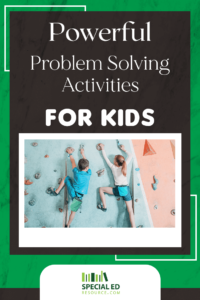
Shannah Holt
Leave a reply cancel reply.
Your email address will not be published. Required fields are marked *
Name *
Email *
Add Comment *
Save my name, email, and website in this browser for the next time I comment.
Post Comment
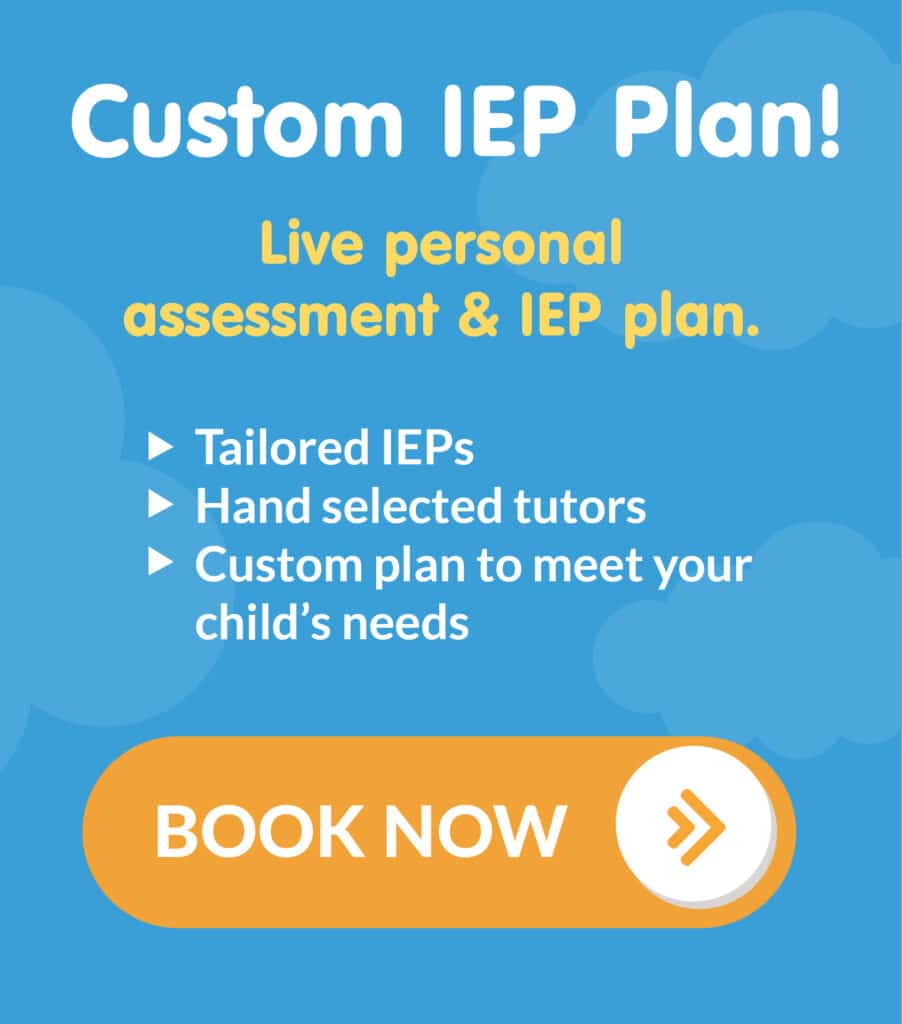
Our Services
- Special Education Tutoring
- IEP Consulting
- Special Needs Advocacy
- Home Schooling

Popular Articles
7 step iep process.
- Creative Writing Activities
- Activities to Help Kids Focus
- Self-Contained Classroom Defined
- 10 Benefits of Special Needs Tutoring
- Advantages of SQ3R Reading Method: Proven Study Strategy for Kids
- 47 Visual Perception Activities for Kids of All Ages
- What is Visual Processing Disorder in Children
- 51 Executive Functioning Activities for Teens
- What is Cognitive Behavioral Therapy for Children?
- Classroom Accommodations for Executive Function Disorder
Think Differently About Education. We Believe…
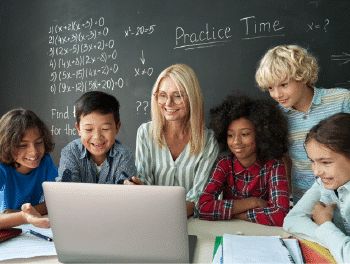
We assess your child’s learning style, personality, and interests to pair them with the ideal special ed tutor based on their individual needs.

Through technology and one on one learning, their future path to success can be made clear again.
Are you ready to see confident progress in your child?
Get started with a no-obligation consultation today!

There are hundreds of resources found on our website, SpecialEdResource.com, and on our YouTube channel that were created to help parents JUST LIKE YOU understand the cryptic language of special education.
Important Links
Copyright © 2024 SpecialEd Resource – Design by DeskTeam36 0
- Terms & Conditions
- Privacy Policy
Home » Games » 17 Fun Problem Solving Activities & Games [for Kids, Adults and Teens]
17 Fun Problem Solving Activities & Games [for Kids, Adults and Teens]
Everyone should learn problem solving, as it is important in both our personal and professional lives. Problems occur all around us and many people react with spontaneous emotion. Instead, effective use of problem solving skills can lead to rational thinking, a component of any successful endeavor.
Creative problem involves using one or more of the basic steps of problem solving in exercises designed to challenge the thinking. Problem solving activities work for every age group. In this article, we will present problem-solving activities for adults and kids. We will also provide you with group and team building problem solving ideas.
Table of Contents
There are four basic steps in problem solving:
- define the problem
- generate possible solutions
- evaluate and select possible solutions
- implement solutions
Problem solving activities use one of more of these steps.
Group Problem Solving Activities
Group activities provide an effective way to learn problem-solving skills. The following list of activities present problem solving skills in the form of games, a non-threatening and fun way.
Divide your group into teams of equal numbers. Give each team a ball of yarn. Instruct the teams to create a web using only the yarn. Once the teams have finished (you may have to set an amount of time for completion), switch the teams around so that every team has a web other than their own. Each team then blindfolds one team member. The goal is for the blindfolded individual to unwind the web following the verbal instruction of their teammates. In order to be successful, team members must concentrate, and give/follow directions. The first team that has dismantled the web wins this game.
To Do Scavenger Hunt
This scavenger hunt game involves solving a list of problem activities. Begin by dividing your group into teams. Give each group a list of to do activities. The list should begin with some simple tasks, with increasingly more difficult activities. Some suggested activities are:
- Write a one hundred word poem on a given theme.
- Find an object readily available in the area in which you are playing
- Drink a whole can or glass of a liquid
- Solve a Sudoku or cross word puzzle
- Write out all the lyrics of a song (a Christmas carol works well at holiday time)
The team that completes all the activities first, wins.
Impromptu Skits
Prior to playing this game, write down a few appropriate situations that deal events in the venue in which you are playing. For example, for a group involved in customer service, use dealing with an angry customer on the phone. If you have a large group, divide them into teams of six to eight members. Have each group choose a folded piece of paper on which you have written the subject of a skit they must create. Give a set amount of time to prepare the skit and then have each team present their skit to the group. If you have a small group, have each person create one side of a conversation dealing with the problem for presentation to everyone.
Block Duplicating
Build a model out of building blocks. Provide each group member (or divide into teams for a large group ) enough blocks to duplicate the model. Set a specific amount of time for completing the duplicated model. The team that is the first to finish – or gets the furthest on completing their model – wins. The more difficult the original model, the longer this task will take.
Team Building Problem Solving Activities
When choosing team building problem solving activities, make sure the game you use suits the group of people – their ages and interests. The activities we have listed will help with not only problem solving, but also build decision making, collaboration, and listening skills.
Tower Building
Although there are many variations to this game, this one using spaghetti and marsh mellows is our favorite. Divide you group into teams with an equal number of players. Provide each team with an equal amount of spaghetti and marsh mellows. The goal is to see which team can build the highest tower within a set amount of time.
Personalized Crossword
For this game to be effective, you need one or more teams of 8 to 10 people. Have each team list the first and last names of their group members. The goal is to create a crossword puzzle with clues composed of hints about the person, for example, if only one team member has red hair, the two clues for her first and last name could be, “Red hair,” and “Ginger.” It should take each team 20 to 30 minutes to complete their puzzle. When all the teams are finished, trade puzzles so that every team has a different one. Make sure you provide a list of names for the puzzle solvers.
Picture Pieces Puzzle Game
Prepare for this problem solving activity by choosing a well-known picture or cartoon full of detail. Cut the picture into equal sized squares and give one to each member of the group. You will need as many pieces as you have participants. Additionally, give each person a pencil, ruler for help enlarging the picture, colored markers, and a clean sheet of paper. Instruct them to make the puzzle piece five times larger.
Problem Solving Activities for Adults
Divide your group into two teams. Line up the two teams front to back. Have the two groups face each other. Using chalk, spray paint, or masking tape (depending on the play surface) mark a square space for each person to stand on with one extra empty space between the two facing rows. You may also use a piece of paper for each person. The goal is for the two facing lines of players to change places.
Place these restrictions on movement:
- Only one person may move at a time.
- A person may not move around anyone facing the same direction.
- A person may not move backward.
- A person may not move around more than one person on the other team at a time.
Playing Card Mix-up
Divide your group into teams of six to eight participants. Give each team two decks of cards randomly mixed together. Tell the group they must sort them out without talking. As they working at the task, after a few minutes, change the way in which they are doing so using one of the following:
- If a team is sorting by suits from ace to king (4 stacks), tell them to collect the suits together by number (13 stacks).
- If a team begins by collecting the suits together, i.e. all the ones, twos, threes, etc., tell them to sort the suits from ace to king.
The team(s) that do so successfully by the end of a given time (depending on the size of your group) share what methods they used to accomplish the task.
Blindfolded games are always fun and provide the perfect challenge for adult problem solving. We have provided two for you.
Blind Formations
Have your group of adults put on blindfolds and form a large circle. Tie the ends of a rope together and lay in it a circle in the middle of the group, close enough that each person can reach down and pick up the rope. Tell them they must create a shape – a square, triangle, pentagon, etc. If you have a very large group, divide them into teams and provide a rope for each team. Let them compete to see who forms a particular shape quickest.
Line up Blind
Blindfold everyone and number the group by whispering a number to each individual beginning at one. Tell them to line up in numerical order without talking. Variations are many, with some of the favorites not requiring the whispering step being to line up according to height, birthday, surname, color of hair, etc.
Balloon Tower
Divide you group into teams of three and provide ten balloons and four 3-foot long strips of masking tape for each team. The object of this problem solving activity is to build the tallest freestanding tower in ten minutes. They can break the balloons if they wish. However, they may not use any additional materials and the tower must be built on a table or the floor. If you wish, you may add the following instructions:
- No talking.
- Each team member may use only one hand.
- One team member may not touch the materials and only give directions.
You can use one or more of these limitations in 60-second intervals. The first team to complete their tower wins this challenge.
Problem Solving Activities for Kids
The purpose of problem solving activities for kids is to get kids to think about a problem in a different way and have fun while solving it. Children will develop their creativity as they seek to implement a solution.
Walking the Plank
For this problem solving activity for older kids or teens, you will need four 2×6 boards. Divide your group into two teams with an equal number of children on each team. Place two of the four boards end to end on the ground or floor. Set the other two parallel to the first two about two or three feet apart. The goal is for each team to pass one board forward while standing on the other board in single file. If someone steps off a board, the team must start over. The team that succeeds in passing the boards a set number of times, or reaches a predetermined spot is the winner.
“Laser” Web
Use a large ball of string to create a giant web from one end of a room to the other. The goal is for individuals or teams to move through the web without touching the string. If they do so, they have been “zapped by a laser” and must try again. For greater suspense and for older players, use blindfolds or turn off the lights, allowing players to touch the string, but not pull it down or out of its original shape.
Group Drawing
Divide your group of kids into teams of three. Each person on the team has a one of the following roles:
- Drawer . The drawer attempts to recreate a pre-drawn design they cannot see. They take directions from the talker. They stand with their back to the talker and viewer and may not talk.
- Talker . The talker describes the design to the drawer, without seeing the design. They may question the viewer. They may not use hand gestures.
- Viewer . The viewer sees the design. However, they are not allowed to talk and must communicate nonverbally to the talker. Additionally, they must not draw the design in the air or actually show the design with their gestures.
The activity ends when the viewers say they are satisfied with the drawings. You may wish to award a prize to the best drawing.
Prior to playing this game, write on individual slips of paper the names of animal pairs, one name on each slip. Distribute the slips of paper to each group, instructing them not to share which animal name they received. The kids then move around performing activities their animal might do. The goal is for the kids to get into pairs successfully in a set amount of time without talking or making any noises. Suggest the following activities:
- Cleaning or grooming
- Eating and drinking
- Walking or running
Alphabet Game
Have your players sit or stand in a circle. The goal is to shout out words in alphabetical order. Give the kids one of the following categories (or choose your own):
If a player takes longer than five seconds to think of a word, they are out. The last player remaining wins the game.
People achieve more when they solve problems and make decisions together. Our problem solving activities teach participants how to work out a solution, a talent useful in many different environments. Problem solving:
- Improves team work
- Helps participants address complex situations
- Utilizes different thinking styles
- Increases creativity
- Collectively leads to decision making
- Teaches both negotiation and cooperation
After completing a problem solving activity, encourage participants to discuss what process(es) they used in the exercise. Even kids are able to participate in such discussions. Also ask what was learned and if they have any opinions about how they could have solved the problem more efficiently.
Team-building exercises can improve problem solving and decision making in a new or established team. They work with every age group and in many different environments. Use our exercises to help solve problems and have some fun doing so.
Susan majored in English with a double minor in Humanities and Business at Arizona State University and earned a Master’s degree in Educational Administration from Liberty University. She taught grades four through twelve in both public and private schools. Subjects included English, U.S. and world history and geography, math, earth and physical science, Bible, information technologies, and creative writing.
Susan has been freelance writing for over ten years, during which time she has written and edited books, newspaper articles, biographies, book reviews, guidelines, neighborhood descriptions for realtors, Power Point presentations, resumes, and numerous other projects.
Read full bio
Related posts
Thanks for your help!!
excellent ideas – thanks !
Excellent ideas.
Thank you. My students have requested we do team-building activities; I thought we would start with problem-solving.
Leave a Comment Cancel Reply
Recent posts, 28 best teacher appreciation week ideas.
June 15th, 2024
30 Best Coach Gift Ideas [for Any Sport]
June 1st, 2024
109 Challenging Chicago Trivia & Facts
May 15th, 2024
101 Best Pixar Trivia Questions And Answers
May 1st, 2024
78 Funny Shoe Game Wedding Questions (For Bride & Groom)
April 15th, 2024
81 Fun Multiple Choice Trivia Questions (with Answers)
April 1st, 2024
32 Creative Corporate Event Ideas
March 15th, 2024
45 Fun and Clever Brain Teasers for Kids with Answers!

Written by Laney Kennedy
Reviewed by Sarah Tino, M.Ed.
Engage and motivate your students with our adaptive, game-based learning platform!
- Game-Based Learning
- What brain teasers are
- The benefits of brain teasers for kids
Math brain teasers for kids
Sometimes keeping your students engaged during a (long) school day feels like a losing battle. How do you gain their full attention while teaching the skills they need to succeed? How do you turn tough and intimidating concepts into fun, entertaining lessons that actually spark life in the classroom?
Brain teasers for kids are a great form of game-based learning that not only entertain children but also inspire some creative thought in the classroom. People of all ages can indulge in these playful — yet challenging — activities.
And some examples of when teachers might want to use brain teasers are on a bulletin board in the classroom, as a partnered activity to start a new concept or lesson, or during a rainy day indoor recess box.
We’ve gathered 45 examples of brain teasers for kids with answers, organized by category:
Table of Contents
Language brain teasers for kids :
Riddles ; Language associations ; Lateral thinking problems.
Math brain teasers for kids :
Math riddles ; Pattern problems ; Prodigy.
Visual brain teasers for kids :
Spot the difference ; Rebus puzzles ; Optical illusions ; Stroop effect test.
Use the list below to find the perfect brain teaser for your class!
What are brain teasers?
Before you explore our examples, you might be wondering what brain teasers actually are.
Cambridge Dictionary defines a brain teaser as “a problem for which it is hard to find the answer, especially one which people enjoy trying to solve as a game.”
Brain teasers are a type of puzzle — and as the list below reveals, they come in many different forms. Often presented as a riddle, question or activity, brain teasers require a little extra brainpower to solve.
It's important to note that if you have any English language learners in your class, brain teasers for kids might pose a challenge for them. If that's the case, they might need you to walk them through the brain teaser more closely, or you can find ones that better suit their language level.
Brain teasers for kids differ from other complex or abstract problems because they’re usually done for fun. Although you can use them to analyze problem-solving and critical thinking skills, they’re often used as an amusing activity to encourage logical and lateral thinking , or thinking “outside the box.”
45 Brain teasers for kids
We’ve compiled a list of language, math and visual brain teasers to get your students thinking. Get inspired by the examples below — including answers!
Language brain teasers for kids
When you hear the term “brain teaser,” a riddle is likely the first thing that comes to mind. Riddles are perplexing — sometimes misleading — questions or statements that require creative thought to solve.
Riddles are usually fun, and plenty of them can add some humour to your classroom.
Enjoy our list of riddles for kids below!
a) Billy’s mother had five children. The first was named Lala, the second was named Lele, the third was named Lili, the fourth was named Lolo. What was the fifth child named?
b) Choose the correct sentence: “The yolk of the egg is white” or “the yolk of the egg is white.”
c) It’s as light as a feather, but the strongest person can’t hold it for more than five minutes. What is it?
d) The more there is, the less you see. What is it?
e) What gets more wet while it dries?
f) You can find it in Mercury, Earth, Mars, Jupiter and Saturn, but not in Venus or Neptune. What is it?
g) It likes food, but water kills it. What is it?
h) What’s full of holes but can still hold water?
i) Which is heavier, a pound of feathers or a pound of rocks?
j) How far can a dog run into the woods?
k) You’re driving a city bus. At the first stop, three women get on. At the second stop, one woman gets off and a man gets on. At the third stop, two children get on. The bus is blue and it’s raining outside in December. What colour is the bus driver’s hair?
l) There are three houses. One is red, one is blue and one is white. If the red house is to the left of the house in the middle, and the blue house is to the right of the house in the middle, where’s the white house?
m) It’s at the center of gravity and you can find it in Venus, but not Mars. What is it?
n) What goes on four feet in the morning, two in the afternoon and three in the evening? (This is from the classic myth, Oedipus and the Riddle of the Sphinx )
o) What travels faster: heat or cold?
p) A man was walking in the rain in the middle of nowhere without a coat or an umbrella. He got soaked, but not a single hair on his head was wet. How can this be?
q) A cowboy rode into town on Friday. He stayed in town for three days and rode back out on Friday. How is this possible?
b) Neither. Egg yolks are yellow, not white!
f) The letter “R”
h) A sponge
i) Neither. Both weigh a pound!
j) Halfway. Once it reaches halfway, it’s running out of the woods.
k) Whatever colour your hair is. Remember, you’re driving the bus!
l) In Washington, D.C.
m) The letter “V”
n) A human. The times of day represent stages of human life. At the beginning of life, a baby crawls on four “feet.” As a person gets older, they walk on two feet. Later in life, a person will walk on three “feet” (two feet, plus a cane to help them walk).
o) Heat travels faster because you can catch a cold!
p) He was bald.
q) The horse’s name was Friday.
As a bonus, use these riddles to challenge preconceived notions and get students thinking about natural bias .
a) Two boxers are in a match scheduled for 12 rounds. (Pure boxing only - no kicking, UFC takedowns, or anything else). One of the boxers gets knocked out after only six rounds, yet no man throws a punch. How is this possible?
b) A father and son have a car accident and both are very injured. They are taken to separate hospitals for treatment. When the boy is taken in for an operation, the surgeon says, “I can’t do this surgery…. this boy is my son!” How is this possible?
a) The two boxers are women.
b) The surgeon is the boy’s mother.
2. Language associations
These brain teasers for kids explore the complexities of the English language. Use them to boost student knowledge of sounds, words, spelling, categorization and more.a) Word association : find a word that associates with the following sets of words.
- Cake, swiss, cottage
- Glasses, screen, day
- Cream, cube, cap
- Knife, fly, cup
b) Find the mystery word . Replace the third letter of each word with a new letter to create a different word. When read vertically, the new letters will reveal the mystery word.
For example, the word MA K E could become MA R E, MA L E, MA T E and so on. It’s your job to figure out which one works to create the mystery word.
Hint: It’s something you’ll find outside.
c) Find rhyming pairs . Unscramble the words below so that each pair of words rhymes.
- RBAE & HREAS
- WNROED & UTRHNDE
- TUGHAT & HBTUGO
- ODULC & ODOG
Mystery word: FLOWER
- BEAR (or BARE) & SHARE
- WONDER & THUNDER
- TAUGHT & BOUGHT
- COULD & GOOD
You can also use printable brain teasers for kids like this one:
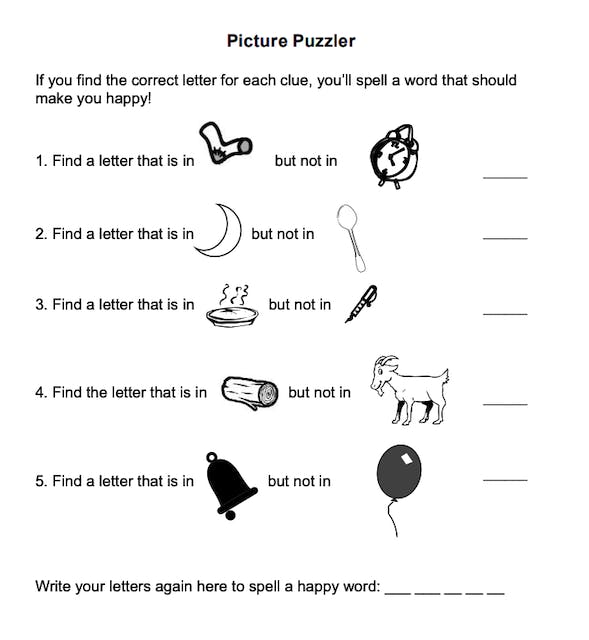
Image source: Spelling Words Well
Answer: The “happy word” is SMILE.
3. Lateral thinking problems
Lateral thinking problems require creative thinking with an indirect approach.
These questions require logic and careful thought to solve. The most notable example of a lateral thinking problem is the classic Monty Hall problem .
Here are two examples of lateral thinking problems kids can try to solve.
a) The river crossing problem
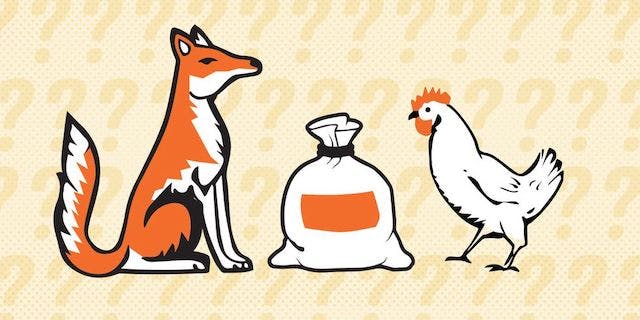
Image source: Popular Mechanics
A farmer is travelling with a fox, a goose, and a bag of beans. During his journey, he comes across a river with a boat to cross it.
The farmer can only fit one thing in the boat with him at a time. If left alone together, the fox will eat the goose or the goose will eat the beans. How does the farmer get everything across the river safely?
b) The light bulb problem

There are three light switches outside of a room-- labeled number one, number two, and number three. The door to the room is closed and you can’t see in. All three switches are off.
You need to figure out which switch belongs to which bulb. You can use the switches however you want to, but can only enter the room once. How do you do it?
a) Here’s the step-by-step solution:
- The farmer brings the goose across the river first (if he leaves the goose alone, it will either eat the beans or be eaten by the fox).
- The farmer brings either the fox or the beans across and leaves the other one alone.
- Now the farmer has two items on the other side of the river, including the goose. If he leaves the goose again, the same problem will occur. So, the farmer must bring the goose back to the other side.
- The farmer brings the other item back (either the fox or the beans) and leaves the goose alone again. The fox and the beans are now on the other side of the river.
- The farmer returns and brings the goose across the river again.
b) Turn on the first switch and leave it on. Turn on the second switch for a few minutes, and then turn it off again. When you enter the room, one light bulb will be on. You’ll know it goes with switch one because you turned it on. Another bulb will be hot. You’ll know that goes with switch two because it was on for a little while. The bulb that’s off and cold goes with switch three because you didn’t touch it.
Like math puzzles , these brain teasers for kids can increase engagement with math content and inspire your students to work on math concepts and problems outside of regular lessons.
1. Math riddles
These riddles are just as amusing as the ones above, but they’re math-focused . Use them to give students some extra math practice and encourage resourceful thinking.
Math riddles
a) Divide 30 by ½ and add 10. What’s the answer?
b) A clerk at the butcher shop is six feet tall and wears size 10 shoes. What does he weigh?
c) A farmer has 19 sheep on his land. One day, a big storm hits and all but seven run away. How many sheep does the farmer have left?
d) Your sock drawer only contains 18 white socks and 18 blue socks. How many times do you need to reach inside the drawer and take out a sock to guarantee a matching pair?
e) You planted sunflower seeds in your back garden. Every day, the number of flowers doubles. If it takes 52 days for the flowers to fill the garden, how many days would it take for them to fill half the garden?
f) Using only addition, how can you use eight eights to get the number 1,000?
g) When Ashley was 15, her mother was 37. Now, her mother is twice her age. How old is Ashley?
a) It's 70. You’re dividing 30 by ½, not by two. Thirty divided by ½ is the same thing as multiplying it by two, which is 60. Plus 10 makes 70!
b) Meat. He works at the butcher shop, so he weighs meat for a living.
c) Seven. The riddle says all but seven run away, meaning there are seven left who didn’t.
d) Three times. On the third time, you’ll get either a white or a blue sock to match with one of the other two you’ve already grabbed.
e) It would take 51 days. If the number of flowers doubles every day, half the garden would be full the day before, on the 51st day.
f) 888 +88 +8 +8 +8
g) Ashley is 22. Her mother is 22 years older, so when Ashley is 22, she’s now half her mother’s age.
2. Pattern problems
These questions require students to identify a pattern before they can answer a particular question. Kids must use creative and logical thinking to find the answers.
4 + 4 = 168
5 + 5 = 2510.
b) What makes this number unique: 8,549,176,320?
c) Solve the pattern puzzle below. Find the missing number to replace the question mark.
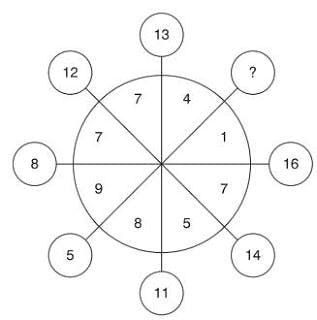
Image source: Genius Puzzles
d) Solve the following:
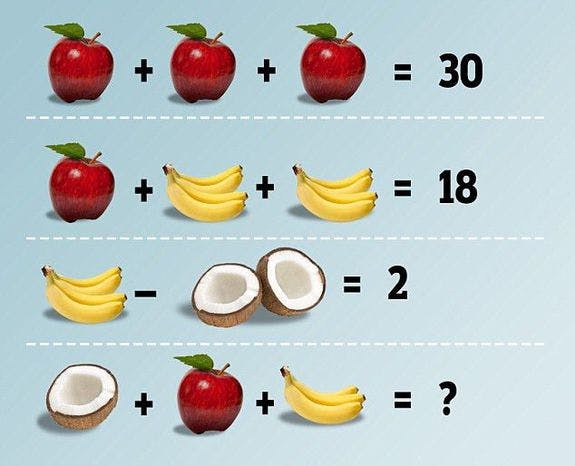
Image source: AOL
a) The missing number is 3612. The answer is the number multiplied by itself and then the number added to itself. Six multiplied by six is 36, and six plus six is 12.
b) It contains each one-digit number, zero through nine, listed in alphabetical order.
c) The missing number is 17. Each number in the circle is the sum of the numbers in the opposite quadrant. In this case, the numbers are eight and nine — added together makes 17.
d) The answer is 14 (or 16), if you’re on the other side of the debate .
3. Prodigy Math Game
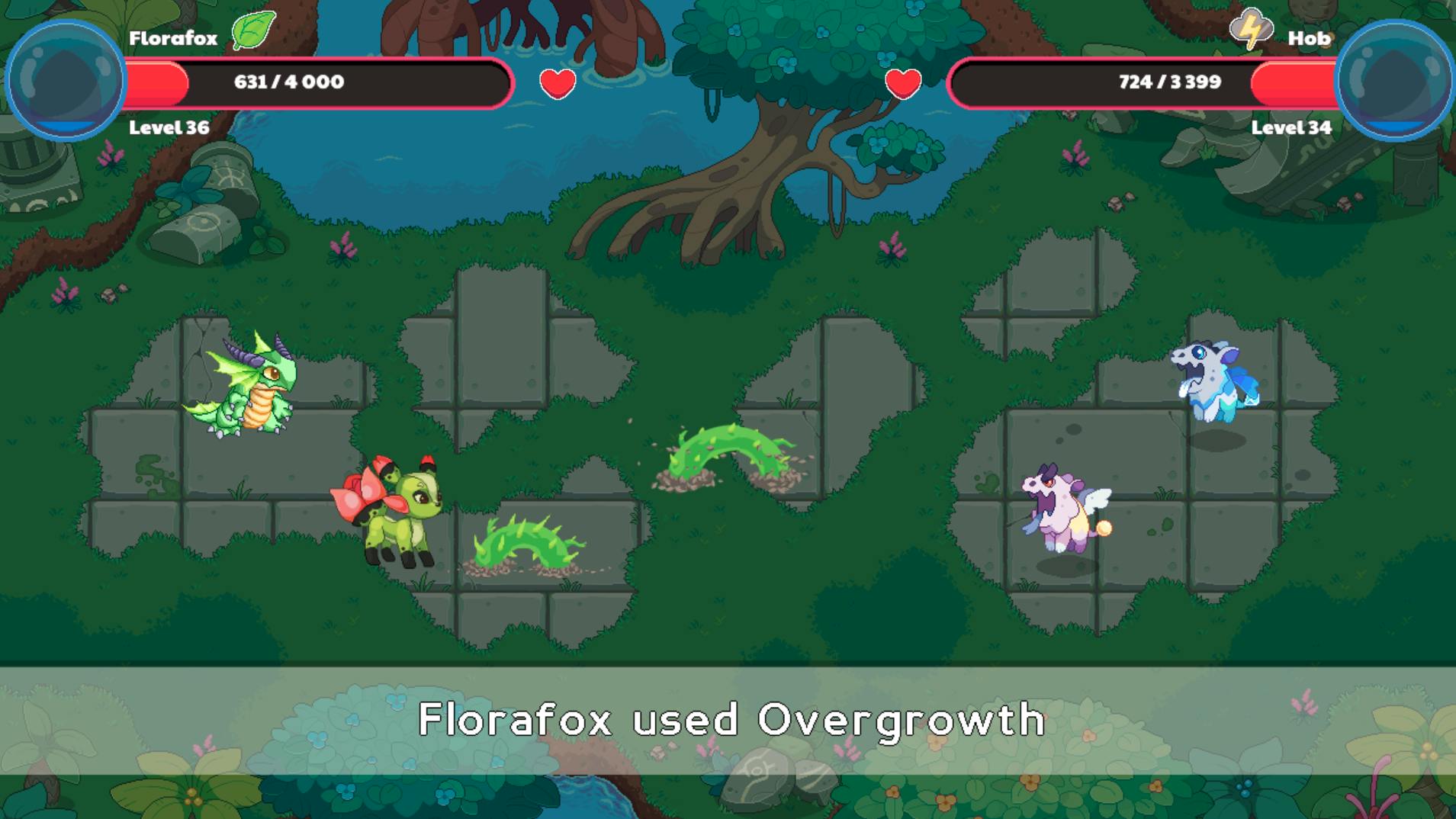
This math activity is a bit different from others on the list. It’s not a traditional brain teaser, but it can also be used as a fun, skill-building alternative to traditional math class.
Prodigy is a game-based learning platform that takes your students on an online fantasy adventure while they answer standards-aligned math questions. It’s engaging and effective at teaching necessary skills.
Prodigy's free teacher tools help you differentiate learning, send assessments in-game and even collect student insights!
Visual brain teasers for kids
1. spot the difference.
This ever-popular activity might remind you of your own childhood — and kids still love it! Spot the difference puzzles require lots of deduction and attention to detail.
Here’s an example of a printable spot the difference activity.
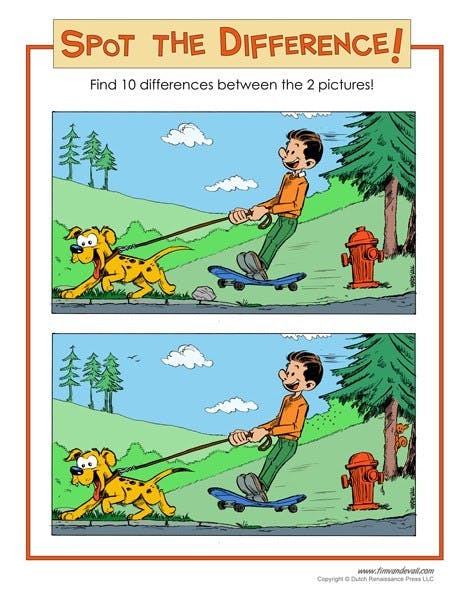
Image source: Tim’s Printables
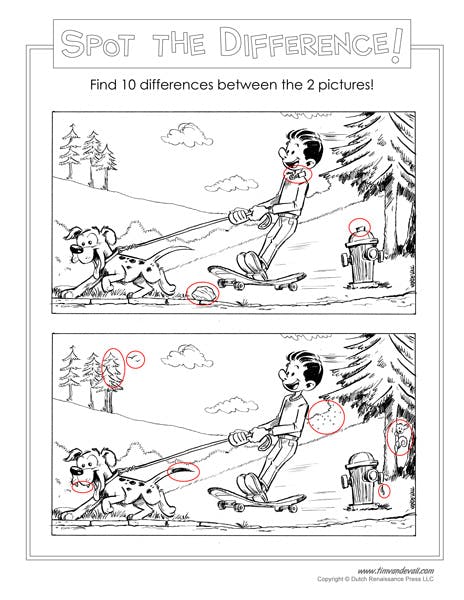
2. Rebus puzzles
A rebus is a visual word puzzle that uses lateral thinking to find its intended meaning. The word or phrase is depicted with a visual illustration, including letters and words. Students must think creatively to figure out the meaning from the clues they’re given.

Image source: Wikipedia
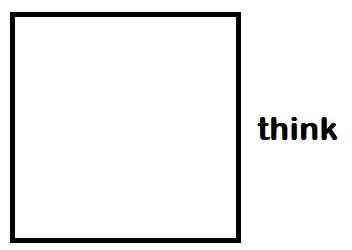
Image source: Stack Exchange
a) Top secret
b) Think outside the box
Visit the link below if you want more fun rebus puzzles for your students:
3. Optical illusions
Get tricky with your students! Optical illusions use visual tricks that alter the perception of what you’re really seeing. Students will love trying to figure out what’s really going on in these examples.
a) How many legs does the elephant have?

Image source: Optics For Kids
b) Are the two squares different colours?
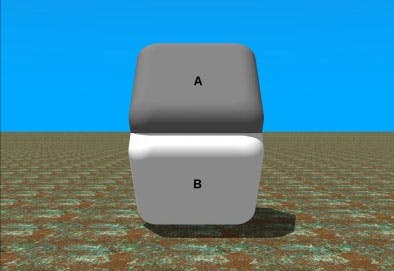
Image source: Brain Den
b) They’re exactly the same colour. If you place your finger over the spot where the squares meet, you can see they’re the same. Try this impossible paper puzzle if you want a more hands-on optical illusion. You can make one to show your class, then have students make their own as a fun brain teaser to show friends and family.
4. Stroop effect test
The Stroop effect was discovered in the 1930s by John Ridley Stroop. During the test, you’re given a list of colour names, with each word being a different colour than what they describe.
The test involves saying the colour of a word, rather than reading the word itself. Your mind must process the two conflicting pieces of information, which slows down reaction speed and requires careful thought to get through.
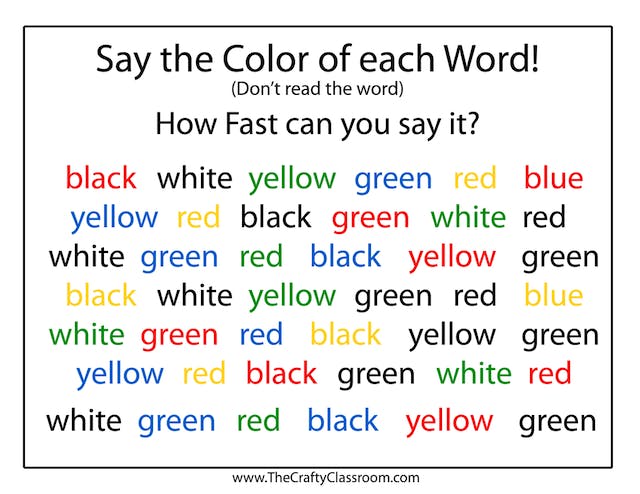
Image source: The Crafty Classroom
Benefits of brain teasers for kids
You know your students enjoy them, but did you know there are plenty of additional reasons to make brain teasers a regular activity in the classroom?
A study on the attention spans of six-year-olds found children who were given brain teasers were more attentive than those who were not — showing brain teasers were effective at boosting children’s attention spans.
Brain teasers for kids can also:
- Strengthen problem solving and critical thinking skills
- Encourage lateral thinking and build new perspectives
- Improve cognitive abilities like memory and processing speed
- Inspire teamwork and communication
- Engage students and motivate them to learn
- Provide necessary breaks from traditional class work
How to use brain teasers in the classroom
In addition to their many learning advantages, brain teasers are a great way to break up the day and engage your students. Here are just a few ways you can use brain teasers for kids as a teaching strategy and maximize the benefits in your classroom:
- Engagement-boosting activity before or after lessons
- Bonus questions in assignments and tests
- Optional “free time” activity
- Encourage team building — split students into groups to solve them together
- Supplement lessons — choose brain teasers about the subject you’re teaching
Final thoughts on brain teasers for kids
No matter what subject or skill you want to focus on, a brain teaser is a great addition to traditional teaching methods. Plus, it’s something students will actually be excited to do.
Remember that brain teaser are designed to be fun for kids. it’s not about finding the right answer, but the mental exercise they get from trying to find the solution.
Use any of the brain teasers in this list whenever you need a boost of energy in your classroom. Bonus points if you can stump any adults!
Create or log in to your free teacher account on Prodigy – a game-based learning platform for math that’s easy to use for educators and students alike. Aligned with standards across the English-speaking world, it’s used by more than a million teachers and 90 million students.
All Formats
Resource types, all resource types.
- Rating Count
- Price (Ascending)
- Price (Descending)
- Most Recent
Free problem solving resources
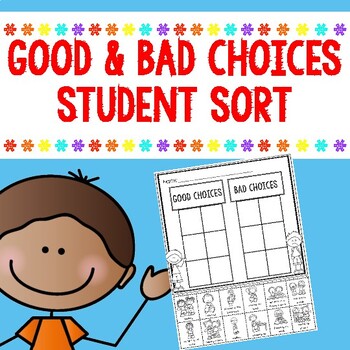
Good and Bad Choices Student Sort

Multiplication Word Problems - Arrays - Equal Groups - Multiplication Worksheet

- Google Apps™
- Internet Activities
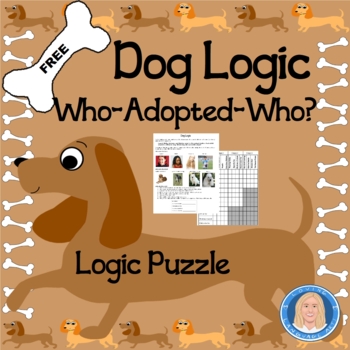
Logic Puzzle: Who Adopted Who? - Bellringer, Free Time, Critical Thinking

FREEBIE 4th Grade Math Digital Escape Room FREE

STEM Activities Rollercoaster Challenge FREE Marble Run Easy STEAM Summer Projec

FREE! Common Core Mathematical Practices Classroom Posters
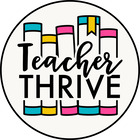
FREE Brain Teasers for Transitions Higher Level Thinking - Fast Finishers

Presidents' Day Early Finisher Activities - Crack the Code | Word Search | Maze

FREE Printable Mazes for Early Finishers Activities | 18 Mazes

FREE Math Logic Puzzles Enrichment 1st, 2nd, 3rd, 4th, 5th and 6th Grade

FREE Think Sheet for Classroom Management

5 Minutes Left and What Can I Do? : 100 Fun and Challenging Puzzles
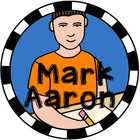
Free Smiley Face Behavior Chart for Individual Log Weekly Daily Tracker

Hands On Science STEM Investigations: Help Harry!

Free 71+ Problem Solving Scenarios Plus Graphic Organizer Distance Learning

FREEBIE PREWRITING WORKBOOK 10 pages ! Color & trace the pre-writing lines!
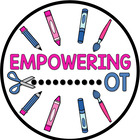
FREE Halloween Brain Break Activities and NO PREP Worksheets for October

Finding Slope and Y-Intercept from a Table

- Easel Activity

Gingerbread Man School Hunt

STEM Challenge Sticks and Cups Tower FREEBIE

Addition and Subtraction Word Problems - Regrouping - 2 and 3 Digit Numbers
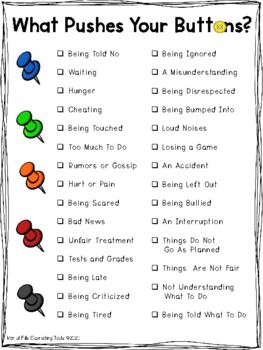
What Pushes Your Buttons: Anger Triggers
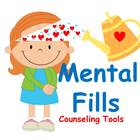
FREE Math Centers Math Tiles

FREE Giving COMPLIMENTS BOOKMARKS Affirmations Coloring Pages to Build Character

- We're hiring
- Help & FAQ
- Privacy policy
- Student privacy
- Terms of service
- Tell us what you think

Tuesday, September 22, 2020
The abcs of problem solving steps {free printable included}.
Knowing how to solve a problem is just one of many social skills kids, teens, and adults need to learn.
There are a few steps involved in problem solving so it's always good to have a visual cue that breaks down the different steps, especially for autistic and hyperlexic individuals who find visual supports particularly helpful.
And, since the alphabet is kind of our thing around here, I want to share the ABCs of problem solving with you. Well, actually it's more like the ABCDE of problem solving, but whatever, close enough.
Regardless, this is an example of how you can take your hyperlexic child's interest (letters) and use it to teach new skills (problem solving). Something I discuss here .

5 Steps to Solving a Problem
Here's how to use the ABCs of problem solving:
Step 1: Ask
This step is all about asking yourself the following questions:
- Is there a problem?
- What is the problem?
- How big is the problem?
Step 2: Brainstorm
Step 3: choose, step 4: do it, step 5: evaluate.

Download the Free Printable Problem Solving Chart
This one page printable outlines the 5 problem solving steps from above. To get a copy of this free printable, click the link below:
>> Click here to download this free printable
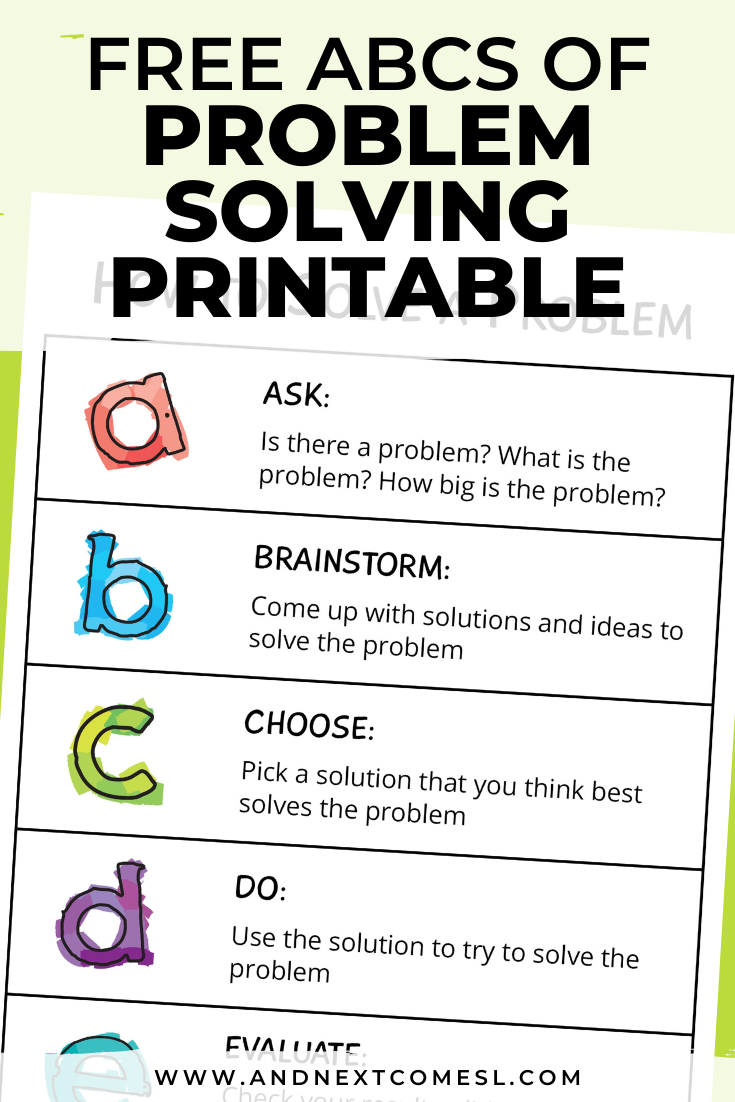
Need one-on-one support? I can help!
Quick links, get connected, where i write.

Problem Solving 101: 8 Size of the Problem Activities for Kids

If your child has a tendency to overreact to the problems he or she faces each day, these size of the problem activities for kids will help!
Whether we realize it or not, much of our day is spent problem solving. Some of the problems we encounter are of our own doing, like over-sleeping or spilling a glass of water, but many of the challenges we face are either caused by others or just plain bad luck. Our inability to control these situations can be challenging, but learning how to handle our emotions in the face of things that unexpectedly happen to us can be incredibly helpful. Learning how to identify if a problem is small, medium, or big, and then regulating our emotions to ensure our reaction matches the size of the problems presented to us helps us stay calm and strategize more effectively. Keeping our emotions and reactions in check also prevents further problems and conflicts from arising, which is an important life skill for children to learn.
‘Size of the problem’ is a social skills concept designed to help kids evaluate how big or small the problems they encounter are, and how to choose their reactions accordingly. Keep reading for more problem-solving tips and size of the problem activities for kids!
‘Size of the Problem’ 101
The problems we encounter tend to fall into 3 main buckets:
Small problems are things we can usually solve on our own, and usually only result in a small reaction (or no reaction at all). Examples of small problems include breaking a pencil, not getting to stand at the front of the line at recess, or having someone bump into you at the grocery store.
Medium problems are those that require thought and help from others (usually a parent or teacher) to solve, and they usually result in a medium-sized reaction like crying, whining, saying the word ‘ouch!’, etc. Examples of medium problems include forgetting your homework, spilling a glass of milk, having a headache, and getting into a fight with a friend.
Big problems are serious events that require help from many people, including doctors, policemen, fire fighters, etc. Big problems warrant big reactions like screaming, yelling, crying, running away, etc. Examples of big problems include being really sick, breaking a bone, getting into a car accident, a house fire, losing a loved one, etc.
A great first step in teaching size of the problem to kids is to create a visual 3-point scale together. Explain what makes a problem small, medium, or big, and the appropriate reactions for each. Help your child recall different scenarios he or she has encountered for each bucket, and discuss whether he or she reacted appropriately. This blank size of the problem template on Teachers Pay Teachers is a great tool to use for this activity, and it comes with sample problem cards to assist with your discussion.
Learning how to match our reactions to the size of our problems takes time and practice. Once your child begins to grasp the idea that different emotions and reactions are expected for different sized problems, there are tons of fantastic size of the problem activities you can use to reinforce this concept, and we’re excited to share 8 of our favourites below!
8 Size of the Problem Activities for Kids
Problem Sizes, Emotions, and Reactions Teachers Pay Teachers Designed for kids in elementary school, this comprehensive bundle helps kids understand the importance of matching their emotional reaction to the size of the problems they encounter. The activities in this set also address over-reactions and under-reactions, and can be used in small groups or as a large class lesson.
Size of the Problem Activities | Teachers Pay Teachers If you’re looking for an all-in-one size of the problem activities pack you can use in the classroom, in therapy, or at home, I highly recommend this bundle! It comes complete with posters and visuals, as well as problem and reaction scenario cards, glyph worksheets and task cards, cut and paste worksheets, and journal scenario pages.
Size of the Problem BINGO | Teachers Pay Teachers One of the best ways to teach kids is through play, and this is by far one of my favorite size of the problem activities for kids! With 20 BINGO cards included, this is a great classroom or small group activity.
Size Of The Problem Scoot Game | Teachers Pay Teachers Perfect for kids in grades 2-4, these scenarios will get kids on their feet and moving around as they practice distinguishing between small, medium, and big problems.
Size of the Problem Puzzles | Teachers Pay Teachers If you’re looking for size of the problem activities for kids in grades 3-5, this bundle comes with 2 sets of 18 puzzles in which kids match each problem scenario to the size of the problem/reaction. This is a great group activity, and encourages kids to consider their own problems and if their reactions to them are appropriate.
Size Of The Problem Google Slides & Boom Cards | Teachers Pay Teachers If you’re looking for no-prep size of the problem activities kids can complete online, this is a great bundle to consider. Students are presented with different scenarios and drag and drop them into the correct size of the problem boxes.
Interactive Emotional Regulation Worksheets | Teachers Pay Teachers If you’re looking for size of the problem activities for kids on the autism spectrum, this bundle has 2 social stories, a coloring page, a cut and paste activity, interactive worksheets, and problem situation cards.
Conflict Resolution Game | Counselor Keri If you’re looking for games you can use with your kids or students to help them practice multiple social thinking skills at one go, this is a great option to consider! This conflict resolution game helps kids practice identifying the size of the problem and corresponding emotions, using calming strategies and assertive communication, and finding positive solutions to conflicts.
If your children and/or students struggle to distinguish between small, medium, and large problems – and the appropriate reactions for each – I hope this collection of size of the problem activities and games for kids proves useful to you!
This post contains affiliate links.
If you enjoyed this collection of size of the problem activities for kids, please share this post on Pinterest!

And if you’re looking for more activities to help kids practice specific skills, please follow our Kids board where we share all kinds of great ideas we find each day!
Share this post:

7 Ways to Cope with Perimenopause Fatigue

18 Prom Hairstyle Looks & Tutorials for All Hair Lengths

7 Beautiful Spring Wedding Ideas to Inspire You

Problem Solving
Problem Solving Activities for kids – a collection of printable activities to strengthen students’ problem-solving skills. Great for Fast Finishers & Extension.
- Sort by Name
- Sort by Price
- Sort by Date
- Sort by Popularity
- Show 22 Products
- Show 44 Products
- Show 66 Products

Wall Puzzle – How Many Triangles?
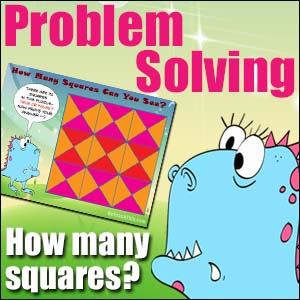
How Many Squares Are Here? The Puzzle

Problem Solving – 15 Door Puzzle

Maze or Labyrinth?

Maze or Labyrinth? Free Poster
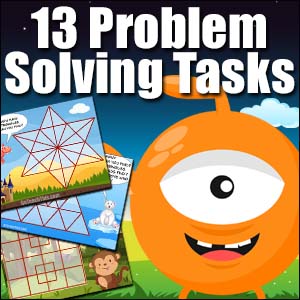
Problem Solving – 13 Puzzles

Eight in a Boat – A Classic Problem

Number Puzzles – 13 Printable Arithmagons
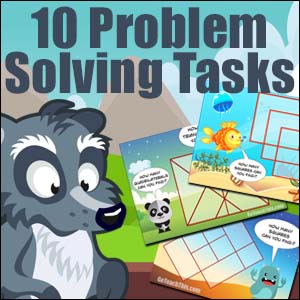
Puzzles for Problem Solving – 10 Puzzles
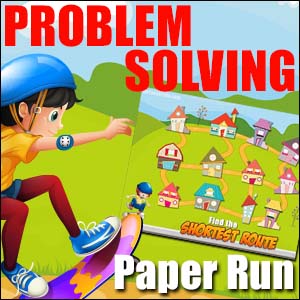
Problem Solving – Paper Run Puzzle
- Grades 6-12
- School Leaders
100 Last-Day-of-School Activities Your Students Will Love!
35 Awesome Career-Readiness Activities That Teach Soft Skills
Set kids up with the skills they’ll need to succeed in the workplace.

Our vision is to unlock the potential of each learner at every stage of life. At McGraw Hill, we believe that your diverse experiences enrich the way you learn, teach, and grow. See how Career Explorations introduces students to hundreds of diverse careers and critical soft skills needed to set them on a purposeful path through high school and beyond.
When it’s time for students to start working and/or head to college, they’ll need “soft skills,” otherwise known as career-readiness or job-readiness skills, in addition to academic knowledge and vocational skills.
Soft skills are those characteristics that help you function as an individual (motivation, self-confidence, flexibility) as well as within a group (teamwork, negotiation, respect). These job-readiness skills are key for succeeding in the workplace. After all, if you can’t show up on time, speak up for yourself, or get along with your peers, chances are you’re not going to have a very smooth go of it.
Explicitly teaching students these job-readiness skills is the best way to give them valuable insight into their strengths and weaknesses. We’ve rounded up more than 30 engaging lessons and activities that are not only just right for teaching the job-readiness skills students need, they are also a lot of fun!
1. Use an engaging curriculum for career exploration and readiness
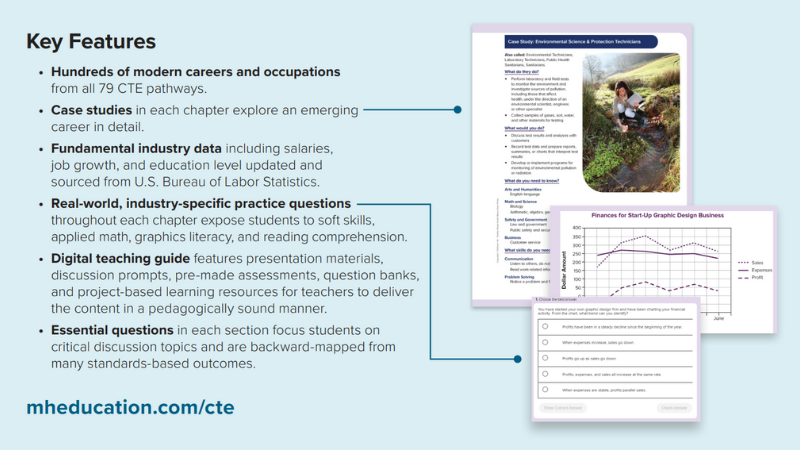
There are so many important things to teach our students before they’re ready to leave high school that it’s daunting to know where to begin. That’s why having strong, trusted resources can make such a difference. McGraw Hill’s Career Explorations program for middle and early high school is an excellent example of such a curriculum. The resources blend occupation and industry content with case studies and real-world, application-based questions and activities to grab students’ attention right from the start. And real-world, industry-specific soft-skills practice questions throughout each chapter expose students to types of challenges they’ll face regardless of what career path they pursue.
Skills they’ll practice:
Collaboration, critical thinking, problem-solving
Explore the program: McGraw Hill Career Explorations
2. Listen and recap
There are so many things competing for kids’ attention in today’s overstimulating world, so learning the simple art of listening can be a difficult task. This one-on-one communication activity will help students practice taking the time to clear their minds, focus, and really listen to what their partner is saying in a way that they can clearly and accurately repeat.
Divide students into pairs. Partner one draws a topic card from a prepared deck and talks about that topic, while partner two listens without speaking. The listener must really focus on simply receiving their partner’s words—not letting their mind wander or think about how they are going to respond. Then, without a rebuttal, partner two recaps what partner one said. Then, they switch roles.
Listening, respect, interpersonal skills, communication
Buy it: Letz Talk Conversation Cards at Amazon
3. Make a game of it
Responsibility isn’t something students develop overnight. It takes lots of practice to show self-control when things don’t go our way, to be accountable for our decisions, to finish what we start, and to keep trying even when we want to give up. Try these five super-fun games (below) that teach responsibility.
Responsibility, flexibility, patience
Learn more: 5 Great Games for Teaching Your Students About Responsibility
4. Serve others
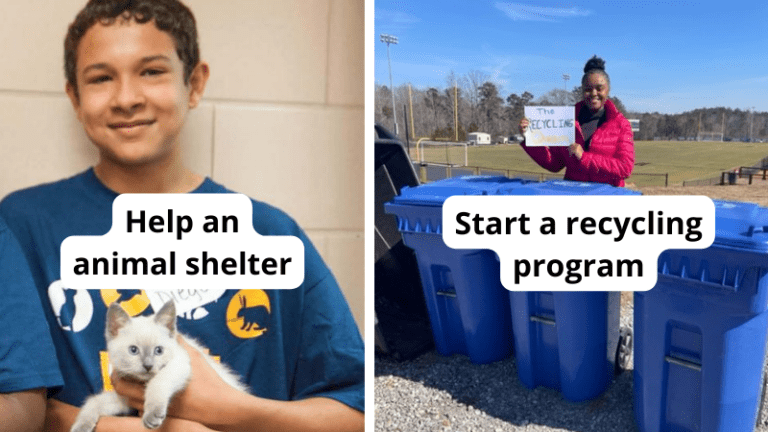
Service-learning projects not only get kids involved in their communities, they help them develop many valuable job-readiness skills that will be assets on the job one day. Team students up to organize a book or food drive, recruit bilingual students to provide translation services, or encourage budding artists to collaborate on a community art event.
Teamwork, respect, time management, responsibility
Learn more: 30 Meaningful Service Learning Projects for Kids and Teens
5. Cultivate critical thinking
Critical thinking is the ability to examine a subject and develop an informed opinion about it. It’s about asking questions, then looking closely at the answers to form conclusions that are backed by provable facts, not just “gut feelings” and opinion. And it’s definitely on the top of most employers’ wish lists for new employees. Click the link below for fun and engaging classroom activities that’ll get your students’ gears turning.
Critical thinking, problem-solving, flexibility, self-confidence
Learn more: 5 Critical Thinking Skills Every Kid Needs To Learn and How To Teach Them
6. Human Marble Run
Working together to meet a goal takes patience and focus. This IRL version of Marble Run will help your students learn job-readiness skills like working together, and they’ll have fun doing it!
Give each member of the team a length of gutter or drainpipe. The team has to transfer a tennis ball or golf ball from one place to another by rolling the ball from one piece of gutter to the next. Make it interesting by making the team get the ball to traverse an obstacle course or to go up and down stairs.
Patience, negotiation, teamwork, communication
7. No-hands cup-stacking challenge
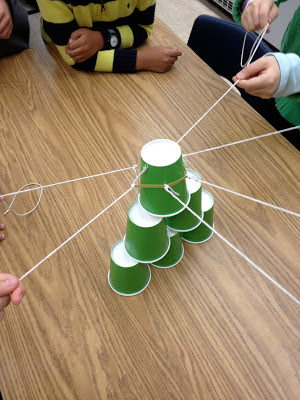
This hands-on group challenge is an exercise in learning job-readiness skills like patience and perseverance, not to mention it’s a total blast!
Decide how many students you want in each group, and tie that number of strings to a single rubber band. Each person in the group holds on to one of the strings attached to the rubber band. As a group, they use this device to pick up the cups (by pulling the rubber band apart and then bringing it back together over the cups) and place them on top of one another in order to build a pyramid.
Critical thinking, problem-solving, teamwork, patience
Learn more: Teamwork Cup Stack
8. Paper bag skits
You never know what life is going to hand to you. This is true at work, school, and in life in general. Sometimes you’re handed a set of circumstances and have very little time to figure out what to do. This fun activity will help teens practice thinking on their feet.
Fill a few paper bags with four or five assorted classroom or household items. Break the teens into groups, and assign each group a bag without showing them what’s inside. Give them two minutes to examine the items in their bag and come up with a skit, using all of the items, for the rest of the class.
Time management, teamwork, flexibility, presentation skills
9. Nurture self-knowledge
Journaling is a powerful tool for creative expression and reflection, but did you know that it can also be an effective way to improve mental health? Recording your thoughts and feelings can be a cathartic form of stress relief, an opportunity to get to know yourself better, and a way to help you feel more grounded and authentic in your beliefs. Try these free writing prompt cards with your middle and high schoolers to help them get started.
Stress management, self-confidence, motivation
Learn more: Deep Writing Prompts at Journal Buddies
10. Foster self-motivation
Self-motivation is one of the key indicators of success in the future. Conversely, lack of motivation leads to big problems not only in school but on the job later on. But how do we teach something that comes from inside? Check out the activities below for some great tips like breaking big dreams into smaller pieces, envisioning a bright future, encouraging students to share their stories, and more.
Work ethic, critical thinking, self-confidence
Learn more: How To Instill Intrinsic Motivation
11. Hold a poetry slam
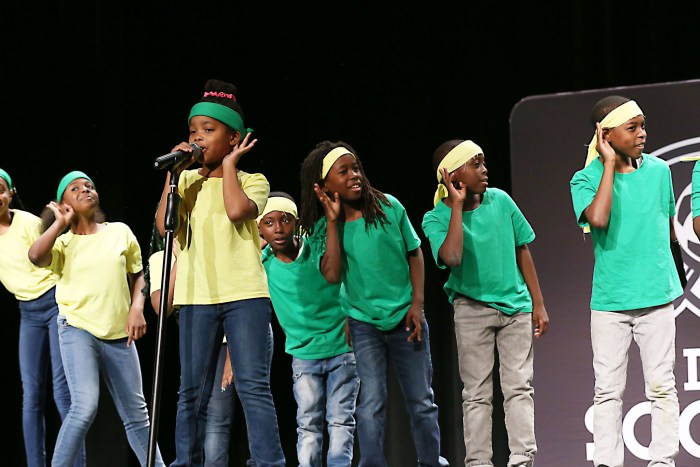
Slam poetry is a unique performance art that will not only give your students the opportunity to express their thoughts, but build their confidence as well. Slam poems are specifically written to be performed in front of an audience, and topics are often diverse, political, and thought-provoking. Finding your voice and being able to move people with your words are job-readiness skills that can apply to any future endeavor.
Self-confidence, presentation skills, teamwork
Learn more: What is slam poetry and how can teachers use it with students?
12. Team survival challenge
What would happen if your class went out on a pleasure cruise only to end up being lost at sea? Who would take charge? What materials would be essential for survival? If you ever saw an episode of the TV series Lost , you know that making these decisions as a group can get ugly fast. The Lost at Sea activity is a great lesson in group decision-making, as students will undoubtedly have different ideas about what materials to add to a limited list in a limited amount of time.
Critical thinking, negotiation, communication, teamwork
Learn more: Lost at Sea at Insight
13. Start a school garden
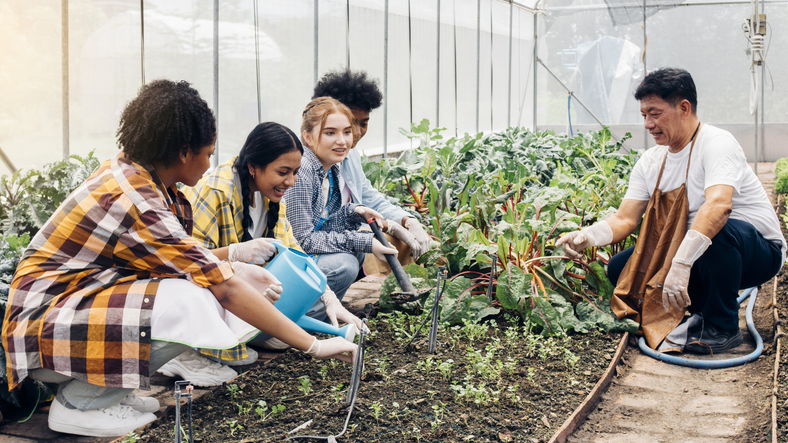
A school garden is an amazing, hands-on way to help teach students about responsibility. From planning what to grow and organizing the supplies needed to creating a maintenance schedule and actually getting down and dirty in the garden, it’s a project that requires hard work and perseverance.
Responsibility, teamwork, problem-solving, patience
Learn more: How One School Garden Transformed a Neighborhood
14. Time-management challenge
We all have days when our list of tasks is huge, and the amount of time we have to complete them just isn’t. When time is tight and your agenda is packed, you’ve got to prioritize tasks and work efficiently! This activity gives students the opportunity to practice just that by presenting them with a long list of tasks to complete in a limited time frame.
Make a list of tasks on chart paper, assigning a point value for each job. For example: Do 25 jumping jacks (5 points); make up a nickname for each member of the group (5 points); get every person in the class to sign a piece of paper (15 points); form a conga line and conga from one end of the room to the other (5 points; 10 bonus points if anyone joins you); etc. Make sure you list enough tasks to take up more than 10 minutes.
Divide your students into groups of five or six and give them 10 minutes to collect as many points as they can by deciding which tasks to perform. A debriefing session is essential with this game. Guide your students to think about how they made decisions, which group dynamics came into play, and how they determined the value of each task.
Negotiation, critical thinking, communication, time management
15. Vision boards

Unleash your students’ creativity while simultaneously helping them set goals for the future with a vision board. We don’t frequently take the time to express who we are and what we hope for. Setting aside time to contemplate can motivate teens to think deeply about what they really want in life and also fuel their desire to do what’s necessary in order to reach their dreams.
Self-confidence, motivation, critical thinking
Learn more: Why Teachers Should Create Vision Boards With Their Students at Study All Knight
16. Collaborative contract
This exercise for middle schoolers helps them establish values-based ground rules for a team. Each student takes an index card and lists three values that they believe will promote a sense of community. Team members discuss the values, consolidating them into more precise categories. They write the finalized list on a poster board, with each student signing it. Whenever there is a dispute, the team should refer to the “contract,” which holds everyone accountable.
The purpose of this exercise is to create a safe space to explore ideas by focusing on common language and shared expectations. Additionally, this activity prepares middle-school students for the workplace by emphasizing similarities rather than differences.
Negotiation, communication, listening, respect, team building
17. Zombie apocalypse
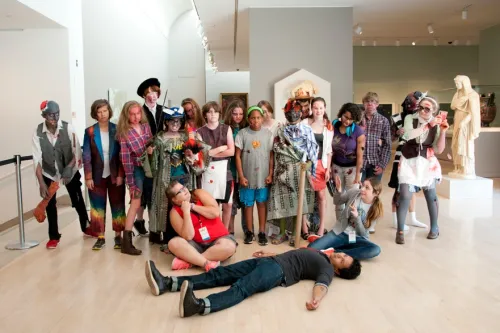
In this two-day lesson, students are required to identify soft skills, literary guides, and everyday objects that will help them survive a zombie apocalypse. They’ll work both cooperatively and independently and produce short pieces of persuasive writing to argue in favor of their survival.
Teamwork, interpersonal skills (collaboration), problem-solving
Learn more: Zombie Invasion Plan at Teachers Pay Teachers (free)
18. Stoke their competitive fire
According to teacher Christine Weis , there’s nothing like a little healthy competition in the classroom. “It motivates students and drives them to put forth their best effort,” she says. “It sparks interest, passion, and ignites a fire within.” Not only can healthy competition build confidence, it can encourage students to learn something new and develop new skills. Try games, puzzles, sports, quiz competitions, team presentations, etc., to motivate your students to reach a higher level.
Motivation, work ethic, problem-solving, self-confidence
Learn more: 7 Motivational Activities for Students from The Homeschool Resource Room
19. The blindfold game
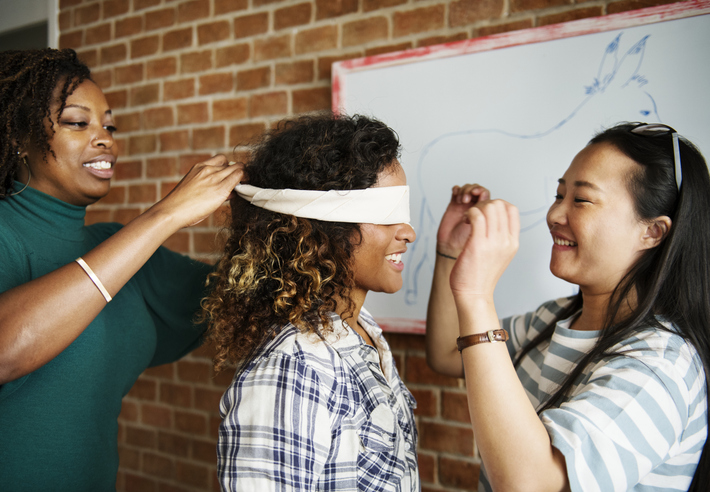
Teens leading one another around in blindfolds? Are we sure this is a good idea? The answer is yes when it’s part of a structured, purposeful job-readiness skills activity like this one!
You’ll need a large space for this activity (maybe the cafeteria after lunch or the gym during an off-period), enough blindfolds for half of the participants, and furniture and other items that you can use as obstacles (cardboard boxes, pillows, chairs, tables). Scatter furniture and objects around the room before the activity begins. Your course should be challenging but safe to navigate.
Pair students and have them line up at one end of the room. One person from each pair should put on the blindfold. The sighted person must guide their partner across the room and give them clear oral instructions (without touching them) to help them avoid the obstacles. When each team reaches the far side of the room, partners can switch roles and repeat the exercise. Have just a few pairs at a time tackle the course so that the others can observe. Take some time between rounds to process what went well, what didn’t, and what could make the challenge easier.
Communication, listening, respect (taking the task and their partner’s safety seriously), flexibility
20. Take a mini crash course
Our teens may almost look like adults, but we have to remember they still have a lot to learn. And sometimes the best way to teach them what they need to know is to just spell it out. This video is a no-nonsense tutorial about some of the job-readiness skills that employers find valuable. Hold a screening, then after the video, have students form breakout groups to talk about what portion of the video they found most helpful and what they need to work on.
Communication, listening, critical thinking
21. Human knot
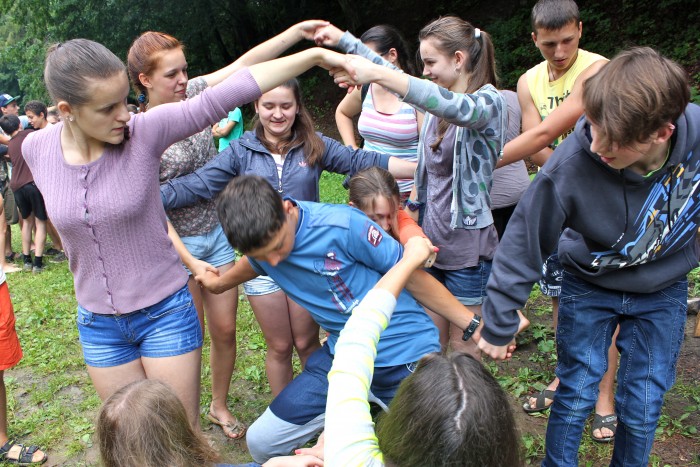
Nothing promotes job-readiness skills such as cooperation like getting all tangled up with your classmates — literally!
Players stand in a circle and reach out to shake hands with other players, with each hand holding that of a different person, creating a “human knot.” Then the players have to figure out how to untangle their bodies without letting go of each other’s hands. This activity lends itself to a vibrant debriefing session as students observe their communication and cooperation skills.
Teamwork, communication, problem-solving
Learn more: The Human Knot Game
22. Mind your mental health
Managing stress in school (and on the job) is a timely subject. With mental health issues on the rise across the country, it’s critical to teach your students strategies that will help them stay grounded and build resilience. After all, it’s hard to do your best in any endeavor when you’re stressed to the max. Try the empowering activities below to teach students how to manage stress so they can succeed in college, on the job, and in the future.
Self-confidence, problem-solving, leadership
Learn more: 26 Empowering Mental Health Activities for Teens
23. Rope Circle Shimmy

Divide teens into two groups. Each group should have a minimum of five members. To begin play, make a big circle out of rope for each team and put it on the floor. Each member of the team stands at the edges of the circle, so the rope is taut around their ankles, while holding their hands in the air.
Team members must take turns moving to work the rope up from ankles to wrists, keeping hands in the air at all times. The team member will have to wiggle and move to slide the rope up. Other team members can help by keeping the rope as taut as possible. The team that finishes the challenge first wins!
Communication, flexibility, interpersonal skills (cooperation)
Learn more: Looped to Rope
24. Four-card negotiation
Sometimes to get ahead in life, you have to know how to wheel and deal. That’s what this lesson is all about. The objective is for teams to trade and barter for pieces of cards to match up with the pieces they already have and ultimately end up with four complete playing cards.
Start with a pile of playing cards (four cards per team of four or five students). Cut each card diagonally into four pieces and mix all of the pieces together. Now divide the mixed-up pieces evenly among the teams. Give teams a couple of minutes to sort out their card pieces and figure out which pieces they have and which pieces are missing. Set a timer for 10 minutes. The goal of the game is for the students to use their negotiation skills with the other teams in order to gain as many complete cards as possible for their team. At the end of 10 minutes, the team with the most cards wins.
Negotiation, communication, interpersonal skills
25. Pair up with younger kids
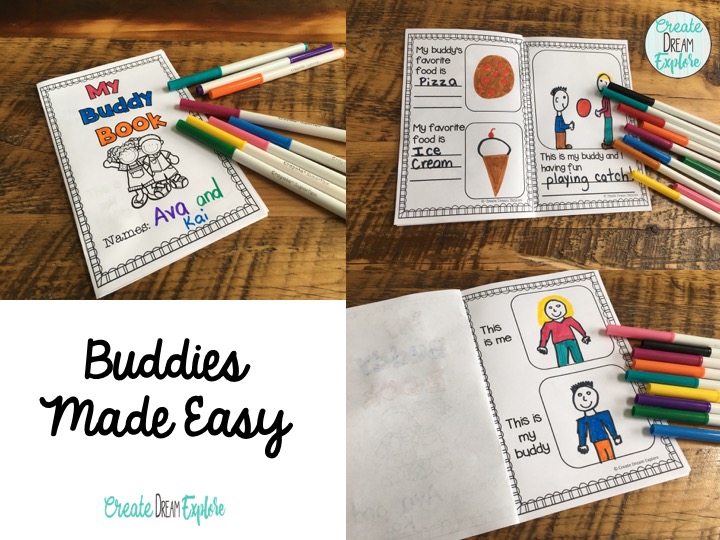
Nothing helps teens build responsibility like pairing up with a younger buddy. Being the more mature, more experienced partner in the relationship gives teens the opportunity to share what they know and learn to be a leader. Have your students plan fun activities and special events with their buddies.
Responsibility, leadership, problem-solving, listening, patience
Learn more: 20 Activities To Do With Reading Buddies or Big/Little Buddy Time
26. Blind spelling practice
Weaving soft-skills activities into everyday curriculum is a win for everyone. Enhance your students’ interpersonal skills with this fun spelling activity. Tape letters to each student’s back. Then call out a definition of a word. Students will need to work together to assemble in the right order to spell the word correctly.
Communication, listening, negotiation, problem-solving
Learn more: Manuel Antonio Noronha
27. Practice small talk

Teenagers aren’t exactly known for their chitchat skills. In fact, for many it is one of the most awkward situations they can imagine being put in. But small talk is considered a foundational job-readiness skill that is important for almost every job, as well as learning to network. Many teens feel awkward speaking with people they’re not used to speaking to and need practice, especially with adults. Try some free conversation starters that will help them practice the “three P’s” of small talk: being polite, positive, and professional.
Communication, listening, self-confidence, patience, respect
Learn more: Conversation Starters on the Job at Realityworks
28. Blind drawing
Try this hilarious activity with your teens. It’s kind of like “telephone” but instead of listening, each person must pay close attention to what is being drawn on their back. Each student in the line gets a blank sheet of paper taped to their back and a marker. The student at the end begins by slowly drawing an image on the person’s paper in front of them. When that person feels what’s being drawn, they try to re-create what they’re feeling on the person of front of them. When the image is complete, have the students take off their papers and compare the results. This activity is a colorful reminder that people often perceive things very differently, so communication is extremely important!
Communication, teamwork, patience
29. Mock interviews

The prospect of going on a job interview can be terrifying to a kid who’s never had a job before. Practicing job-readiness skills like interviewing can help them reduce the fear factor and build their confidence. Pair students up and assign one teen the role of interviewer and one the role of interviewee. Use a set of job interview questions to practice with.
Give each pair 15 minutes, then have them talk about how the interview went. The interviewer may have some valuable insight for the interviewee. Then have the partners switch roles and repeat. After they’ve had practice with their peers, invite a few adults into the room to conduct mock interviews.
Interview skills, critical thinking, self-confidence
Learn more: Job Interview Questions for Teens at Understood
30. Group storytelling
Create small groups of three to eight students. The first person makes up the first line of a story and says it out loud. The second person says, “Yes, and …,” continuing the story. Play continues around the group until everyone has contributed or until the story has come to a satisfactory ending. Since students don’t know what’s coming, they have to learn how to listen carefully and react and communicate well on the fly. As an alternative, to have students listen even more carefully, have them continue the story with the phrase “because …”
Communication, listening, critical thinking, presentation
Learn more: 4 Soft Skills Training Activities at Unboxed Training and Technology
31. Team pen
Sometimes it takes the whole team to produce results. This fun game involves a marker with four to six strings tied to it and a blank piece of paper. The teacher calls out a word and the team has to work together to legibly print the word on the paper. Students will have to think carefully and cooperate with one another to maneuver the pen correctly to write the word.
Communication, teamwork, patience, critical thinking
32. Hold group brainstorming activities
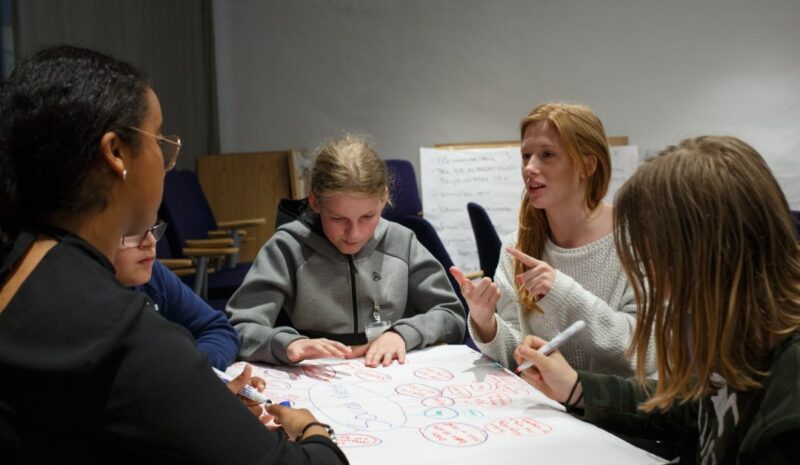
When you assign a project (individual or group), instead of laying out all the options, gather students into small groups to brainstorm topics, strategies, and procedures. When they decide the parameters of their work, they will be more invested in the outcome.
Teamwork, work ethic, communication skills, critical mindset
Learn more: Soft Skills Activities for High School Students
33. Encourage peer review
As often as possible, allow students to both give and receive feedback from classmates on their work. Of course, receiving (and giving) constructive feedback may feel uncomfortable at first. But as the practice becomes part of their regular routine, students will learn the value not only in the classroom but also, one day, on the job.
Critical thinking, confidence, communication
Learn more: 7 Soft Skills for High School Students at College Transitions
34. Play games

Oftentimes teens learn best when they are at play, especially if the chosen activity is especially engaging and fun. There are oodles of games (see link below) that foster trust and establish a safe place for learning. In addition, teens actually enjoy a break from the mundane and time to “play games” instead of work, work, work all the time.
Communication, team building, conflict resolution, problem-solving, collaboration
Learn more: 25 Games To Help Teens Learn Social Skills at A Day in Our Shoes
35. Practice with concentric circles
Choose a discussion topic ahead of time. Set up two concentric circles of chairs. Participants in the center circle sit as “talkers,” while those in the outer ring sit as “watchers.” For the first round, talkers address the topic while the listeners take notes. For the second round, students change places and roles.
Collaboration, listening skills, speaking skills, focus
Learn more: 10 Best Soft Skills Games for Efficient Training at Outsource Accelerator
Be sure to visit McGraw Hill’s Career Explorations page for more information about their career and technical education resources for middle and high school.
If you liked these activities that teach job-readiness skills, check out these “would you rather” questions to get teens thinking about their future careers..

You Might Also Like
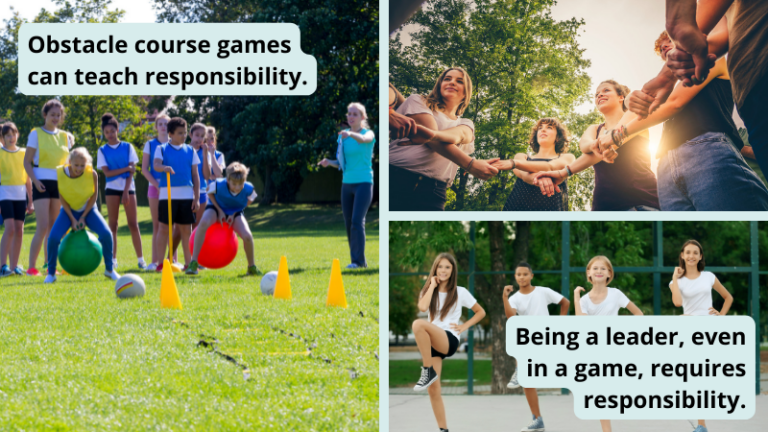
5 Great Games for Teaching Your Students About Responsibility
Your students will have fun becoming more responsible young people. Continue Reading
Copyright © 2024. All rights reserved. 5335 Gate Parkway, Jacksonville, FL 32256

IMAGES
VIDEO
COMMENTS
By honing their problem-solving abilities, we're preparing kids to face the unforeseen challenges of the world outside. Enhances Cognitive Growth: Otherwise known as cognitive development. Problem-solving isn't just about finding solutions. It's about thinking critically, analyzing situations, and making decisions.
Problem-solving activities for kids: Explore 24 fun problem-solving games and activities, and learn effective tips and strategies to teach kids problem-solving skills.If you want to explore problem-solving strategies more in-depth, you can also grab our workbook "Problem-Solving for Kids" (printable resource).. Problem-solving is the cognitive process of finding solutions to challenges or ...
Conflict Resolution Worksheets. 1. Social Problem Solving Worksheet. Conflict resolution is, in essence, a social problem-solving situation. In this worksheet, we will follow the steps for problem-solving, with an important addition (calm-down): Calm down so that you can deal with the conflict; What is the problem/conflict; Listen to the other side
Playing Memory is a fun way for your child to develop memory, focus and turn-taking skills. Try this Halloween version for seasonal fun. Help your child develop logic and problem-solving skills with our free printables, suitable for preschoolers on up. From simple coloring activities to matching, mazes and puzzles, you'll find many ways to ...
4. The Penny Drop Challenge. This activity was selected because it requires kids to think about physics and how different materials affect sound. To do this activity, you will need a penny ( or another coin), a cup, and various materials such as paper towels, cotton balls, etc.
Here's a brand new set of worksheets to teach critical math skills: printable logic puzzles for kids! There are 9 puzzles varying from easy to intermediate to difficult. Each worksheet already has a data grid drawn out for kids to practice their deductive reasoning skills. They all also have an answer key - I was never very good at logic ...
15 Best Problem Solving Activities for Kids. 1. Rolling Dice. Things you'll need: A die or dice, some flashcards and a pen. How to do: You can play tons of different games with dice. Playing with two dice encourages kids to quickly add up numbers and learn math in a fun way.
Line Leader Logic Puzzle With Grid. The 5-by-5 grid with the line leader logic puzzle makes it more challenging and ideal for upper elementary students. Kids will have to figure out what order the children are standing in as they wait for ice cream using only four clues. Use the included solution to check your answer.
All lines of work need great problem solvers to find tomorrow's solutions, and students of any age can be honing their problem-solving skills. Check out some of these fun problem-solving activities for kids and teens below! Problem-solving activities for elementary school kids (ages 5-10) From traditional paper-and-pencil activities to online ...
Explore engaging problem-solving practice worksheets for kids. Enhance logical thinking and learning skills with fun, printable activities at Kids Academy. Toggle navigation Go Ad-Free Worksheets. Grades. Preschool Kindergarten Grade 1 Grade 2 Grade 3. Difficulty Levels.
6) Quirkle Board Game. If you're looking for problem solving activities for kids you can enjoy as a family, I highly recommend Quirkle! It's easy to play but definitely puts players' problem solving skills to the test, and I love that it's a game the whole family can enjoy! 7) Size of the Problem Activity Pack.
Tailoring Problem-Solving Worksheets for Different Subjects Mathematics. Math problem-solving worksheets can be a playground for nurturing critical thinking. Through word problem worksheets, students not only practice calculations but also apply math concepts to real-world scenarios. Science. Scientific problem-solving worksheets ignite curiosity.
422 filtered results. Problem-Solving Skills Worksheets provide an effective and engaging way for individuals to develop and enhance their problem-solving abilities. These worksheets offer a structured approach to solving problems, equipping individuals with a toolkit of strategies and techniques to tackle any challenge they may encounter.
Over 30 years ago, ThinkFun had one mission - to spark creativity, build problem-solving skills and inspire learning through play for children around the world. Today, our passion is even stronger. That's why we offer free and fun downloadable logic games and brainteasers for every classroom, every teacher and every student.
Puzzles and brain teasers are fun ways to boost kids' problem-solving skills. These challenges can be jigsaw puzzles, tricky riddles, or math puzzles, all designed to make kids think critically and creatively. By solving them, kids learn to break down problems, be persistent, and find different solutions. Jigsaw puzzles, Sudoku, Rubik's ...
©2020 Great Kids, Inc. 1.800.906.5581 www.greatkidsinc.org Simple Problem-Solving Activities for Children Children learn so much through their everyday play - many life lessons, too…While it sometimes feels easiest for us as parents to rush in when our children are challenged, allowing them to solve things for themselves can build their problem-solving skills.
Encourage your child to plan their day or week, balancing schoolwork, chores, and leisure. This helps them develop critical time management and prioritization skills. Each of these activities, while mundane, is an opportunity for your child to think critically, make decisions, and solve problems.
For this problem solving activity for older kids or teens, you will need four 2×6 boards. Divide your group into two teams with an equal number of children on each team. Place two of the four boards end to end on the ground or floor. Set the other two parallel to the first two about two or three feet apart.
3. Lateral thinking problems. Lateral thinking problems require creative thinking with an indirect approach. These questions require logic and careful thought to solve. The most notable example of a lateral thinking problem is the classic Monty Hall problem. Here are two examples of lateral thinking problems kids can try to solve.
Get the full version:Multiplication Word Problems - Equal Groups - Arrays This resource includes 2 multiplication word problems (1 digit X 1 digit). Each problem requires students to write an equation, a repeated addition, and a solution sentence. In addition, the students will represent the problems with equal groups or arrays.
Knowing how to solve a problem is just one of many social skills kids, teens, and adults need to learn.. There are a few steps involved in problem solving so it's always good to have a visual cue that breaks down the different steps, especially for autistic and hyperlexic individuals who find visual supports particularly helpful.
A great first step in teaching size of the problem to kids is to create a visual 3-point scale together. Explain what makes a problem small, medium, or big, and the appropriate reactions for each. Help your child recall different scenarios he or she has encountered for each bucket, and discuss whether he or she reacted appropriately.
Fun hands-on STEM activities (science, technology, engineering, and math) activities for kids of all ages.
Problem Solving - Paper Run Puzzle. $ 2.20. Problem Solving Activities for kids - printable activities to strengthen students' problem-solving skills. Great Fast Finisher & Extension Ideas.
Communication, team building, conflict resolution, problem-solving, collaboration. Learn more: 25 Games To Help Teens Learn Social Skills at A Day in Our Shoes. 35. Practice with concentric circles. Choose a discussion topic ahead of time. Set up two concentric circles of chairs.
MSN